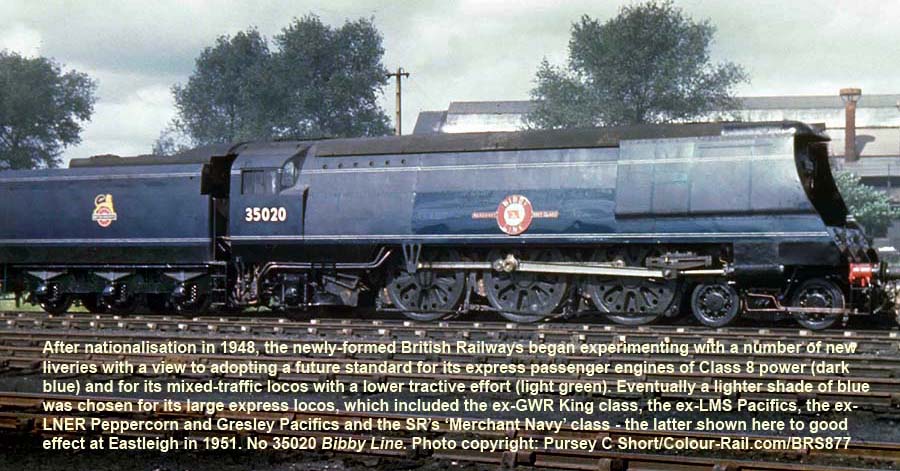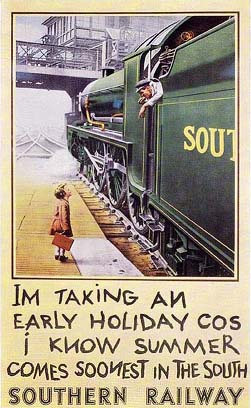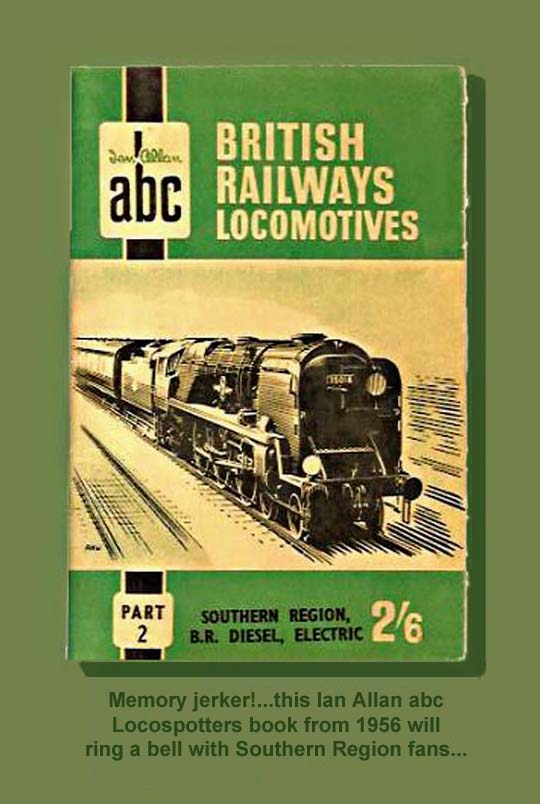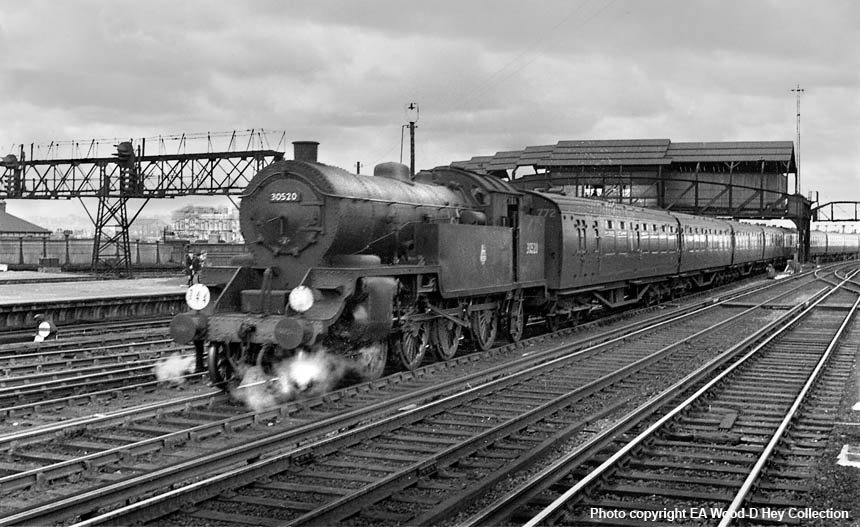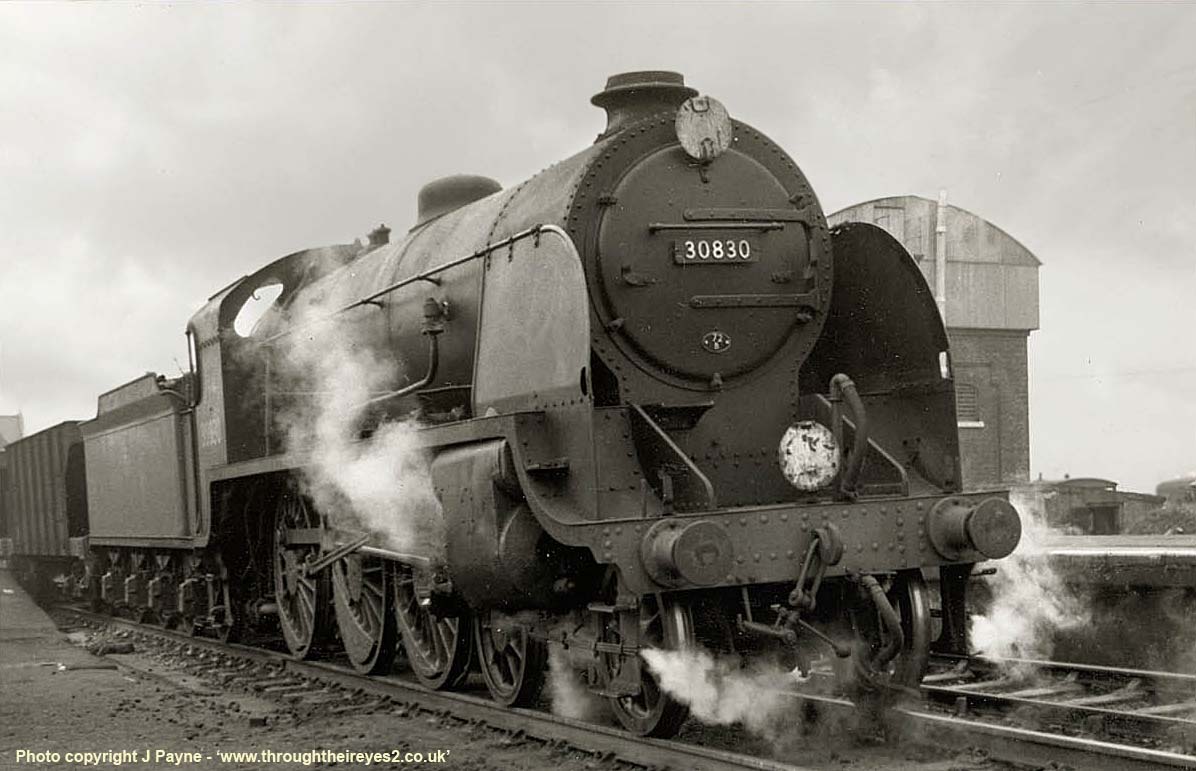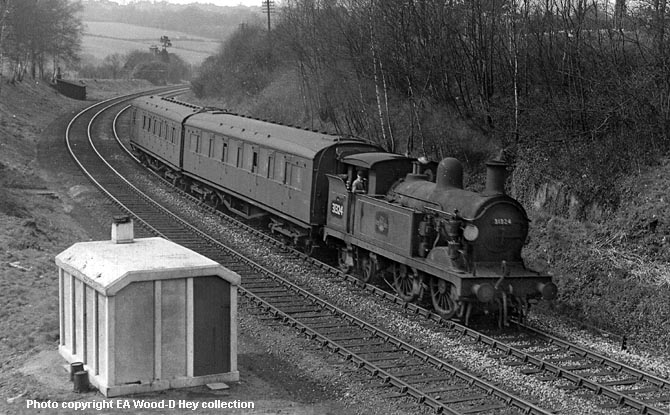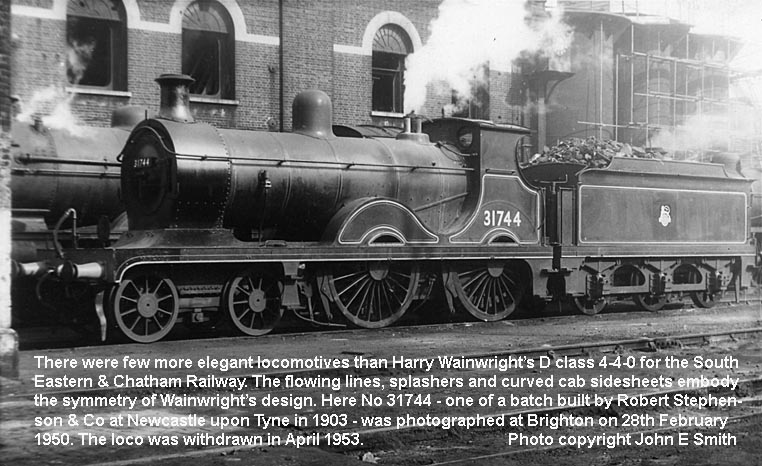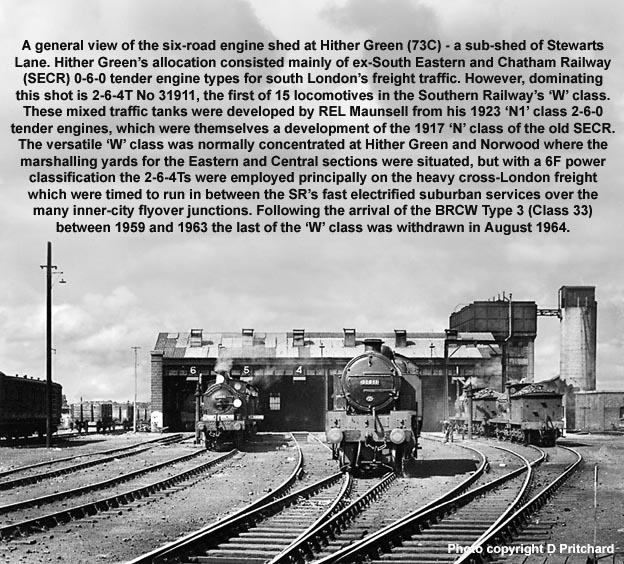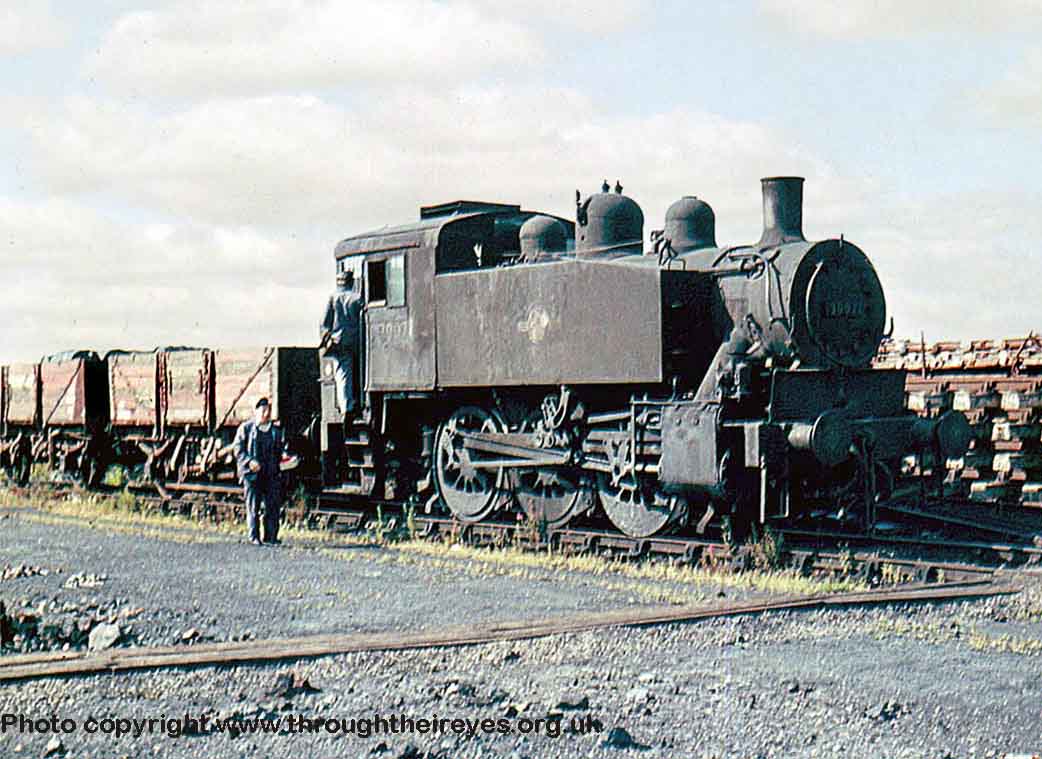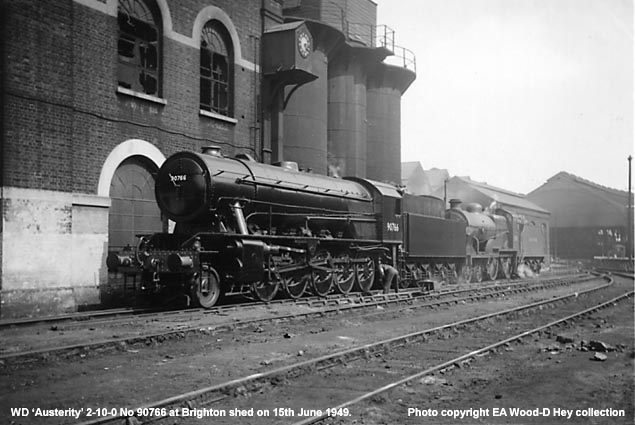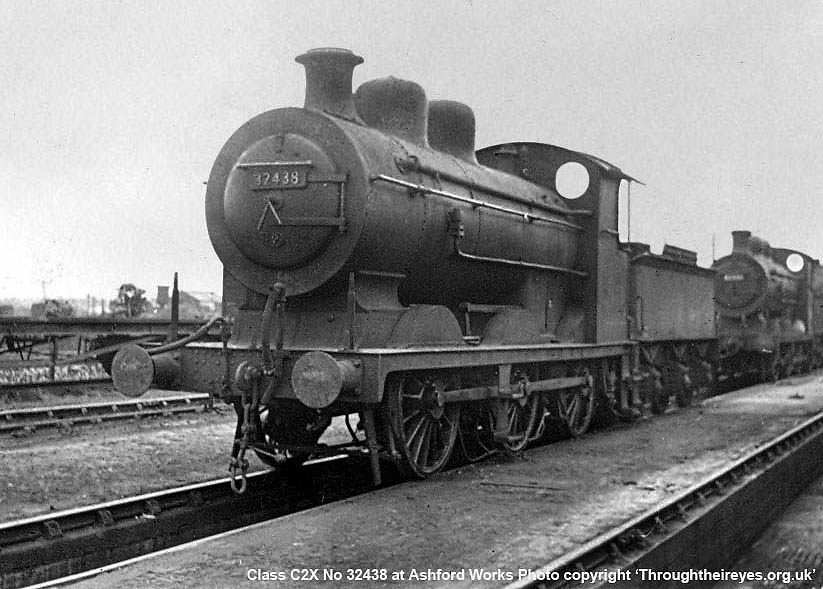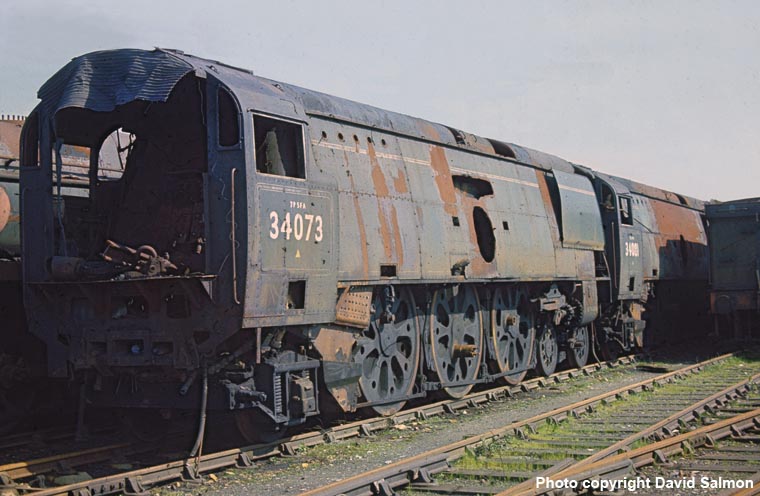EDITED BY DAVID HEY
On January 1st 1948, the former 'Big Four' railway companies: London North Eastern Railway (LNER); London Midland & Scottish Railway (LMSR); Great Western Railway (GWR) and Southern Railway (SR) were amalgamated to form the new British Railways. A total of 20,211 steam locomotives were taken into State ownership consisting of: 1,838 from the SR, 3,856 from the GWR, 6,525 from the LNER, and 7,805 from the LMSR. The rest was made up of service engines and Departmental locomotives.
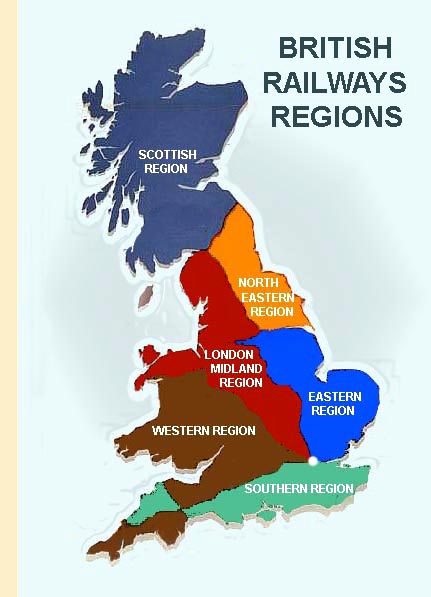 (Above) Iconic images of the SR: the 1925 poster appeared all over the SR system; the enterprising Ian Allan published a series of abc spotting books that changed countless thousands of youngsters lives for ever!
(Above) Iconic images of the SR: the 1925 poster appeared all over the SR system; the enterprising Ian Allan published a series of abc spotting books that changed countless thousands of youngsters lives for ever!
(Below) With smoke curling out from its chimney and safety valve blowing, Rebuilt Battle of Britain Class 34060 '25 Squadron' suffers a signal check at Clandon whilst working a Waterloo - Bournemouth special working. The train was probably re-routed via Cobham and Guildford (New-Line) because of engineering works caused by the Bournemouth Electrification Scheme circa 1966. After taking water at Guildford, the train would have continued its journey to Bournemouth via Havant and Fareham rejoining the main line at St Denys before continuing its journey to Southampton and Bournemouth.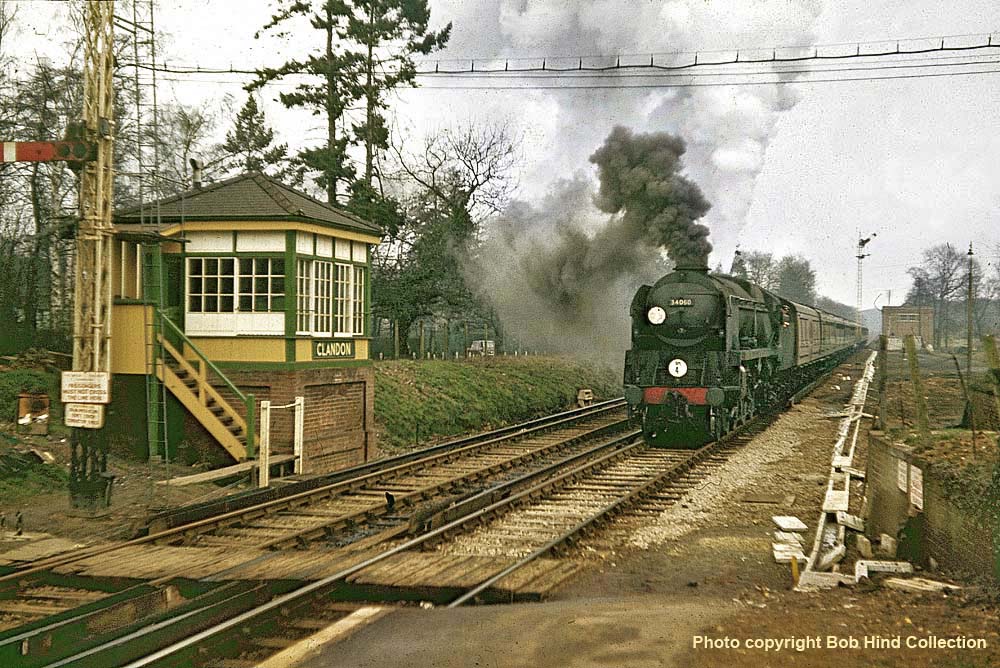
(Below) A super-wide view from the carriage window...during his reconnaissance with a camera in the south of England in 1961, Richard Greenwood caught a train from Exeter back to his base in Guildford on 9th July; this shot shows the view passing Exmouth Junction shed on the former LSWR's West of England Main Line to London. Exmouth Junction was for many years the location of the LSWR's largest engine shed and the company's concrete casting factory. Following Grouping in 1923, the shed was rebuilt by the Southern Railway and at its peak had an allocation of over 120 locomotives. Following nationalisation in 1948 it was given the shed code 72A. In 1963 it was transferred to the Western Region and re-coded 83D, but two years later it was closed to steam; a number of diesels were allocated there from June 1965 until final closure on 6 March 1967. Check out Richard's 'Down South in Colour' page 87 (over 180 colour shots) HERE...highly recommended.. 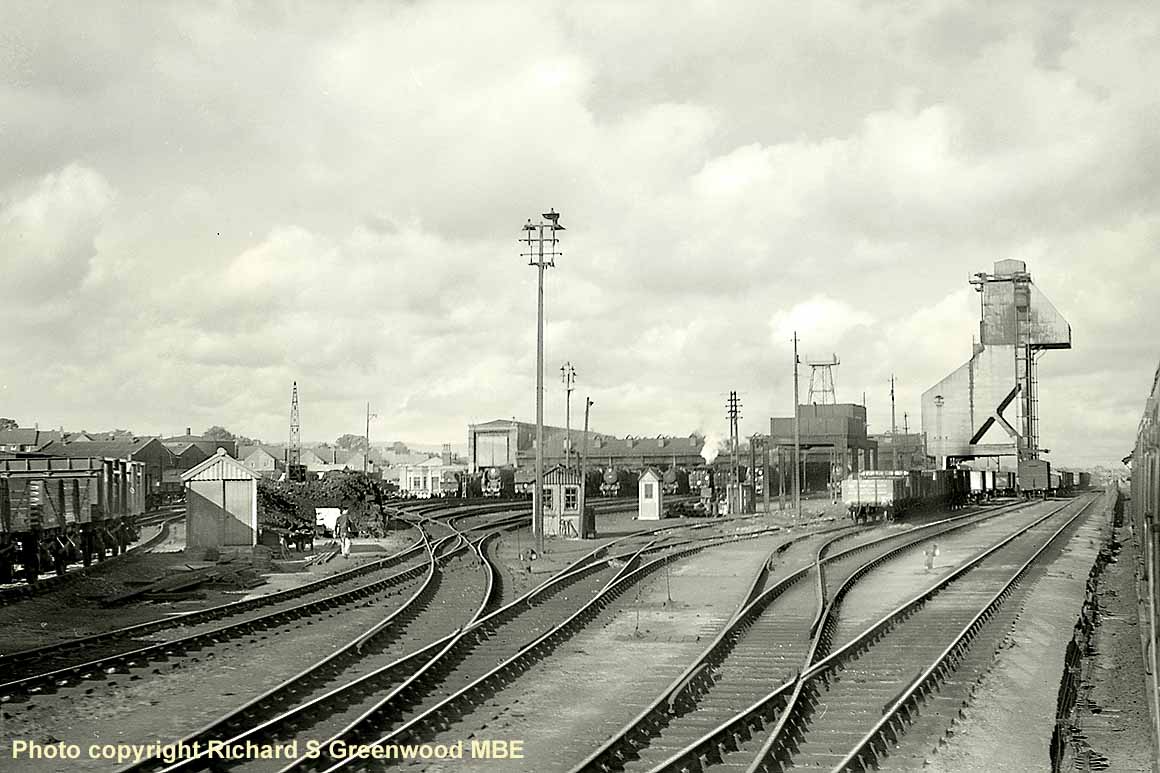

(Above) Another super-wide view from the carriage window as the train passes Seaton Junction on 9th July 1961. Opened in 1868, the branch serving the seaside resort of Seaton became a popular venue with holidaymakers, but with increased car ownership during the 1960s, holiday traffic to the resort declined and this led to a gradual run down of rail services and eventual closure of both the branch and junction in March 1966. The line was originally worked by Beattie 2-2-2 Well Tanks, followed by O2 and T1 Class 0-4-4Ts, occasionally supported by an Adams radial 4-4-2Ts. From 1930 onwards auto train operation began on the branch, with M7 0-4-4 tank engines dominating the service; an M7 can be seen on the right occupying the curved branch line platform; the platform was created by the Southern Railway after it took over the LSWR at Grouping. On summer Saturdays the branch handled a considerable amount of holiday traffic, with two locomotives operating through trains from London, however this service ceased in 1962 when diesel multiple units were introduced in November 1963. Full closure of the branch followed three years later.
(Above-Below) HELP! I have recently been contact by Nic Greene, a volunteer at the Watercress Line, who is in the process of making a short video to promote awareness of, and hopefully raise funds towards, the overhaul of Merchant Navy No 35005 Canadian Pacific and he is desperately trying to find 30-plus seconds of mainline footage of Merchant Navy locos, in particular 35005, from the 1950-60 period. If anyone has any footage or ideas for sources he would be very pleased to receive them. If you can help Nic (who goes by the name of 'geralldus' on YouTube) he can be contacted at n.greene@blueyonder.co.uk Please note this is not a clickable link via Outlook Express; you will have to email manually. Many thanks in anticipation… 
(Below) Prior to nationalisation, the Southern Railway was the most progressive of all the four main railway companies, having invested heavily in 3rd rail electrification during the 1930s. Electrification of the former London & South Western Railway suburban services began in 1925 and was operated by two 3-car power units with non-driving trailer coaches between. This inflexible arrangement was eliminated when the SR began reforming the former LSWR units into four-car sets, though full-scale implementation of this conversion could not take place until after the Second World War when new steel trailer coaches were built to convert existing 3-car sets into four-car. The numbers were carried on front and rear of each set. No 4535 was photographed near Dorking on March 4th 1956.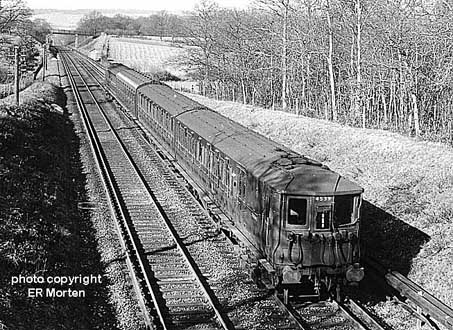
BOB HIND's SOUTHERN RAILWAY PHOTO ARCHIVE
(Above-Inset) Introduced in January 1914, Urie's LSWR H15 class mixed-traffic 4-6-0s formed the basis of a powerful new express passenger locomotive capable of handling the increased train loads on the LSWR route to the West Country. The result was Urie's N15 class, which, despite incorporated many features from his earlier H15 class (both had flat-sided Drummond-style cabs with gently curving roofs, high running 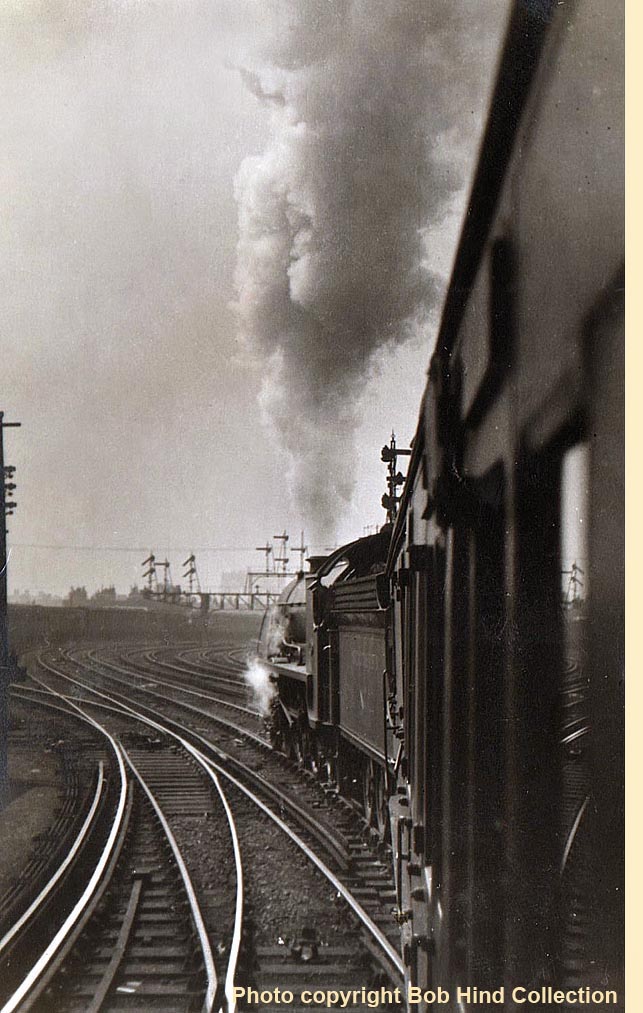 plates for ease of maintenance and eight-wheel double bogie tenders) the N15s most distinctive features included larger 6 ft 7ins driving wheels, increased sized cylinders and the tapered boiler was very different from the H15's parallel type.
plates for ease of maintenance and eight-wheel double bogie tenders) the N15s most distinctive features included larger 6 ft 7ins driving wheels, increased sized cylinders and the tapered boiler was very different from the H15's parallel type.
The first 20 locomotives built at Eastleigh Works became known as the 'Urie N15s', and were constructed in two batches of ten engines between 1918 and 1923. Whilst the double bogie tenders were similar in appearance, the N15s tenders were strengthened to hold 5,000 imperial gallons of water for the London-West of England service.
A second batch of ten N15s was built between June 1922 and March 1923 to cope with the intensified timetable to the West Country. Following Grouping in January 1923, the LSWR became part of the new Southern Railway, and the Chief Mechanical Engineer, REL Maunsell, rebuilt the former Drummond G14 and P14 4-6-0s to Maunsell's N15 specification.
It was decided to name the N15 class after characters and places from Arthurian legend, and the first G14 to be rebuilt was given the first name King Arthur. The Urie locomotives were also given names connected with Arthurian legend and thereafter they were referred to as 'Urie Arthurs', whereas the Maunsell batches of N15s were nicknamed the 'Eastleigh' and 'Scotch Arthurs' - the latter so named because Maunsell placed an order for twenty N15s to be constructed by the North British Loco Company in Glasgow due to a lack of production capacity at Eastleigh which was busy with repair and overhaul work.
(Above) The doyen of the Class N15 4-6-0s, No 453 King Arthur, passes Pilbright Junction with a train from Waterloo to the West of England in August 1935. (Inset) This shot of Class N15 4-6-0 No 450 Sir Kay was taken from the carriage window of the 11am Sunday passenger train departing from Waterloo for Bournemouth Central in 1931.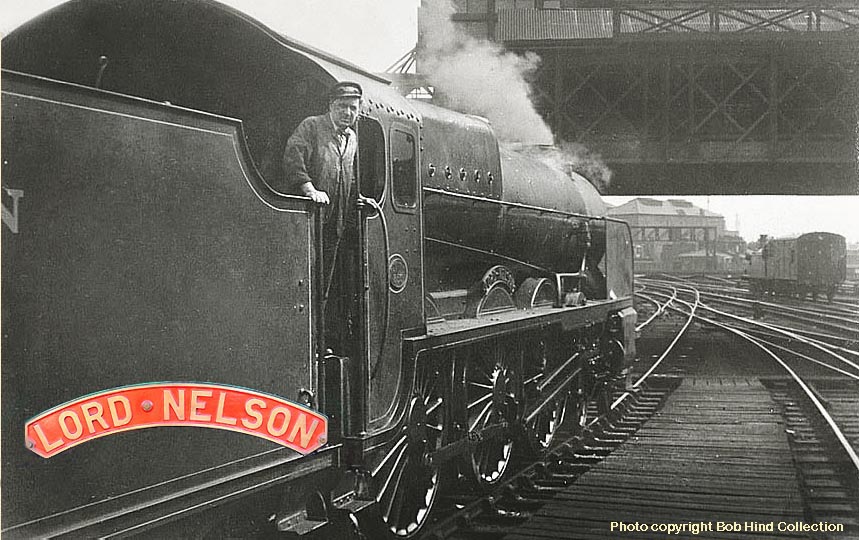
(Above-Below) Introduced in 1918, RW Urie's Class 5P 'King Arthur' 4-6-0s were capable of some fine express passenger work between London and South-West England, but by the mid-1920s the upsurge in the Southern Railway's Continental rail traffic between London Victoria and the Channel ports at Dover and Folkestone demanded a more powerful locomotive capable of hauling faster and heavier trains. In 1925 REL Maunsell set about the construction of a Class 7P 4-cylinder locomotive with an improved boiler and Belpaire firebox, albeit the design was compromised by the weight restrictions imposed by the SR's Civil Engineer. The first of the 'Lord Nelson' class No 850 emerged from Eastleigh Works in August 1926. An  additional order was placed for ten locos to be fitted with 4,000 gallon 6-wheeled tenders suitable for the Continental ports, but it was later decided to equip half of the class with 5,000 gallon 8-wheeled tenders necessary for the longer West of England routes. This was followed by an order for a final five locomotives, making 16 in all. As it turned out the performance of the 'Lord Nelson's' was marred by poor steaming resulting in Maunsell embarking upon a number of experiments. This included the fitting of smoke deflectors which benefitted the class, but it wasn't until Oliver Bulleid became CME of the Southern Railway in 1938 and fitted larger diameter chimneys and Lemaître multiple jet blastpipes that the problem was ultimately solved. Bulleid's contribution greatly transformed the 'Nelson's' performance on the heavy boat trains, and thereafter the class was highly respected by enginemen. (Above-Below) No 850 Lord Nelson departs from Waterloo with the 5pm West of England express in May 1936; the loco is about to pass beneath the overhead signal box, which closed in October 1936 as part of the Waterloo approaches re-signalling and commissioning of Wimbledon Flyover. (Below) The absence of smoke deflectors dates this photo of 'Lord Nelson' class No 861 Lord Anson receiving attention from the driver at Wokingham station in November 1929. The train is the 8.40am Waterloo to the West of England passenger train.
additional order was placed for ten locos to be fitted with 4,000 gallon 6-wheeled tenders suitable for the Continental ports, but it was later decided to equip half of the class with 5,000 gallon 8-wheeled tenders necessary for the longer West of England routes. This was followed by an order for a final five locomotives, making 16 in all. As it turned out the performance of the 'Lord Nelson's' was marred by poor steaming resulting in Maunsell embarking upon a number of experiments. This included the fitting of smoke deflectors which benefitted the class, but it wasn't until Oliver Bulleid became CME of the Southern Railway in 1938 and fitted larger diameter chimneys and Lemaître multiple jet blastpipes that the problem was ultimately solved. Bulleid's contribution greatly transformed the 'Nelson's' performance on the heavy boat trains, and thereafter the class was highly respected by enginemen. (Above-Below) No 850 Lord Nelson departs from Waterloo with the 5pm West of England express in May 1936; the loco is about to pass beneath the overhead signal box, which closed in October 1936 as part of the Waterloo approaches re-signalling and commissioning of Wimbledon Flyover. (Below) The absence of smoke deflectors dates this photo of 'Lord Nelson' class No 861 Lord Anson receiving attention from the driver at Wokingham station in November 1929. The train is the 8.40am Waterloo to the West of England passenger train. 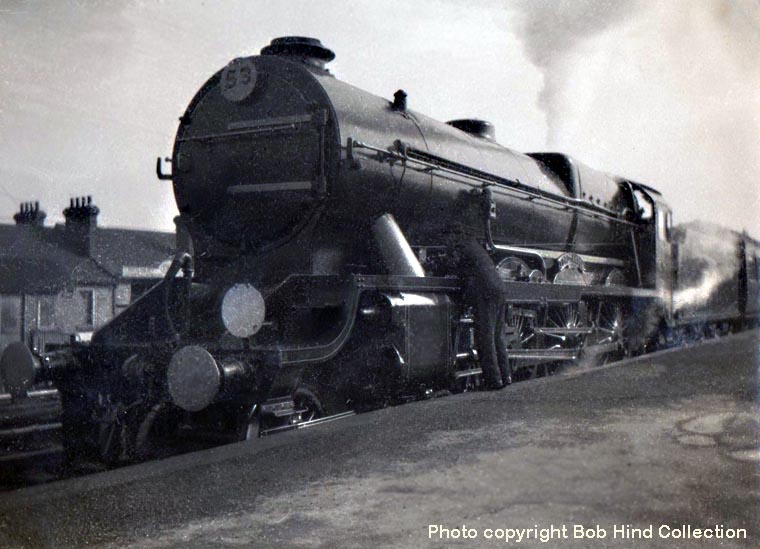

(Above-Below) 'Lord Nelson' class No 856 Lord St Vincent awaits departure from Waterloo with the 8pm passenger train bound for the West of England in June 1934. (Below) Mixed traffic Class S15 4-6-0 No 522 heads an 'up' Cunard White Star boat train special from Southampton Docks near Pilbright Junction in August 1935. Note the railway workers on the track and the absence of the electrified third rail.

(Above) An elegant LSWR Class X2 4-4-0 No 585 heads 'up' empties for Clapham Junction at Surbiton in 1930. This locomotive was built in May 1891 and withdrawn September 1931, hence it was long gone before British Railways was formed. Bob Hind's archive of Southern Region days is featured further down the page. Meanwhile Bob has kindly provided several photos to illustrate Pat Kinsella's 'Track Relaying' article below...
TRACK RELAYING
by Pat Kinsella
Mr Hooker, the Guildford permanent way ganger once told me, in the Sixties, that when he was with a  relaying gang between the wars it was recognised that a sixty foot length of track per man would be relayed each night. Given that there were eighty men in the gang this equates to one thousand six hundred yards of relaying. This astonishing feat of engineering was possible because no deep ballasting was involved and it only applied on non-electrified lines where there was no conductor rail to hinder the operation. Nevertheless it was some going to accomplish such an achievement in poor artificial lighting and in the time allowed.
relaying gang between the wars it was recognised that a sixty foot length of track per man would be relayed each night. Given that there were eighty men in the gang this equates to one thousand six hundred yards of relaying. This astonishing feat of engineering was possible because no deep ballasting was involved and it only applied on non-electrified lines where there was no conductor rail to hinder the operation. Nevertheless it was some going to accomplish such an achievement in poor artificial lighting and in the time allowed.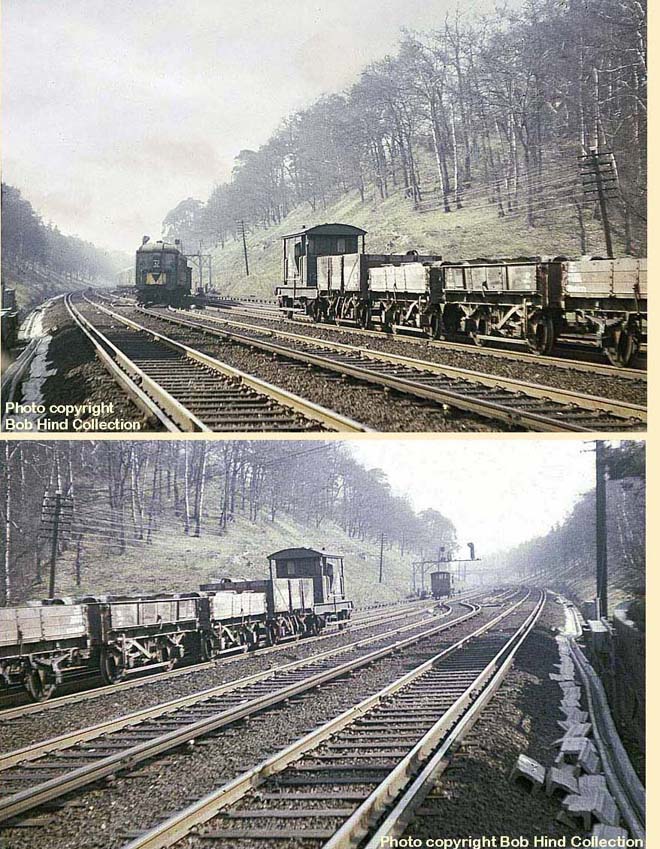 Obviously, there were no Health and Safety rules at that time to hamper operations. On a two track line relaying was not as dangerous as there was no passing traffic but in areas where there were four tracks (see slewed road left during occupation of the main line near Woking) there was an imminent danger from passing trains on the adjacent lines which remained open to traffic.
Obviously, there were no Health and Safety rules at that time to hamper operations. On a two track line relaying was not as dangerous as there was no passing traffic but in areas where there were four tracks (see slewed road left during occupation of the main line near Woking) there was an imminent danger from passing trains on the adjacent lines which remained open to traffic.
This hazard was highlighted one Saturday night circa 1965 when the 'Up Mail Train' from Bournemouth, diverted via the up slow line from Basingstoke, hit and killed the Ganger and Lookout Man as it passed the engineering works on the up fast line near Hook. Allegedly, these unfortunate men were killed partly due to the noisy machinery on the site of work who couldn't hear the 'Pacific' locomotive hauling the 'Royal Mail' train as it approached.
There were no such things as P.T.S documents, (Personal Track Safety Certificates), HVVs (High Visibility Vests), safety helmets, power lighting, steel capped boots or leather gloves issued to staff. Lifting old 'panels', (60 foot lengths of 'bullhead' rail) with very old sleepers hanging down from the 'chairs', only held on by a couple of bolts secured into rotten timber whilst dropping ballast as the panel passed over the heads of track workers who were spreading out the old stone ready for the new 'panel' to be dropped into place, was extremely hazardous. Doubtless, this practice was against regulations but expediency was desired by all of the gang to enable an early finish.
(Above) Not a hard hat or high visibility vest in sight! Cowans Sheldon crane at work near Woking.
The relaying gang for our area, (known as the Wokingham Gang), covered all routes South and West from Waterloo down to Havant via Guildford. Reading, Basingstoke and Alton lines were also covered. Guildford 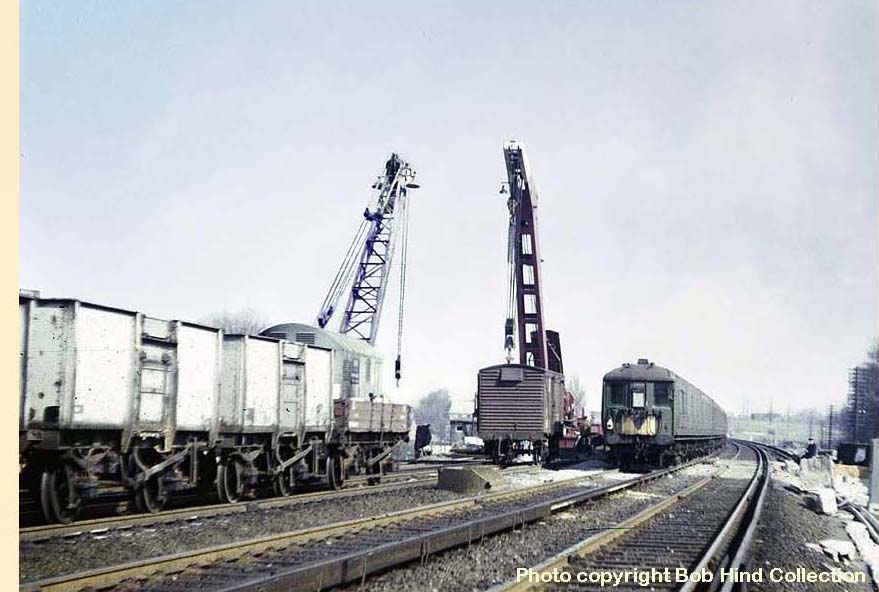 locomotive crews had night rosters especially provided to cover this work. As Guildford men worked with the 'Wokingham Gang' on a regular basis we, I like to think, made up a very experienced professional team.
locomotive crews had night rosters especially provided to cover this work. As Guildford men worked with the 'Wokingham Gang' on a regular basis we, I like to think, made up a very experienced professional team.
The man in charge of the 'our team' on site was Stan Hoar a white haired gentleman from Rowland's Castle. (He covered up many a misdemeanour for us). His subordinate, Mr Martin, usually wore an old railway issue gabardine mackintosh, his pate crowned with a battered brown trilby hat. Unlike the others, Mr Martin was issued a forward facing tilly lamp instead of the usual 360 degree version supplied on site each night to the workforce. His lamp was better for examining the work done. (One individual was always detailed to prepare these tilly lamps in advance; perhaps thirty or forty for each night's work. The combined smell of paraffin and mentholated spirits in conjunction with the hissing sound of so many lamps being pumped up remains very nostalgic to me.
Signing on duty for a nights 'relaying' with the Wokingham Gang would be two Guildford locomotive crews, one for the 'material' train and one for the 'trackrelayer'. It didn't matter too much what locomotive the men on the material train were booked but a Q1 was considered essential for track relaying (see photo below of a Q1 on duty at Wimbledon in 1964). The Q1 was ideal, and in my opinion, others may differ, no better motive power for track relaying existed, steam or diesel. The Q1's brake handle and regulator were  very close to the drivers position. The steam reverser on these locomotives was a great advantage. The 5 foot 1 inch diameter wheel together with the 220 pounds boiler pressure gave acceleration second to none.
very close to the drivers position. The steam reverser on these locomotives was a great advantage. The 5 foot 1 inch diameter wheel together with the 220 pounds boiler pressure gave acceleration second to none.
In the 1950s and early 60s trackrelayer's were not self propelled and had to have a locomotive to power them back and forth. A Q1 coupled to a trackrelayer with a tight screw coupling and through vacuum brake made the best combination of all. Many an argument ensued between drivers and their foremen when booking on duty if informed that there was only a Standard Class loco available for the tracklayer. Standard's had a 'screw reverser' which on some were extremely hard to wind from forward to reverse due to lack of maintenance. Running light coupled together, to Woking PAD, (Pre Assembly Depot) where the material train had been prepared earlier in the day the locos were attached while the guard calculated the load before reporting to the drivers. There would be perhaps five or six bogies of 'prefab' one trackrelayer, mess vans, tool vans and depending on the job at hand four or five stone hoppers. If the length of track to be relayed was very long then there would be more prefabs and a larger stone train would run separately with a further locomotive. But that was usually on 'weekend jobs'.
On arrival at their destination, Petersfield for example, the train would be shunted, the material with the stone hoppers and brake vans placed on the line to be relayed with one engine while the Q1 attached to 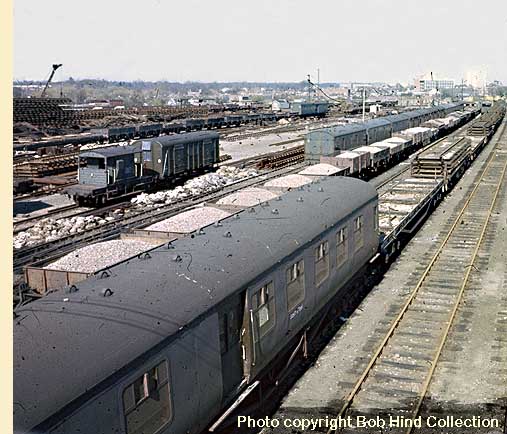 the trackrelayer would shunt to the other line before both sections ran to the site of work under engineers occupation, one on the up road and one on the down road. (The engineers under the direction of Stan Hoar, would take charge of the section of line to be relayed, and the conductor rail currant isolated under special arrangements).
the trackrelayer would shunt to the other line before both sections ran to the site of work under engineers occupation, one on the up road and one on the down road. (The engineers under the direction of Stan Hoar, would take charge of the section of line to be relayed, and the conductor rail currant isolated under special arrangements).
All men would vacate the mess vans, except the 'tea boy', ready to start work. There were men dedicated to each job. The conductor rail would be pushed over to one side out of the way. Then the tracklayer would lift two or three sections of line and place them on an empty bogie before picking up a new 'panel' to replace the first old section removed. While the old sections were being taken away men with 'ballast forks' would level out the old stone ready to receive the new panel. As soon as it was in place a man would be equipped and ready to drill holes for the securing bolts for the conductor rail insulators with his giant 'bit and brace'. Another man would have a 'key' for screwing in the bolts assisted by a colleague. A further pair of men put the 'fishplates' in place and tighten them up with a giant spanner.
After a couple of hours intensive work the 'tea boy' would appear with a bucket full of tea in one hand and a bucket full of cups in the other. (The water was boiled on the mess vans stove before a half packet of tea was placed in the bucket along with a pound of sugar. Gently stirred for a few minutes with a lump of sleeper, it was rumoured, until the whole looked like black paint, then a tin of sweetened milked was adder to bring out the flavour). This went down very well with the men most of whom had a sandwich in their pocket that they devoured on the hoof, so to speak.
When renewals were complete the locomotive on the stone train portion, which hadn't turned a wheel all night, had to run the stone after the men had positioned themselves on each hopper to operate the control gear. If all went well this manoeuvre could be completed in about 20 minutes. Very occasionally a problem might arise, for example; if the loco crew hauling the hopper stopped or slowed down below 2mph and the  men on the control wheels couldn't shut the hopper doors the stone would run out far too much in one spot and would have to be spread around by hand much to the disgust of the 'gang'. On occasions the stone would pile up to such an extent that a hopper may even be derailed. Oh! Calamity! Trying to get a loaded 40 ton 'Walrus ' hopper back onto the rails, before anyone noticed, was no joke...
men on the control wheels couldn't shut the hopper doors the stone would run out far too much in one spot and would have to be spread around by hand much to the disgust of the 'gang'. On occasions the stone would pile up to such an extent that a hopper may even be derailed. Oh! Calamity! Trying to get a loaded 40 ton 'Walrus ' hopper back onto the rails, before anyone noticed, was no joke...
Re-marshalling the train at the end of the night would take up to an hour or so before running back to Woking yard for dispersal and reloading the 'bogies' for the next nights work.
Footnote. Not much check was made on our locomotive timings so if we could hang it out getting back to Woking and arrive after seven o'clock by the time we put the train away the signalmen were reluctant to run us back to Guildford shed during the rush hour. Most locomen were expert at these shenanigans and retired to the shunters hut for a game of 'Beanies' until the shunters got fed up and insisted on us leaving. By the time we arrived back at the depot it was not unusual to book twelve hours. With enhancements, 100 + hours could easily be accrued by the end of the week.
Night rate = time and one quarter.
Rest day on nights = time and three quarters.
Rest day on Saturday night was time and three quarters until midnight then double time thereafter. Therefore, signing on at 2200 hours and finishing, for example, at say ten o'clock on Sunday morning would calculate up to twenty three and a half hours for one nights work. The Sunday at the start of the week was paid at time and three quarters until midnight when it reduced to time and a quarter working into Monday. This was extra to the week's work.
So, one can see the attraction for younger engine crews with young family's to make a 'gobble' as we used to say when the occasion arose. Very seldom, if ever, was a check made on driver's tickets. The only time 'paybills' at Southampton made a check was when a driver booked over twelve hours. (The fireman was always under the charge of the driver, including being logged on his daily 'bill' as some 'elderly' drivers called their driver's ticket. I believe the phrase 'driver's bill' stemmed from the early days of private railways when a 'bill' was submitted to the 'company' for hours worked.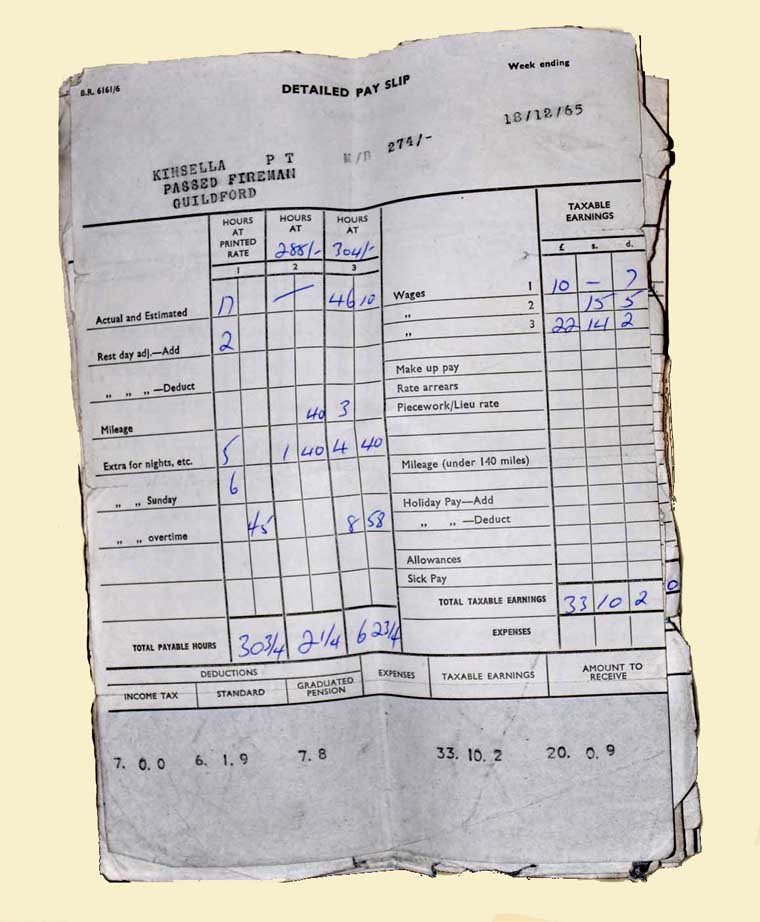
(Above) My payslip shows three different rates of pay because at the time I was a 'Passed Fireman' so I had a fireman's rate, and two Driving rates; the lower was shunt driver rate and the higher main line work. You will notice that my standard deductions were relatively high. This was because I used to put £5 per week in the 'British Railway Savings Bank'. The rates of interest were very poor but after getting used to regular deductions I didn't notice the loss from my take home pay. One or two 'old boy's' said it was a bad idea putting money in the railway bank because management would know how much we were saving and the information would jeopardise our pay claims!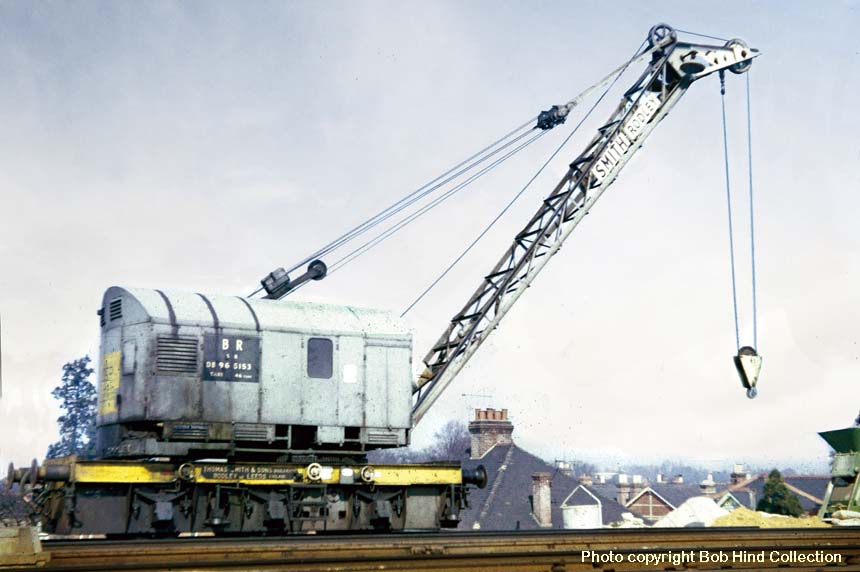
(Above) Thomas Smith & Sons of Rodley Leeds - Tare 46 tons, numbered BR DB 965153 in the fleet.
LAST DAYS OF STEAM ON THE SOUTHERN
by Geoff Burch
(Above-Below) Wrong line working at Weybridge. Due to engineering work on a stretch of the West of England main line - engineers had possession of the track at Byfleet and New Haw - Rebuilt Merchant Navy Class 35026 'Lamport & Holt Line' has arrived at Weybridge and awaits the pointman's instructions before setting back to run 'wrong road' via the Up Fast line from Weybridge to Woking. (Below) Note the absence of HVVs (High Visibility Vests) and the pointman giving a green hand signal (held steady) to assure the driver that the facing points have been plugged and clipped in accordance with wrong line working. No 35026 can now continue her journey from Weybridge with the down 'Bournemouth Belle'.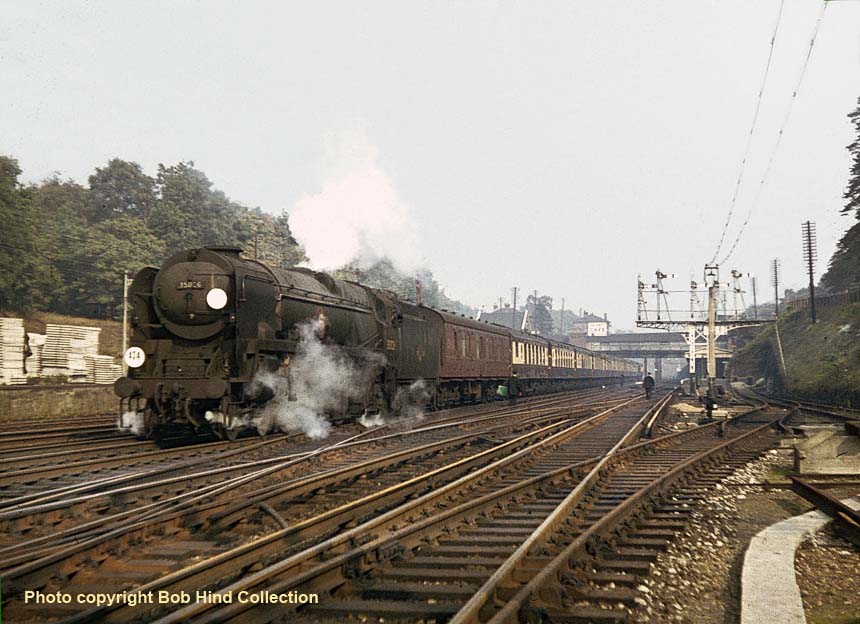

(Above-Below) (Above-Below) Prior to completion of full electrification and the installation of colour light signalling on the SR's Waterloo-West of England main line, the surviving semaphore signals on the route were mainly lower quadrant (similar to the Western Region) and worked pneumatically. In this shot (above) Rebuilt Battle of Britain Class 34052 'Lord Dowding' heads a down express from Waterloo to Exeter through West Weybridge on 22nd July 1961. The station was renamed Byfleet and New Haw in June 1962. Byfleet Junction signal box can be seen to the right of the photograph with the line from Addlestone junction (which passed under the main line) joining the Down Slow line at the beginning of West Weybridge station platform. (Below) In the opposite direction, the Driver of S15 Class 30826 checks the speed of a lengthy loose-coupled freight train bound for Feltham Yard; the route branches off towards Addlestone Junction with a speed restriction of 25mph adjacent to Byfleet Junction signal box.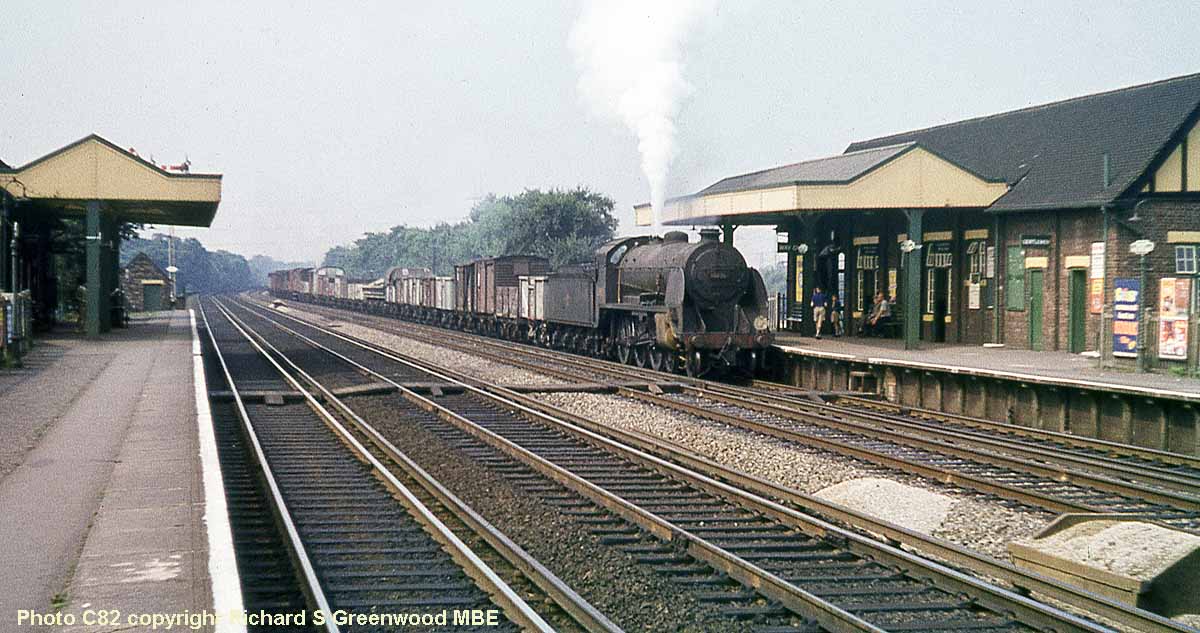
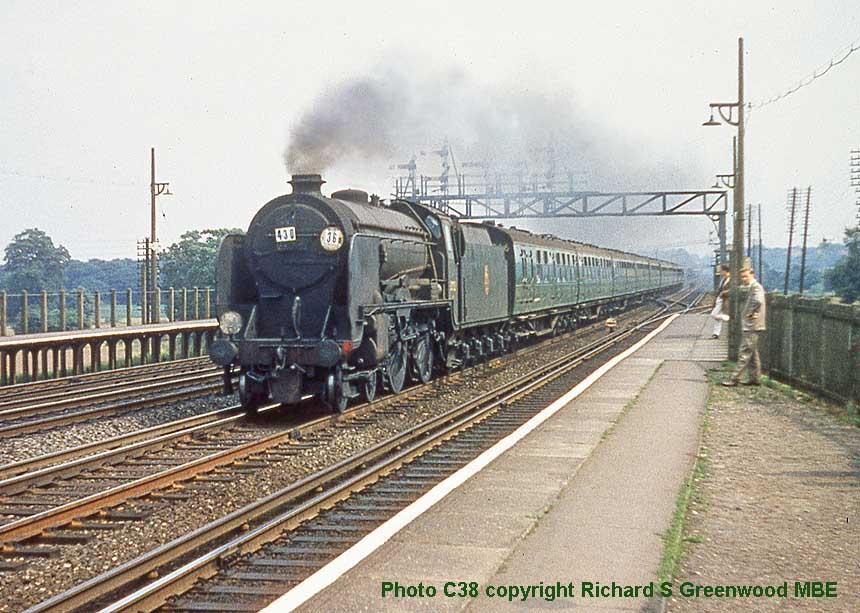
(Above-Below) V Class 30912 'Downside' passes through West Weybridge station with a Waterloo - Bournemouth express on 22nd July 1961. The 'Schools' class is equipped a 'Lord Nelson' 5,000 gallon 8-wheeled tender necessary for the longer West of England routes. (Below) Rebuilt Merchant Navy Class 35027 'Port Line' speeds through West Weybridge with an Up Bournemouth - Waterloo service on the same day. 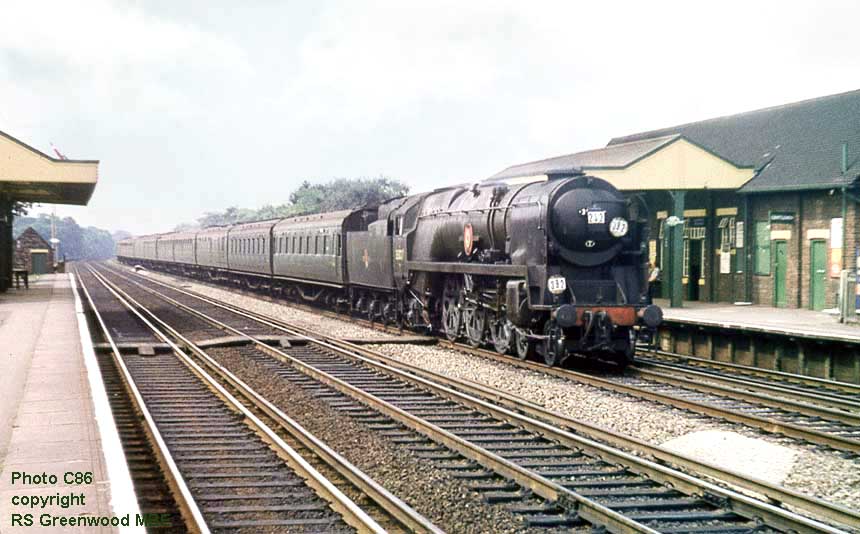
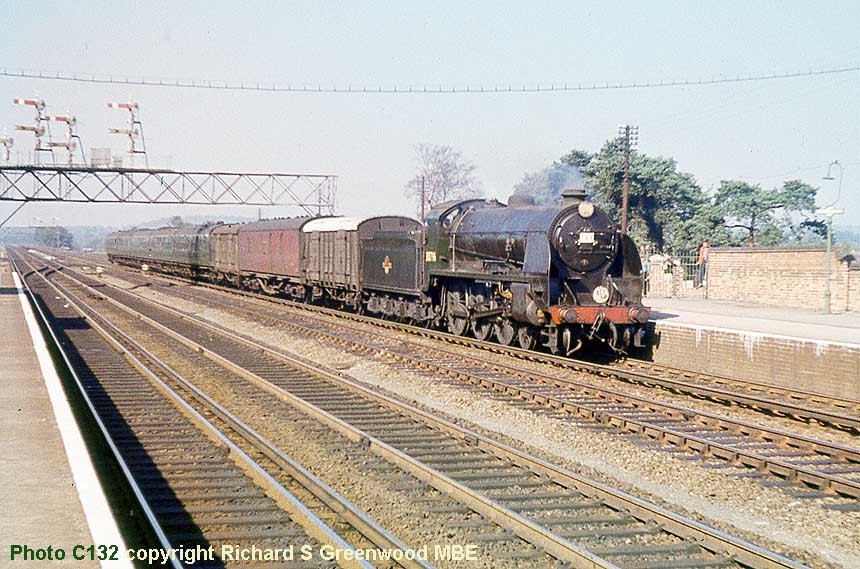
(Above-Below) Brookwood spotting memories. As a boy living in the village of Worplesdon (some 2½ miles from Brookwood station) I spent many happy hours spotting there in the late 1950s. Adjoining the Up side platform was a small viewing area surrounded by metal-railings where you could watch trains coming and going. A small group of lads can be seen on the right of 'N15 Class 'King Arthur' 30796 'Sir Dodinas le Savage' heading an Up passenger stopping service from Salisbury on 9th September 1961. (Below) In the opposite direction a rather grubby Rebuilt Merchant Navy Class 35012 'United States Lines' heads the down 'Bournemouth Belle'. This prestigious train consisting of all Pullman stock would leave Waterloo at 12.30pm and arrive at Bournemouth Central at 2.40pm. Just visible above the third and fourth Pullman cars are the two-aspect colour light distant signals on the gantry, which replaced the lower quadrant distant signals originally sited below the starting signals. 
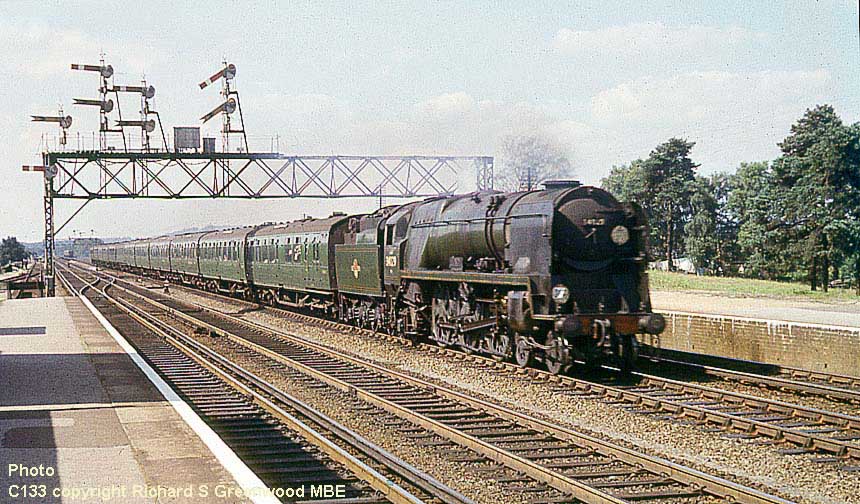
(Above-Below) Rebuilt West Country Class 34029 'Lundy' passes through Brookwood with an Up Bournemouth - Waterloo passenger service on 9th September 1961. The pneumatic lower quadrant signals situated on the gantry at the end of the platform on the down line were worked by compressed air instead of the usual wires attached to the signal frame levers. The two signals in the clear position are for a train on the Down Through line. The Distant signal on the extreme left when clear, would indicate to the Driver that the route was set for the line to Ash Vale via Pirbright Junction. (Below) Rebuilt West Country Class 34095 'Brentor' hurtles through Brookwood on the Down Through line with a Waterloo-Exeter passenger service on 9th September 1961. A sign on the station platform reads: 'Necropolis - Brookwood Cemetery'. This dates back to the times before WW2 when funeral trains ran from the former Waterloo 'Necropolis' station to Brookwood Cemetery which at that time was the largest cemetery in the world. The two stations within the Cemetery (one for non-conformists and the other for Anglicans) were accessed via the down local line (the signal shown on the very left of the gantry at the end of the platform in the previous photograph). A full explanation of the funeral trains and the branch to Bisley Camp can be found on Geoff's Page 32.
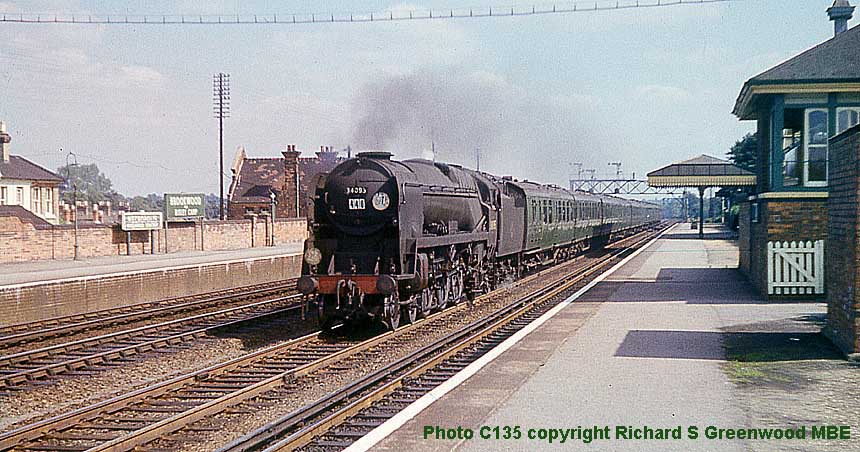
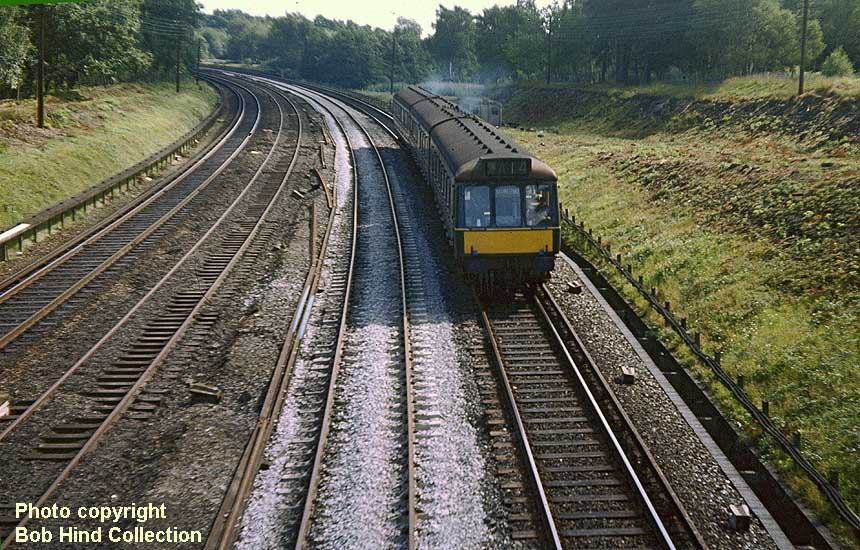
(Above) This photograph of a DMMU was taken between Pirbright Junction and Farnborough. These Diesel Mechanical Multiple Units (DMMUs) were employed on local passenger services between Woking and Basingstoke during the Bournemouth electrification scheme 1965-1967. The rotating energy of the DMMU's diesel engine was transmitted via the gearbox and driveshaft directly to the wheels of the train; the transmission was shifted manually by the Driver in a similar fashion to driving a car; indeed considering how most Drivers at Guildford didn't possess a car, they coped very well! This unit is seen on the Down Local line heading towards Farnborough where both Through lines have yet to be electrified. The Slow lines were electrified between Pirbright Junction, Sturt Lane and Frimley Junction in 1939. Sturt Lane Junction was one-and-a half-miles down the track where a spur enabled 'down' trains to join the Frimley Junction to Ascot line.
(Below) Deep ballast working is in operation on the Up and Down Through lines between Pirbright Junction and Farnborough as an unidentified Rebuilt Bulleid Light Pacific heads a Waterloo to Bournemouth passenger service on the Down Local line circa 1965. The Down Through line hasn't as yet received any ballast but once this has been completed and the line 'tamped', the 60 ft long rails will be removed and replaced by long-welded rail (seen laying in the track). By the beginning of 1967 both Up and Down  Through and Local lines to Basingstoke (and through to Bournemouth) were also fitted with conductor rails to start the new Bournemouth Electric service introduced in July 1967.
Through and Local lines to Basingstoke (and through to Bournemouth) were also fitted with conductor rails to start the new Bournemouth Electric service introduced in July 1967.
WRONG!
I have kindly been contacted by Paul Smith, who writes - 'I thoroughly enjoy browsing your web pages and living in Brookwood, the Southern Region photos on your pages are of immense interest especially those taken in my locality. I notice that you encourage comments and corrections and so may I point out what I believe to be a small error on the caption for the Bob Hind Collection photo taken between Pirbright Junction and Farnborough.
I am almost certain the photo was taken at precisely the same location as mine which can be found HERE on the Geograph.org page.
There is a concrete overbridge carrying a driveway leading to houses near the Basingstoke canal, and the view is looking west towards Farnborough. The Deepcut Road Bridge can just be made out in the distance in both photos. Therefore, the Bob Hind photo shows the unidentified Rebuilt Bulleid Light Pacific on the Up (not Down) Local line heading towards Waterloo, and it is the Up Through line that hasn't received any ballast. I know these are small discrepancies, but thought it worth pointing out in any event...'
Yes, Paul is indeed correct - well spotted! It is a blunder on my part and the caption should read: Deep ballast working is in operation on the Up and Down Through lines between Pirbright Junction and Farnborough as an unidentified Rebuilt Bulleid Light Pacific heads a Bournemouth - Waterloo passenger service on the Up Local line circa 1965. The Up Through line hasn't as yet received any ballast but once this has been completed and the line 'tamped', the 60 ft long rails will be removed and replaced by long-welded rail (seen laying in the track). By the beginning of 1967 both Up and Down Through and Local lines to Basingstoke (and through to Bournemouth) were also fitted with conductor rails to start the new Bournemouth Electric service introduced in July 1967.
My sincere thanks to Paul for pointing out the error, Geoff Burch.

(Above) An interesting shot of N15X Class 32329 'Stephenson' departing from Winchfield with a Waterloo-Basingstoke stopping service on 1st September 1951. The SR's N15X 'Remembrance' Class 4-6-0 was derived from the LB Billington's L Class 4-6-4 tank locos (Brighton Baltics) - the 'Baltic' term being the European name for the 4-6-4 wheel arrangement. Seven locos were built 1914-1922 for express passenger services on the London-Brighton line, but with impending 3rd-rail electrification of the Southern Railway's Central Section. Maunsell converted the redundant 4-6-4 tanks into the SR's N15X Class 4-6-0 tender locomotives for service on the SR's Western Section alongside the earlier N15 'King Arthur' Class - the 'X' suffix corresponded to the old LBSCR designation for a rebuilt-modified locomotive.
(Above-Below) After conversion to a 4-6-0 tender engine at Brighton in 1934, the straight nameplates of the original L Class 4-6-4T SR No 2329 was replaced with curved nameplates of the standard SR pattern with the Class name below. The locomotive spent all its BR days at Basingstoke from where it was withdrawn in July 1956 and cut up at Brighton Works in October. Measuring 51" long, a cast brass nameplate from the original L Class tank No 2329 went under the hammer for £12,500 at Great Central Railwayana Auction on 16 March 2013. The N15X's gained a reputation for rough-riding and relatively poor efficiency, and since they were very similar in outline to the earlier N15 'Arthurs' the new locos were wrongly perceived by some crews to be an improved version of this type. Despite this, the N15Xs' ability to accelerate well was put to good use on cross-country and inter-regional trains around Basingstoke rather than the heavy London to Exeter expresses for which they were intended. The class saw service into nationalisation on the Southern Region as Nos 32327-33, two of which retained their original names: Nos 32333 'Remembrance' and 32329 'Stephenson'. All the N15X's had been withdrawn by 1957. (Below) U Class No 31618 is seen passing Hook station working an extra 'relief' passenger service to Bournemouth.
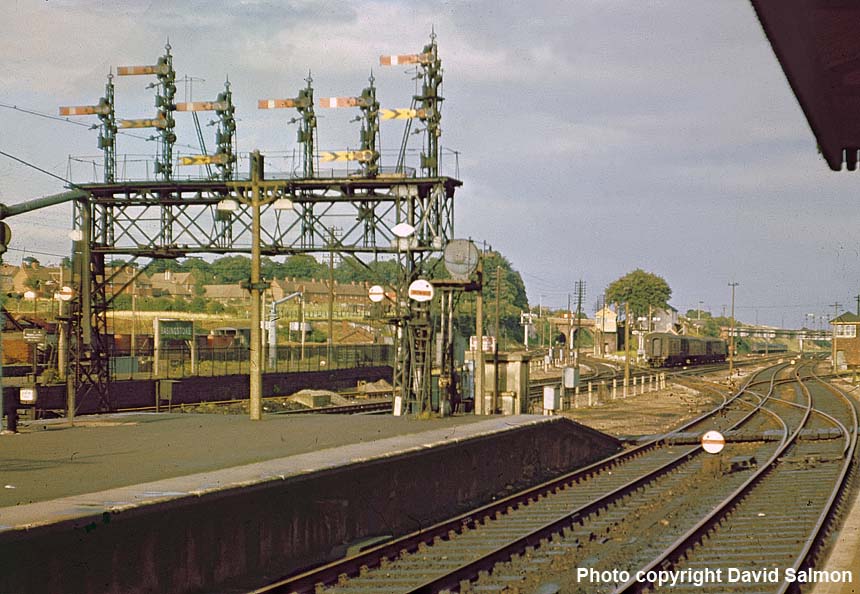
(Above-Below) A fine array of upper quadrant semaphore signals adorn the gantry on the Up lines at the London end of Basingstoke platform on 21st August 1965. The signals reading from left to right are as follows: Up local to Reading branch starter; Up Local Stop & Distant; Up Local to Up Through Stop & Distant; Up Through to Reading Branch Starter; Up Through to Up Local Stop & Distant and finally, Up Through Starter and Distant. The lines to and from Reading played a vital role in trains coming and going to other Regions. (Below) LN Class 'Lord Nelson' 30852 'Sir Walter Raleigh' runs into Basingstoke with a 'cross-country' passenger service from Bournemouth via Reading, Oxford to Birmingham on Wednesday 25th April 1962. By the end of the year, all through trains over the Somerset & Dorset line (reversing at Bath Green Park) were diverted to other routes, notably the 'Pines Express' which was diverted to run over ex-GWR metals via Basingstoke, Reading and Oxford at the end of the summer timetable in 1962. The last Pines Express over the S&DJR ran on 8th September 1962.

 (Above) A grand old lady of the Southern Railway, D Drummond's famous London and South Western 'Greyhound' class made its first appearance in 1899, including No 30702. By 1961 all 66 members of the class had been retired.
(Above) A grand old lady of the Southern Railway, D Drummond's famous London and South Western 'Greyhound' class made its first appearance in 1899, including No 30702. By 1961 all 66 members of the class had been retired.
(Left) A grand old man of the Southern Region, Geoff Burch, during a recent talk at Farnborough.
Ian Barefoot, Publicity Officer, Railway Enthusiasts Club, writes - 'The social history of those involved in the operation of Britain's railways (particularly at the 'sharp end') are rarely told but always fascinating. It was with great pleasure therefore that the Railway Enthusiasts Club at Farnborough presentation was full of anecdotes - interesting not only for the locos and locations involved - but because of the involvement of his work colleagues, bringing a realisation that work of this nature is very much a team effort.hosted an illustrated presentation by Geoff Burch, a former railwayman with British Rail (Southern Region) based at Guildford shed.
For nearly two hours Geoff held the attention of an audience of about fifty members with his reminiscences of life at Guildford Locomotive Shed - a period spanning the late 1950's to the end of steam at Guildford in 1967. Geoff's interest in railways started in his school-days - his classroom backed on to the 'main line' and like many of his fellow students he became an avid train-spotter, 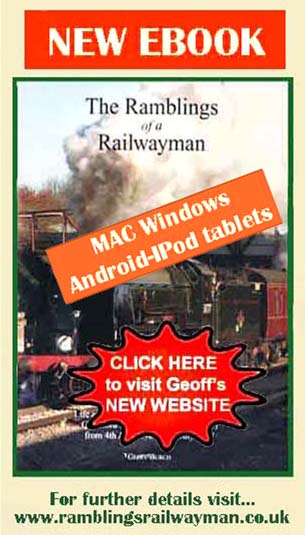 much to the despair of teachers when lessons were disrupted by boys dashing to the windows to watch a train pass! Geoff later responded to a 'British Railways' job advert and, at the age of fifteen, started work as an engine-cleaner at Guildford shed, gradually making his way up to the position of fireman.
much to the despair of teachers when lessons were disrupted by boys dashing to the windows to watch a train pass! Geoff later responded to a 'British Railways' job advert and, at the age of fifteen, started work as an engine-cleaner at Guildford shed, gradually making his way up to the position of fireman.
Whilst Geoff's presentation concentrated mainly on the steam age, his career on the railway extended far beyond the end of steam when he became Training Design Manager at South West Train's Operations & Safety Training Centre, Basingstoke.
Having retired in 2009, Geoff will be pleased to give a talk and presentation to your group. If you are interested, Geoff's email address is:
ramblingrailwayman@gmail.com
Or give him a call on 07710094113. Above photo courtesy Ian Barefoot, Publicity Officer, Railway Enthusiasts Club. 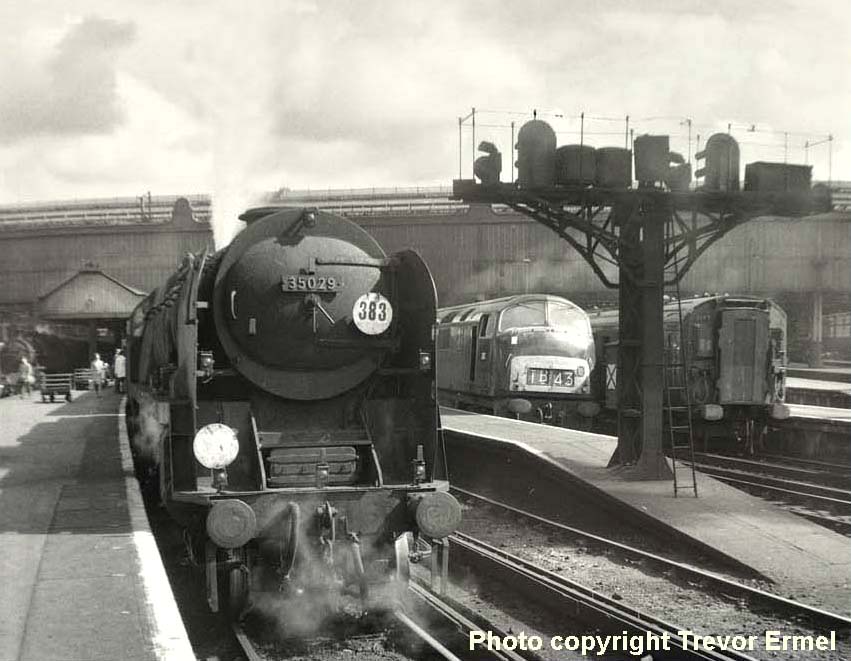
(Above-Right) A superb shot of three completely different modes of transport at Waterloo beginning with Rebuilt Merchant Navy Class 35029 'Ellerman Lines' about to work a passenger service to Bournemouth from No.11 platform. On No 9 platform, a Class 42 'Warship' locomotive waits to haul a passenger service to Exeter and on the adjacent platform, a 12 car 'Portmouth Express' stock electric train formed of 4-COR- 4-RES- 4-COR Units (the leading unit being 3149) waits to work a passenger service to Portsmouth Harbour. Also, on the extreme left of the photo, a BR Standard Class 3MT locomotive stands in the Dock road waiting to work the next set of empty coaching stock from Waterloo to Clapham Yard. Footnote: Rebuilt Merchant Navy Class 35029 'Ellerman Lines' is now sectioned as an educational exhibit in the National Railway Museum at York.
 (Below) I am always grateful to site visitors for help and advice, in particular anyone who corrects mistakes in picture captions. For example, Paul Newhan of Ivydale Science & Technology Service writes: 'In the Southern Region section you show a photo of LBSCR B4 no.42 'His Majesty' but describe it as being 'resplendant in chocolate brown livery with black and yellow lining..' . I think you refer to the later 'Marsh umber' livery. No.42 is in fact shown 'wearing' the famous Stroudley livery (which Billinton perpetuated) of 'Improved Engine Green' - in fact a yellow ochre. The complicated lining was a black band lined in red followed by a dark green band lined in white. Oh and 'resplendant' should of course be 'resplendent'. Please forgive the pedantry...'
(Below) I am always grateful to site visitors for help and advice, in particular anyone who corrects mistakes in picture captions. For example, Paul Newhan of Ivydale Science & Technology Service writes: 'In the Southern Region section you show a photo of LBSCR B4 no.42 'His Majesty' but describe it as being 'resplendant in chocolate brown livery with black and yellow lining..' . I think you refer to the later 'Marsh umber' livery. No.42 is in fact shown 'wearing' the famous Stroudley livery (which Billinton perpetuated) of 'Improved Engine Green' - in fact a yellow ochre. The complicated lining was a black band lined in red followed by a dark green band lined in white. Oh and 'resplendant' should of course be 'resplendent'. Please forgive the pedantry...'
Paul, I forgive you anything... the history of the constituent companies making up the Southern Railway is not my strongest point. I need all the help I can get...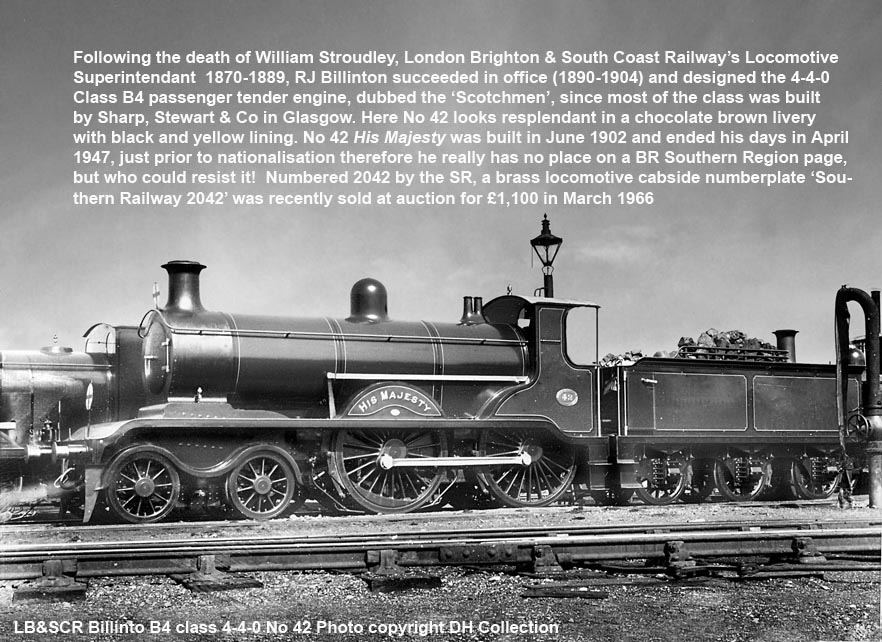

(Above) Talking about seeking help...most men my age steadfastly refuse to to capitulate to the foibles of old age, but trying to keep up with today's cutting edge technology is a different story. Many of us still haven't fathomed  out the difference between an iPad and iPod, and the giddy pace of texting and tweeting goes in one ear and out the other. In terms of health, however, I've been lucky so far, touch wood. I don't need an anti-slip bath mat, mobility scooter or thermal vest, and I've managed to retain a half-decent command of the English language, but what's the point? People no longer communicate normally. It's all done by electronic gadgetry. Which brings me to the point…since I can't pass muster at captioning Southern Region photos accurately I'll take any help I can get.
out the difference between an iPad and iPod, and the giddy pace of texting and tweeting goes in one ear and out the other. In terms of health, however, I've been lucky so far, touch wood. I don't need an anti-slip bath mat, mobility scooter or thermal vest, and I've managed to retain a half-decent command of the English language, but what's the point? People no longer communicate normally. It's all done by electronic gadgetry. Which brings me to the point…since I can't pass muster at captioning Southern Region photos accurately I'll take any help I can get.
For example, when posting this shot (above) of N1 class (3 cylinder) 31822 I was advised that the location was either Hither Green or perhaps Bricklayers Arms? So my thanks to Tony Francis, Fleet Standards Engineer, Southern Railway, for solving the mystery. Tony wrote: 'David, in your query over the location of U1 Class 31822 and whether it is possibly Bricklayers Arms or Hither Green. I believe by nature of it being a 3-road shed it is Gillingham (73D). Regards, Tony.'
(Below) The same thing happened when I posted this shot of LB Billington's London Brighton and South Coast Railway 'K' No 32324. Since the class was normally concentrated at Brighton and Three Bridges for freight traffic, and the loco is carrying a Brighton (75A) shedplate I assumed that No 32324 was photographed at its home shed in 1959...wrong! David Butchers commented on the Guest Book page - 'The photo of 32342 was taken at St. Leonards West Marina shed...' Thanks to both Tony and David for putting me right...
In fact, both responses have prompted me to include a new 'SR Steam on Shed' section below...still under construction....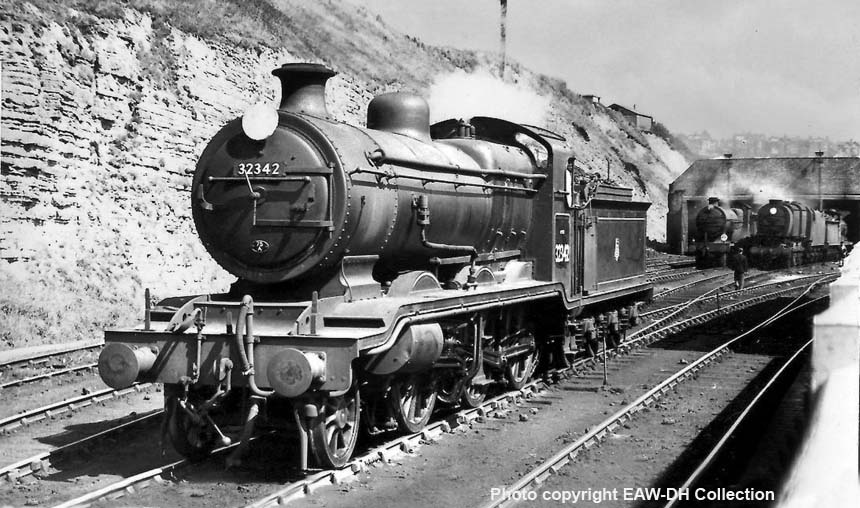
SOUTHERN REGION STEAM ON SHED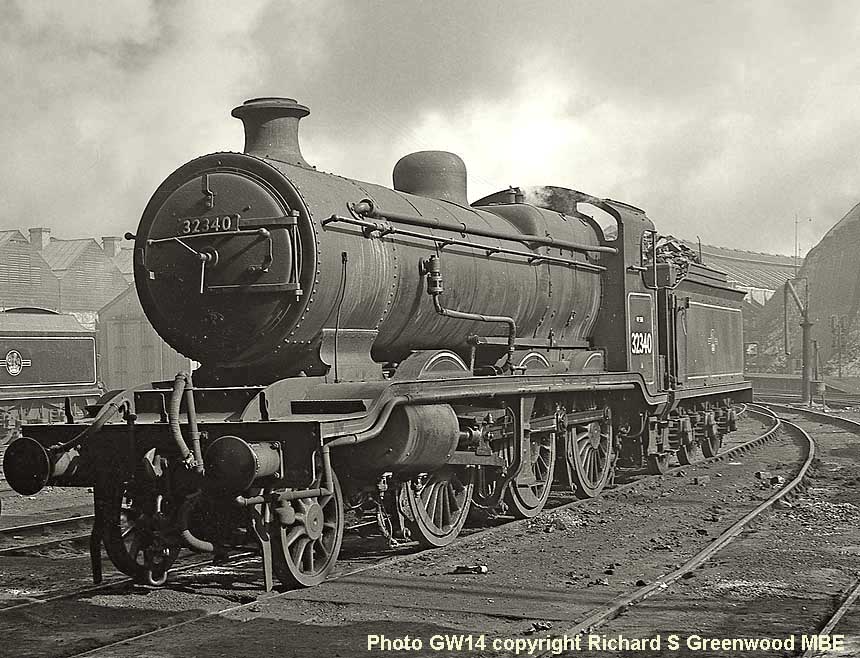
(Above-Below) This time I have the shed right - Brighton (75A) - a splendid shot of Lawson Billington's famous K class Moguls, No 32340, in residence on 17th June 1961. (Below) This photo of Rebuilt West Country Class 34093 'Saunton' and original West Country Class 34033 'Chard' was taken at Eastleigh MPD. Both locomotives are receiving attention to their Valve Gear.
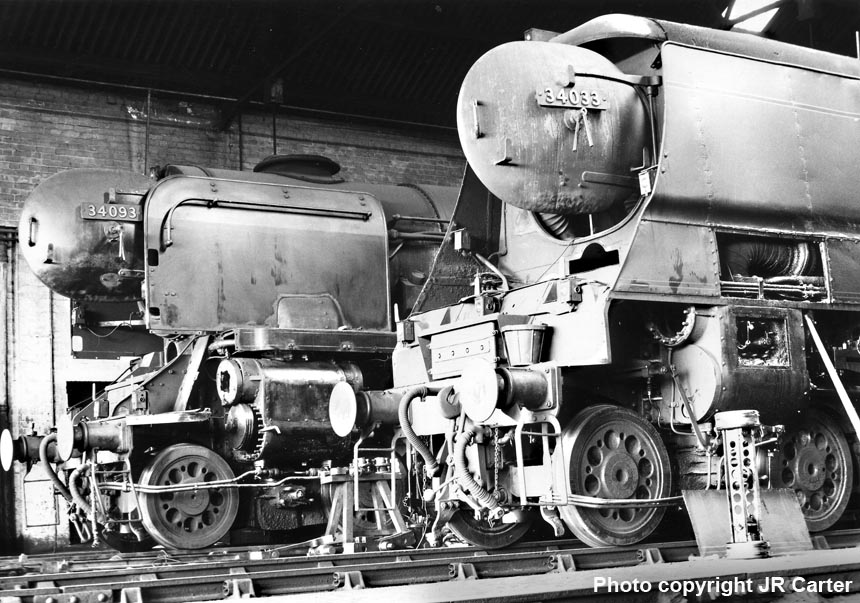


(Above-Below) Coincident with the construction of a new 'hump' marshalling yard at Feltham, RW Urie, the LSWR's Locomotive Superintendant, produced two locomotive designs in 1921: the G16 Class 8F 4-8-0T to shunt transfer traffic at the new yard, and immediately after came the H16 Class 6F 4-6-2Ts to work the interchange freight traffic between Feltham and the yards of other railway companies at Brent and Willesden. (Above) A somewhat brute of a loco with a very high-pitched boiler and massive smokebox, the last of Urie's G16 'Hump' locos (30492-30495 total 4) was photographed at Feltham Shed on 29th April 1962. Note the height of the side tanks which have sloping front ends, compared to the side tanks of the H16 class No 30516 (below) both classes having the same 2,000 gallon water capacity. Numbered 30516-30520 (total 5) in the fleet, No 30516 was photographed at Feltham on the same day. Of interest to the more discerning modellers, despite both classes being very similar in outline, the H16's 5ft 7ins coupled wheels were 6 inches larger...
CLAPHAM JUNCTION MEMORIES


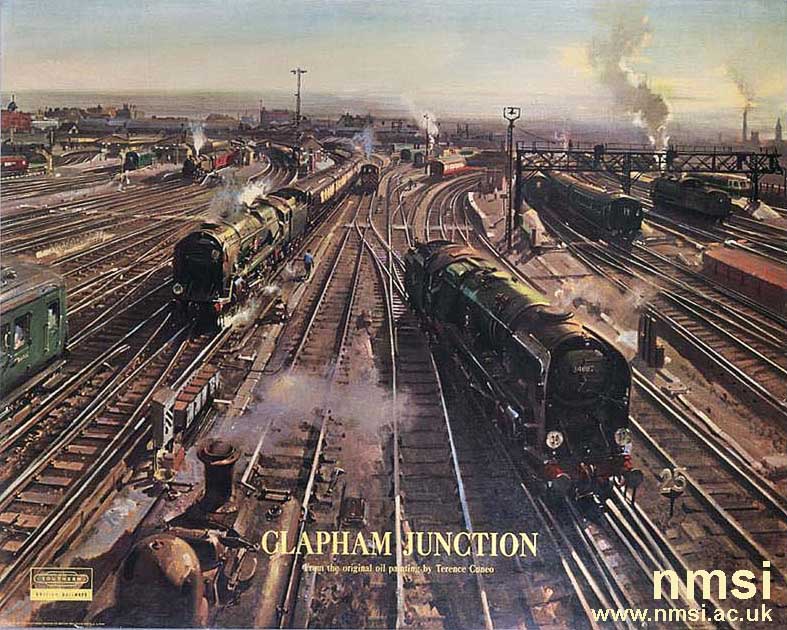
 and, of course, the National Railway Museum (NRM) at York which houses the world's pre-eminent railway collection. Spread across three halls, the Great Hall - formerly the steam engine shed (50A) - is complete with a working turntable, while the Station Hall (previously York's central goods depot) is now laid out like a 'period' railway station. However, the NMSI's full collection is so big that only 8% of the artefacts are on public view. The rest are hidden-away on an ex-WW2 airfield just off the M4. The Science Museum Swindon houses a massive collection ranging from the iconic Lockheed Constellation airliner to super computers, bicycles and the last Fleet Street printing press. The NMSI Collections Online is a superb website which displays countless thousands of objects including a range of fabulous railway travel posters...a visit is highly recommended. This link will take you to the posters featuring the railway paintings of Terence Cuneo whose career spanned more than half a century; in that time he established himself among the highest echelons of twentieth century British art…he was the Master, of that there is no question. Fittingly in
and, of course, the National Railway Museum (NRM) at York which houses the world's pre-eminent railway collection. Spread across three halls, the Great Hall - formerly the steam engine shed (50A) - is complete with a working turntable, while the Station Hall (previously York's central goods depot) is now laid out like a 'period' railway station. However, the NMSI's full collection is so big that only 8% of the artefacts are on public view. The rest are hidden-away on an ex-WW2 airfield just off the M4. The Science Museum Swindon houses a massive collection ranging from the iconic Lockheed Constellation airliner to super computers, bicycles and the last Fleet Street printing press. The NMSI Collections Online is a superb website which displays countless thousands of objects including a range of fabulous railway travel posters...a visit is highly recommended. This link will take you to the posters featuring the railway paintings of Terence Cuneo whose career spanned more than half a century; in that time he established himself among the highest echelons of twentieth century British art…he was the Master, of that there is no question. Fittingly in 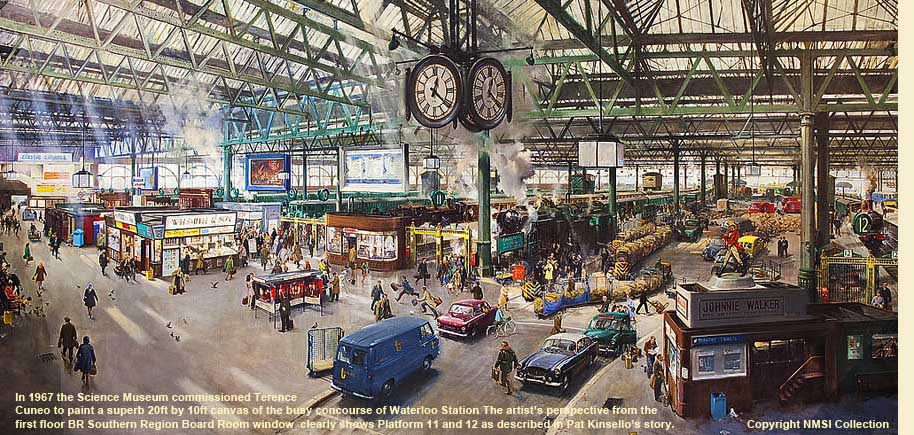 October 2004 a statue to his memory was unveiled at Waterloo Station. I say fittingly because his largest canvas measuring 20ft X 10ft features the station concourse at Waterloo (inset left). This painting was commissioned by the Science Museum in 1967 and shows Cuneo's perspective of the concourse as seen from the first floor British Rail Southern Region Board Room windows. The added caption relates to a story 'The Great Paper Train Chase' by Southern Region railwayman, Pat Kinsella which appears on Page 60. The canvas is now on display at the NRM York. (Top) Perhaps the most famous of all British Railways (Southern Region) posters is this one of Clapham Junction painted by Cuneo in 1962; it depicts the view from the signal box. In the foreground is Battle of Britain class No 34087 '145 Squadron' with another engine of the same class approaching with a passenger train, and electric and steam trains on nearby lines. (Below) Cuneo also painted this British Railways (Southern Region) poster 'Signal Success' depicting an EMU passing a signal box and approaching a signal gantry at dusk, with a steam locomotive hauling a freight train on an adjacent track. The text reads - 'Colour-light electric signals speed the handling of trains. The British Railways Modernisation Plan provides for a considerable extension to this type of signalling which works automatically or is controlled from all-electric signal boxes…' However, since I am not sure of its whereabouts (Cuneo is unlikely to have created the composition from his imagination) I asked Geoff Burch, who replied - 'This is Norwood Junction...what I can also tell you is that the box is the same design as Woking which is now a listed building…'
October 2004 a statue to his memory was unveiled at Waterloo Station. I say fittingly because his largest canvas measuring 20ft X 10ft features the station concourse at Waterloo (inset left). This painting was commissioned by the Science Museum in 1967 and shows Cuneo's perspective of the concourse as seen from the first floor British Rail Southern Region Board Room windows. The added caption relates to a story 'The Great Paper Train Chase' by Southern Region railwayman, Pat Kinsella which appears on Page 60. The canvas is now on display at the NRM York. (Top) Perhaps the most famous of all British Railways (Southern Region) posters is this one of Clapham Junction painted by Cuneo in 1962; it depicts the view from the signal box. In the foreground is Battle of Britain class No 34087 '145 Squadron' with another engine of the same class approaching with a passenger train, and electric and steam trains on nearby lines. (Below) Cuneo also painted this British Railways (Southern Region) poster 'Signal Success' depicting an EMU passing a signal box and approaching a signal gantry at dusk, with a steam locomotive hauling a freight train on an adjacent track. The text reads - 'Colour-light electric signals speed the handling of trains. The British Railways Modernisation Plan provides for a considerable extension to this type of signalling which works automatically or is controlled from all-electric signal boxes…' However, since I am not sure of its whereabouts (Cuneo is unlikely to have created the composition from his imagination) I asked Geoff Burch, who replied - 'This is Norwood Junction...what I can also tell you is that the box is the same design as Woking which is now a listed building…'
WASH & BRUSH UP
by Pat Kinsella
Carriage cleaning was a major part of BR's maintenance bill, and teams of highly organised individuals were employed the length and breadth of the rail network to remove tons of rubbish on a daily basis.
 To assist the ritual of cleaning the outside of trains, carriage washing machines were positioned in or around larger berthing yards. One such place on the Southern Region was Clapham Yard, which had 50 sidings or more capable of holding hundreds of coaches. The double-portal washing plant was accessed from both the Main and Windsor lines some 3½ miles from Waterloo on the City-side of the yard. The washer was fitted with four 'brushes' on either side and a further four in the centre that cleaned both sides in the event of two trains passing through at the same time. The maximum speed was 2mph; any faster could dislodge the revolving brushes and this meant the carriages had to be brushed by a team of cleaners using hand equipment or run through the washer again causing further delay and inconvenience to services in and out of the yard.
To assist the ritual of cleaning the outside of trains, carriage washing machines were positioned in or around larger berthing yards. One such place on the Southern Region was Clapham Yard, which had 50 sidings or more capable of holding hundreds of coaches. The double-portal washing plant was accessed from both the Main and Windsor lines some 3½ miles from Waterloo on the City-side of the yard. The washer was fitted with four 'brushes' on either side and a further four in the centre that cleaned both sides in the event of two trains passing through at the same time. The maximum speed was 2mph; any faster could dislodge the revolving brushes and this meant the carriages had to be brushed by a team of cleaners using hand equipment or run through the washer again causing further delay and inconvenience to services in and out of the yard.An operator was positioned City-side of the equipment, and it was his duty to listen out for the sound of the engine's whistle which indicated to him that the locomotive was through and clear of the apparatus.
 This meant it was safe to turn on the water jets and start the revolving machinery; it was necessary for the washer to be turned on immediately the locomotive had passed through and clear of the washer, otherwise the first few yards on the leading coach would not be cleaned; this was especially the case when it was hauled by a Motor Tank since the coal bunker was only about two feet from the front coach.
This meant it was safe to turn on the water jets and start the revolving machinery; it was necessary for the washer to be turned on immediately the locomotive had passed through and clear of the washer, otherwise the first few yards on the leading coach would not be cleaned; this was especially the case when it was hauled by a Motor Tank since the coal bunker was only about two feet from the front coach. This of course was not rocket science but it still led to misunderstandings...
One particular occasion springs to mind. A very young Guildford fireman was booked to cover a Nine Elms duty taking empty coaches between Waterloo and Clapham yard with an M7 locomotive. A nice little day's work on the face of it but on this occasion there were a couple of draw backs; his Nine Elms driver was not the happiest individual and the loco had been in service far too long.
Our fireman, a boy devoid of humour and experience in equal measure, struggled for steam on the first two trips to Clapham yard, his driver calling him a 'useless twat' - a nice turn of phrase that - but in view of the dire state of the loco and the fact that the fireman was doing his best, it's not too difficult to visualise the acrimonious atmosphere on the footplate by departure time on their last trip of the day.
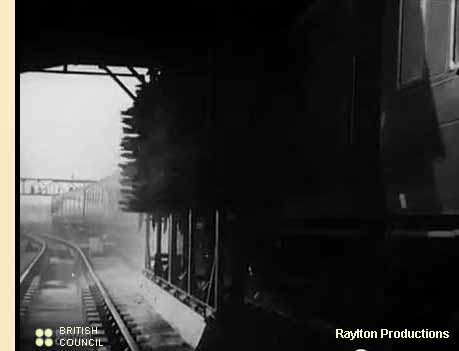 Now the Drummond M7 Motor Tanks were excellent locomotives and would perform all duties asked of them in normal circumstances, but on occasions when things got sticky, such as poor coal, clinkered fire bars or just too long in service (resulting in the need for smoke box and ashpan emptying) they played up like any other loco. With regular use of the fire irons on their final trip, our hero just about maintained enough boiler pressure to haul the twelve-coach train the 3½ miles to Clapham Yard via the washer road. The poor old loco was nearing her last gasp and the brake gauge showed signs of surrendering the 21 inches of vacuum...21 inches of vacuum being necessary to keep the brakes off.
Now the Drummond M7 Motor Tanks were excellent locomotives and would perform all duties asked of them in normal circumstances, but on occasions when things got sticky, such as poor coal, clinkered fire bars or just too long in service (resulting in the need for smoke box and ashpan emptying) they played up like any other loco. With regular use of the fire irons on their final trip, our hero just about maintained enough boiler pressure to haul the twelve-coach train the 3½ miles to Clapham Yard via the washer road. The poor old loco was nearing her last gasp and the brake gauge showed signs of surrendering the 21 inches of vacuum...21 inches of vacuum being necessary to keep the brakes off.However, just as they entered the washing plant our fireman, by now feeling considerable pressure under the baleful glare of his driver, decided to get the fire iron down and stir the fire up again; an unwise move in their current position...manoeuvring a seven-foot fire iron in the confined space of a Motor Tank cab was not a straightforward job. Sure enough, as he dragged it off the side tank he accidentally snarled the handle in the whistle cord, but instead of untangling it carefully by hand he gave it a hefty tug..
A positive blow was sounded on the whistle.
The operator immediately turned on the apparatus.
The driver gave out a despairing moan....
By now the M7 was midway through the washer, at which point the driver; a master of self-preservation, slammed himself up against the inside of the cab to protect himself against the deluge of high-powered jets of water heading his way. All hell broke loose as dozens of revolving abrasive cloths whirred into action, yet the drenched fireman, being a tad slow on the uptake, was utterly at a loss as to why he was suddenly caught up in the crossfire of a monsoon. The driver, realising that abusive language would only traumatize him even more, adopted a more consolatory tone - 'I say fireman', he screamed over
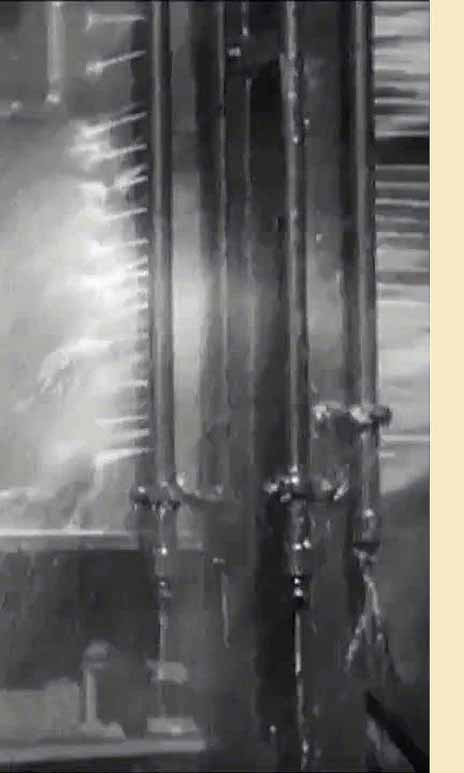 the pandemonium, 'would you kindly stop blowing that f.....g whistle!'
the pandemonium, 'would you kindly stop blowing that f.....g whistle!'Managing to drag the locomotive clear, the soaking driver did a fair impression of Oliver Hardy's 'another fine mess' and then delivered another mouthful of expletives at this half drowned individual, who was still playing a merry tune on the whistle trying to release the fire iron ring.
With barely enough pressure they managed to drag the train the hundred yards to the horizontal ground signal, where they regained a little boiler pressure before being signalled dripping into Clapham yard, however it is probably best to draw a veil over the short time that these two sodden individuals had left together as they headed back to Nine Elms motive power depot.
Speaking of getting wet; I myself was booked to cover a similar Nine Elms duty as the one above, also with a M7 tank locomotive, only this time my driver was the strong silent type but without the 'strong'. There was no attempt at conversation on his behalf so after a while I gave up. I think he believed it was below his station in life to be doing such mundane work and with a 'foreign' fireman to boot.
Anyway, after working a set of empties from Waterloo to Clapham yard we uncoupled then proceeded down to the stop blocks adjacent to the yard canteen, and still no conversation; we then pulled up to the top end of the yard to await instructions on the whereabouts of our next set of empties for Waterloo. An uneasy atmosphere hung heavy over the footplate. Seeing a Pacific entering the yard tender first, hauling a set of empties from Waterloo, my driver wandered over to my side of the footplate to exchange a word with a depot colleague of equal stature. In glided the Bullied and as it passed by cab to cab, just three feet apart, a bucket full of dirty washing water emanated with considerable force catching him full frontal from collar to crutch. Hysterical laughter could be heard from the retreating leviathan indicating to me that the attack was most likely premeditated. Very wet and smelling of carbolic soap, he retreated to his side of the cab with a large dent in his arrogance and sulked for the rest of the day; not that it made any difference to the cab atmosphere. I should point out that most Nine Elms men were of the convivial type bearing little resemblance to the above mentioned.
(Above & Below) These inset show the interior of the Carriage Washer Plant at Clapham courtesy of Raylton Production's - 'London Terminus' - made in 1944. The English railways educational documentary is viewable on YouTube here (Below) An unidentified Class M7 heads empty coaching stock from Waterloo to Clapham yard on 19th July 1961.
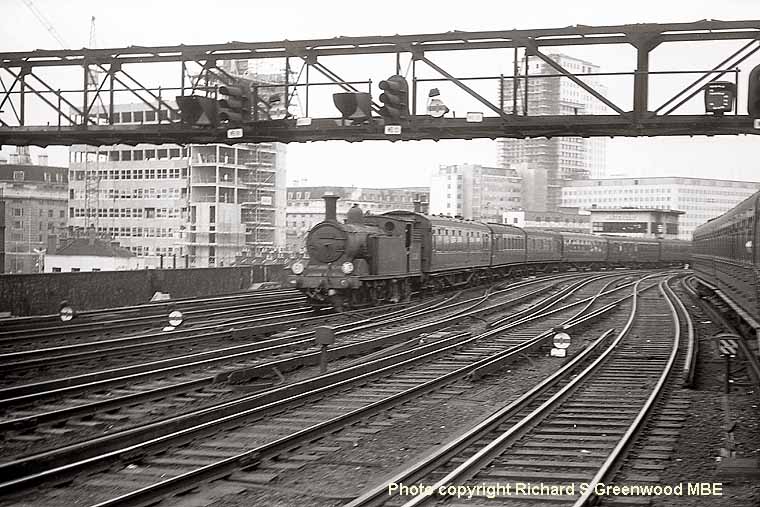
 (Below) Maunsell S15 Class 30830 is on the down fast at Basingstoke working an empty stone train to Salisbury and then onwards to Meldon Quarry. It could be the 12.02pm from Woking Yard. On the first 'BR Southern Enginemen Remember' page 34 Pat Kinsella recalls his first firing turn with Driver Brian Davey on a BR Standard Class 5 locomotive with empties to Clapham Junction and, after disposal at Nine Elms, taking an 'N' class light to Guildford. This photo reminds him of his second firing turn on sister S15 30837 working a troop train. He writes - 'I'm afraid my driver, a Reading man, had to help me out quite a bit with the shovelling. The S15s were a very large locomotive with the injector steam valves set high up close to the cab roof. It is part of the fireman's duties to maintain the boiler water level using these injectors but unfortunately a few junior firemen couldn't reach them, consequently some drivers demanded taller stokers!'
(Below) Maunsell S15 Class 30830 is on the down fast at Basingstoke working an empty stone train to Salisbury and then onwards to Meldon Quarry. It could be the 12.02pm from Woking Yard. On the first 'BR Southern Enginemen Remember' page 34 Pat Kinsella recalls his first firing turn with Driver Brian Davey on a BR Standard Class 5 locomotive with empties to Clapham Junction and, after disposal at Nine Elms, taking an 'N' class light to Guildford. This photo reminds him of his second firing turn on sister S15 30837 working a troop train. He writes - 'I'm afraid my driver, a Reading man, had to help me out quite a bit with the shovelling. The S15s were a very large locomotive with the injector steam valves set high up close to the cab roof. It is part of the fireman's duties to maintain the boiler water level using these injectors but unfortunately a few junior firemen couldn't reach them, consequently some drivers demanded taller stokers!'
(Above-Below) Designed by RW Urie for the London & South Western Railway in 1918, the 2-cylinder N15 class was named by the Southern Railway after characters and places from Arhurian legend. In 1925 REL Maunsell, then Southern Railway's CME 1923-1937, began updating the express passenger fleet, including 20 modified Urie 'Arthurs' No 30763-30792. Here, 30788 Sir Urre of the Mount (built 1925 and withdrawn in February 1962) slows for the Basingstoke stop in 1960. (Below) During the Fifties the Class N15 'King Arthur' 4-6-0s (power classification 5P) were being displaced by the Bulleid Pacifics and BR Standard Class 5s, and withdrawal of the class began in 1955, the last to go in November 1962. In 1959, BR's Southern Region decided on an imaginative policy by naming 20 of their BR Standard Class 5s after withdrawn members of the Class N15s, including BR Standard Class 5MT 73112 'Morgan Le Fay' (name originally belonging to King Arthur Class 30750) seen here pasing Weybridge on the Down Through with a passenger service from Waterloo to Bournemouth.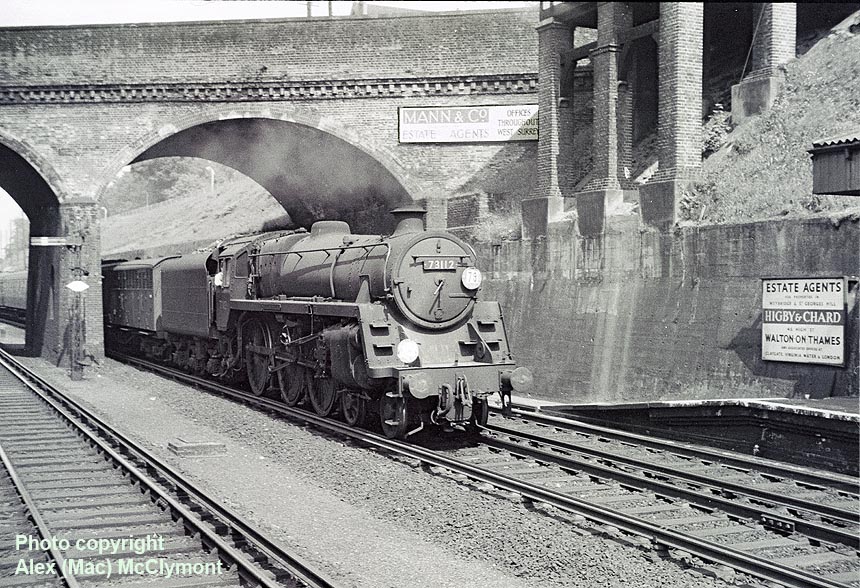

(Above-Below) A brass locomotive nameplate as carried by the BR Standard class 5 4-6-0 loco No 73114 built at Doncaster to Lot 403 and delivered to Nine Elms in November 1955. The loco was named 'Etarre' in April 1960 following withdrawal of the SR 'King Arthur' class loco No 30751 in June 1957. No 73114 spent many years at Nine Elms, before a brief transfer to Eastleigh and finally to Weymouth where it was withdrawn in June 1966 and cut up by John Cashmore at Newport. The ex-loco condition nameplate measured 31¼" x 4⅜" with chevron ends and was sold for £6,600 at a Sheffield Railway Auction. (Below) BR Standard Class 5 No 73114 Etarre at Basingstoke. For the record, Etarre was the name of a scheming, manipulative high-born maiden....or was she? Arthurian literature has been reworked for donkey's years, with lots of things left out and other things added...and so three versions of what might have happened all those years ago are reproduced below. These stories have been reworked by yours truly from information gleaned from Wikipedia.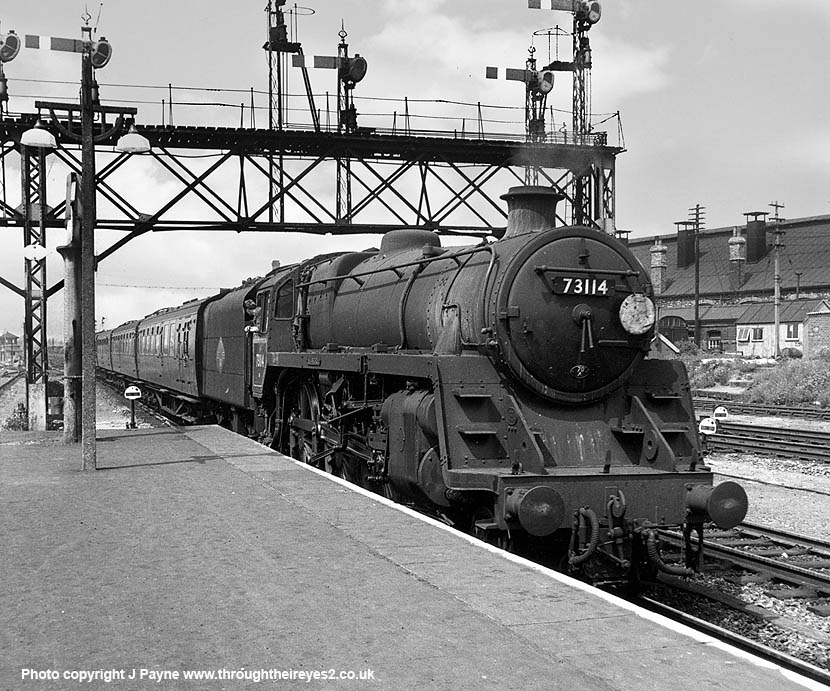
 Sir Pelleas (30778) is a lovesick Knight of the Round Table, who pines for a high-born maiden called Etarre (73114). He wins her a golden headband in a tournament but she spurns his advances, holes up in her castle and sends her knights out daily to
Sir Pelleas (30778) is a lovesick Knight of the Round Table, who pines for a high-born maiden called Etarre (73114). He wins her a golden headband in a tournament but she spurns his advances, holes up in her castle and sends her knights out daily to  humiliate him in the hope of driving him away. Meanwhile, the faithless Sir Gawain (30764) witnesses Pelleas's distress and vows to help him by going to see Etarre on his behalf, but instead of wooing her for Pelleas, the two-timing rat falls for her himself. A distraught Pelleas finds them in bed together, but he cannot bring himself to kill them, so he leaves his sword in the bed and returns home. The next morning, the brazen Etarre recognizes the sword and Gawain remembers his promise. He convinces her to love Pelleas and arranges for them to meet and they both live happily ever after...
humiliate him in the hope of driving him away. Meanwhile, the faithless Sir Gawain (30764) witnesses Pelleas's distress and vows to help him by going to see Etarre on his behalf, but instead of wooing her for Pelleas, the two-timing rat falls for her himself. A distraught Pelleas finds them in bed together, but he cannot bring himself to kill them, so he leaves his sword in the bed and returns home. The next morning, the brazen Etarre recognizes the sword and Gawain remembers his promise. He convinces her to love Pelleas and arranges for them to meet and they both live happily ever after...
However, in Thomas Malory's reworking of the story, his version of the fiathless Etarre (73114) is that after the scandalous romp in the bedroom Sir Gawain (30764) leaves her to stew on her own. Meanwhile, back at the lake one of the Ladies there comes upon Sir Pelleas and falls madly in love with him herself. On hearing his story about the hussy Etarre, she takes vengeance on the maiden by casting a magic spell and enchanting her to fall in love with Pelleas as deeply as he loved her. Alas, by this time, Pelleas is thoroughly p.....d off! He spurns her and she dies of sorrow, which serves her right! But that's not the end of the story...
In Tennyson's 'Idylls of the King' there is yet another version. Here we have a painfully shy Sir Pelleas 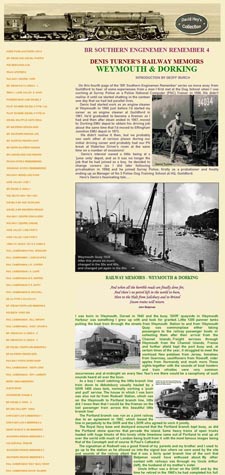
![]() (30778) being knighted by Arthur at a young age. The handsome young knight is deeply in love with Ettarre (73114) but she finds him irksome and doesn't return his affection. She induces him to give her a golden armband as a token of his love (he won it in a tournament, you know) but unsympathetic as ever, Etarre sends him on his way, only for him to return again and again. Meanwhile, riding to the rescue is that dastardly Sir Gawain (30764) who offers to persuade Etarre (73114) to love Sir Pelleas (30778) but he betrays him by sleeping with her himself. Pelleas finds them both in bed together and leaves his sword on their chests, revealing that he is alive and well, but also as a sign of forgiveness. In his view, he cannot kill a knight such as Gawain in his sleep. Very noble, indeed, but had it been me I'd have chopped his b...s off!
(30778) being knighted by Arthur at a young age. The handsome young knight is deeply in love with Ettarre (73114) but she finds him irksome and doesn't return his affection. She induces him to give her a golden armband as a token of his love (he won it in a tournament, you know) but unsympathetic as ever, Etarre sends him on his way, only for him to return again and again. Meanwhile, riding to the rescue is that dastardly Sir Gawain (30764) who offers to persuade Etarre (73114) to love Sir Pelleas (30778) but he betrays him by sleeping with her himself. Pelleas finds them both in bed together and leaves his sword on their chests, revealing that he is alive and well, but also as a sign of forgiveness. In his view, he cannot kill a knight such as Gawain in his sleep. Very noble, indeed, but had it been me I'd have chopped his b...s off!
(Left) Click on photo-link to visit the 4th 'BR Southern Enginemen Remember' page featuring Denis Turner's memories of Weymouth Loco during the 1960s.
BOB HIND's BR SOUTHERN REGION COLLECTION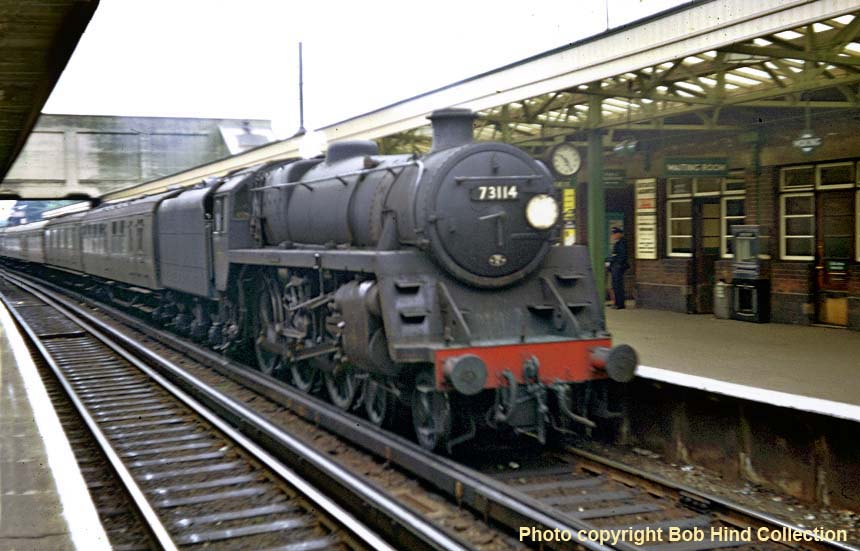
(Above) Another shot of BR Standard Class 5 No 73114 Etarre, this time at Woking in August 1964. 
(Above-Inset-Below) Rebuilt Merchant Navy Class 35012 'United States Lines' heads an Inter-regional special passenger service past Wimbledon Park Depot to Clapham Junction routed via East Putney. It can be noticed that the up and down line have four rails - the middle rail being the negative return rail for traction current for trains belonging to the London Transport District line. The running rails were also 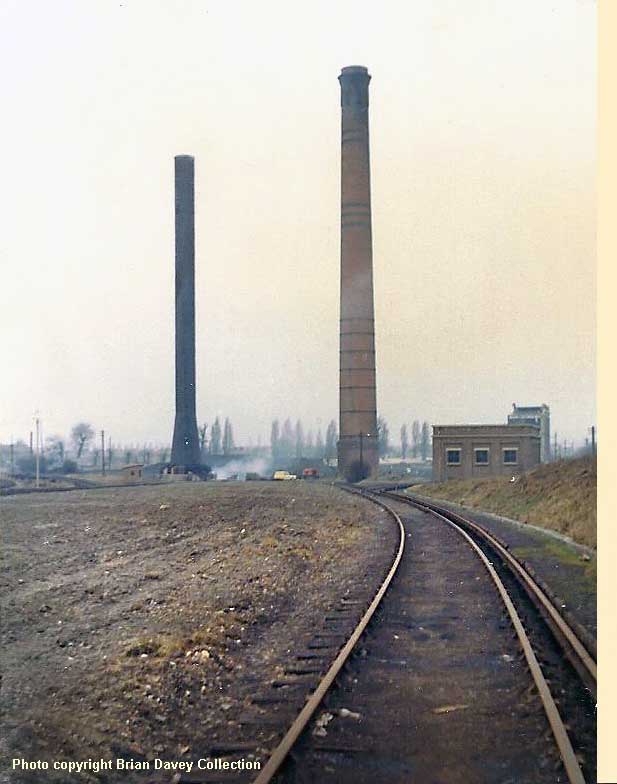 'bonded' over this route to allow a negative return to the substation for all other Electric Multiple Units. The train has been diverted via East Putney as it wasn't possible to connect to the West London lines at Clapham Junction via the Up Local and Up Through lines. At East Putney, the Up line branched off from the District line, over a high arch bridge (now demolished), crossing the Down and Up Windsor lines and joining the Up Windsor line between Putney and Wandsworth Town station. On leaving Clapham Junction, just after passing under the span of Clapham Junction 'A' signal box, the train would branch off the Up Windsor line and head towards Kensington and then Willesden Junction. The concrete walkway in the middle of the photograph allowed the driver of an incoming empty train from Waterloo to change ends on non-corridor stock and to walk to the other end of the train and drive it back into the depot from the leading cab. (Below) The semaphore signals for Wimbledon Park are in the clear position and Rebuilt Merchant Navy Class 35012 'United States Lines' passes the carriage washing machine and onwards towards Wimbledon Park station. Wimbledon Park Depot can be seen in the background along with the Durnsford Road power station chimney (see inset). Located on the west side of the line between Earlsfield and Wimbledon Stations, Durnsford Road power station opened in 1915 and provided power for the L&SWR electrified lines until the early 1960s when electricity was then drawn from the National Grid. To the right of the photograph, the Up local line crosses over via a flyover to make an Up Main, Down Main, Up Local, Down Local track configuration.
'bonded' over this route to allow a negative return to the substation for all other Electric Multiple Units. The train has been diverted via East Putney as it wasn't possible to connect to the West London lines at Clapham Junction via the Up Local and Up Through lines. At East Putney, the Up line branched off from the District line, over a high arch bridge (now demolished), crossing the Down and Up Windsor lines and joining the Up Windsor line between Putney and Wandsworth Town station. On leaving Clapham Junction, just after passing under the span of Clapham Junction 'A' signal box, the train would branch off the Up Windsor line and head towards Kensington and then Willesden Junction. The concrete walkway in the middle of the photograph allowed the driver of an incoming empty train from Waterloo to change ends on non-corridor stock and to walk to the other end of the train and drive it back into the depot from the leading cab. (Below) The semaphore signals for Wimbledon Park are in the clear position and Rebuilt Merchant Navy Class 35012 'United States Lines' passes the carriage washing machine and onwards towards Wimbledon Park station. Wimbledon Park Depot can be seen in the background along with the Durnsford Road power station chimney (see inset). Located on the west side of the line between Earlsfield and Wimbledon Stations, Durnsford Road power station opened in 1915 and provided power for the L&SWR electrified lines until the early 1960s when electricity was then drawn from the National Grid. To the right of the photograph, the Up local line crosses over via a flyover to make an Up Main, Down Main, Up Local, Down Local track configuration.

(Above-Below) With 'feather flying', Rebuilt West Country Class 34014 'Budleigh Salterton' rushes through Surbiton with a Waterloo - Salisbury stopping service circa 1964. (Below) Displaying disc boards top and bottom (Salisbury headcode) Rebuilt West Country Class 34013 'Okehampton' moves slowly light engine through engineering works at Woking Junction adjacent to the Up Yard circa 1967. For some reason, the buffers have been painted white - no doubt for a special working…steam-hauled railtours were extremely popular during the final year of Southern Region steam operation.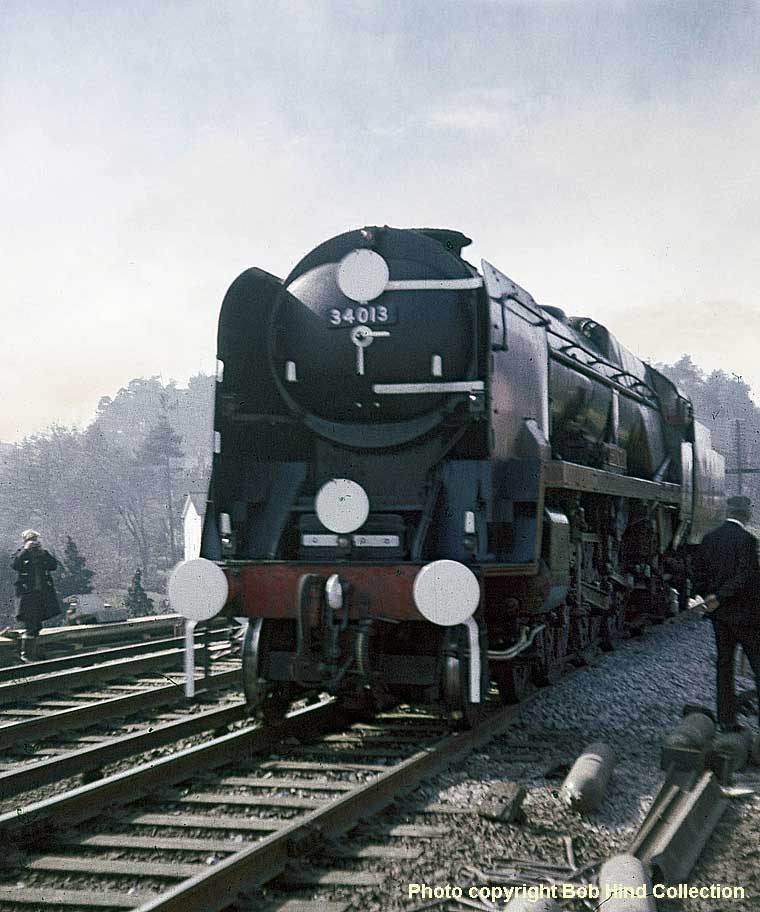

(Above) Rebuilt Battle of Britain Class 34089 '602 Squadron' runs light engine to Nine Elms; the loco is passing Queens Road station (renamed Queenstown Road Battersea in May 1980).
(Below) Viewed from Queenstown Road Battersea station, a 4-SUB Unit makes its way towards Clapham Junction on the down slow line; its eventual destination being Chessington (18 headcode) circa 1967. Production of 4-SUB units ran from 1941 to 1951 and a total of 185 units were built. Their duties were as suburban units on the commuter networks that radiated out from the London termini of Waterloo, Victoria, London Bridge, Charing Cross, Holborn Viaduct and Cannon Street to the suburbs in South, South-West, South-East London and parts of Kent, Surrey, Middlesex and Berkshire, including destinations as diverse as Dartford and Windsor. Withdrawal of the type began in earnest in the late seventies and continued through the early Eighties. The last SUB unit ran in passenger service on the 6th of September 1983 with a commuter service into Victoria from East Croydon. The DECCA building can be seen in the background and just beyond that (hidden from view) was Nine Elms MPD.. 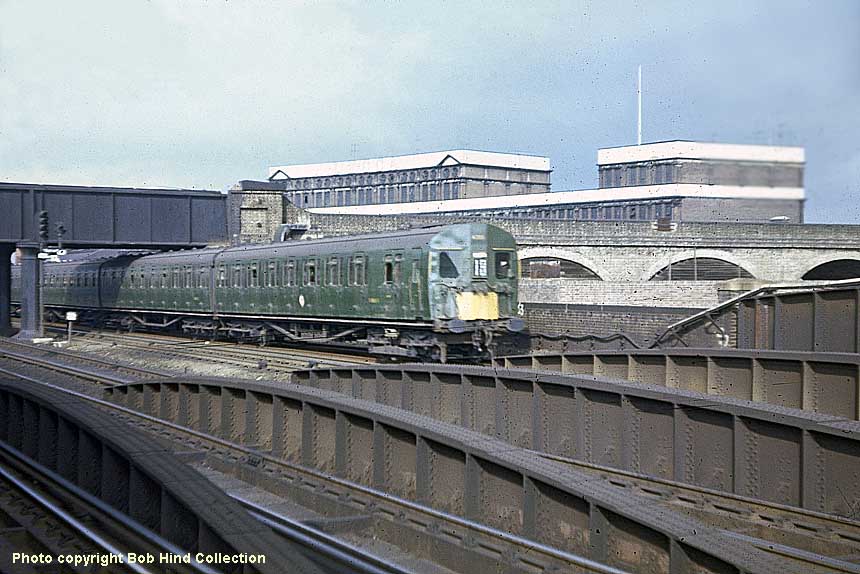
(Below) The driver of N Class 31838 has slightly misjudged the timing of turning off the gate valve to the water column as water cascades down the back of the tender. The loco is being prepared for its next turn of duty on the Reading-Redhill line in the back road adjacent to the coal stage at Guildford. Guildford Park Road can be seen in the background. 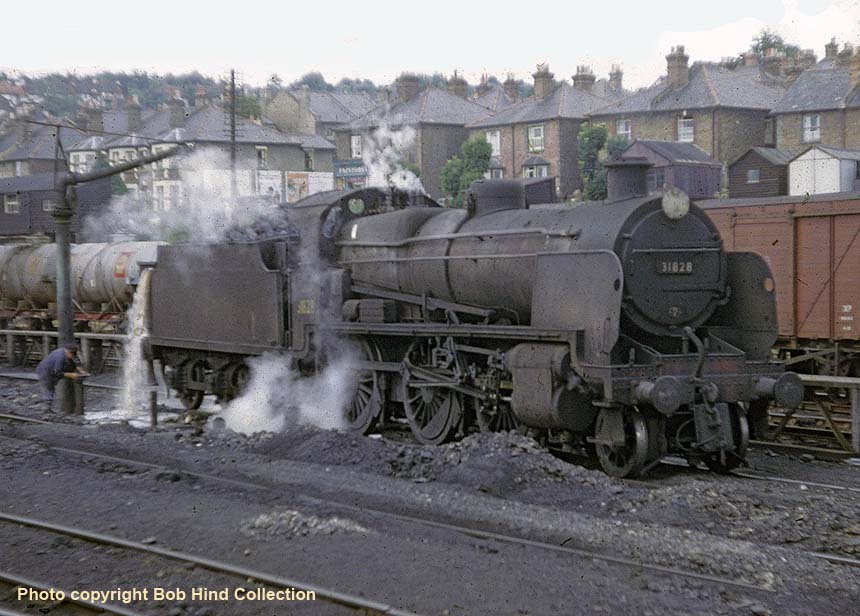

(Above-Below) Rebuilt Merchant Navy Class 35006 'Peninsular & Oriental SN Co' heads a Bournemouth - Waterloo passenger service on the Up Through line between Wimbledon and Wimbledon Park Depot. Quite a number of semaphore signals are still in place to control movements in and out of the depot and the District line section of Wimbledon station. A railway worker takes a short-cut to the station via the un-electrified sidings. Note no High Visibility Vests (HVVs) in those days! (Below) Drewry 204hp diesel-shunter D2041 stands in the East-End mail dock at Woking station whilst the driver takes a meal break. A couple of mail bags are left strewn on the Down Local platform next to the loco, and a screw coupling is just waiting to trip someone over! The Drewry shunter was a regular locomotive utilised for attaching and detaching mail and parcel vans from trains from London for loading and unloading purposes.
THE VAGARIES OF THE BRITISH WEATHER
by Geoff Burch
(Above-Below) This shot of a slippery mishap between a PO vehicle and a 350hp shunter was taken in the same Mail dock at Woking as the 204hp Drewry photo above it. (Below) Spare a thought for the legion of railwaymen as they endeavor to keep the wheels in motion during the severe winter months. Snow is falling heavily at Clapham Junction as passengers await the arrival of trains to take them to their destinations in the winter of 1991.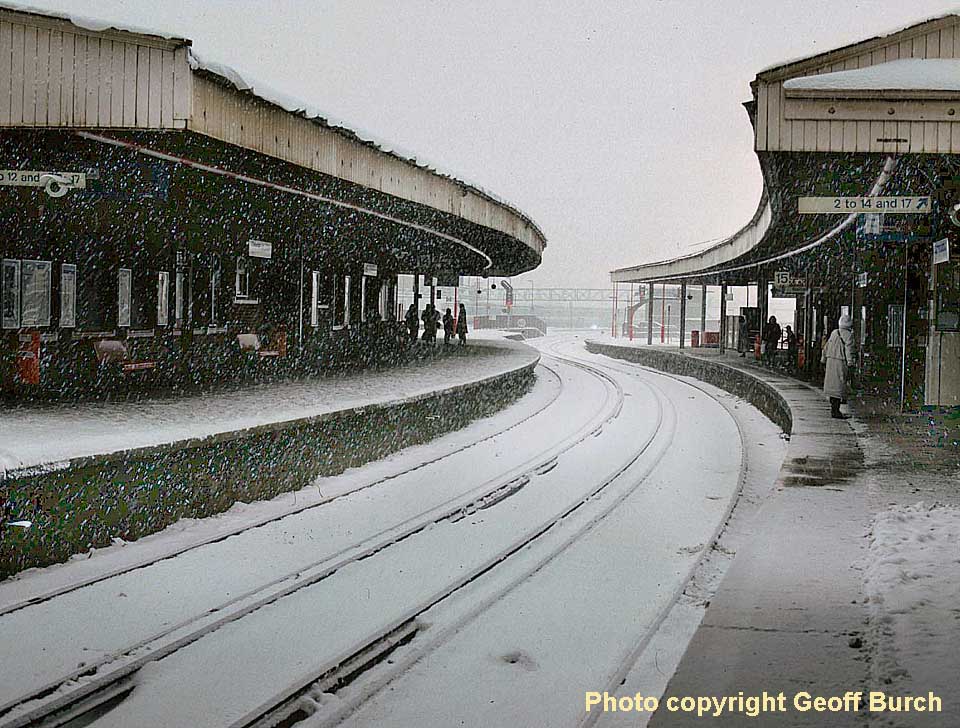

(Above-Below) It's the winter of 1989 and a 4-VEP creates a few arcs and sparks as it leaves Woking station platform 4 because of ice on the live rail. Always a problem in the winter months, ice on the top of conductor rails forms a barrier between the shoegear and the rail - and, in severe cases a complete failure of traction power can result. It was always good driving practice not to move the power controller beyond the 'series' position so that the amps drawn to the traction motors were not too high thus causing a traction overload and complete loss of power or severe acing which might cause a fire. A special de-icer train carrying an oily mixture was deployed in areas where ice was known to be a problem which sprayed the mixture onto the top of the conductor rail to prevent ice from forming. As can be seen from the cab-end, difficulties could occur when coupling or uncoupling the units because of snow and ice. (Below) A Signal & Telegraph engineer clears snow from the points as a passenger service for Portsmouth waits for the signal to take the train through the crossover and onwards to Portsmouth. Most points and crossovers were electrically heated (and in earlier days heated by gas bottles held in cages alongside the track) but in severe weather conditions, problems and long delays were still encountered. 

(Above-Below) A 1550hp Crompton is hauling a train of lowflat wagons at Shere Heath towards Chilworth on a snowbound sunny winter's day in 1985. The North Downs create a beautiful backdrop to the scene. (Below) The first of three snow scenes taken when I was on my way to Selhurst on a Saturday morning to do some 'static' training on Class 319 stock at Selhurst Depot. I was training drivers on the Class 319 EMUs, which had a dual-voltage capability and ran services between Guildford and Bedford + Brighton and Bedford (Thameslink Services). Whilst working over Southern metals, the unit's power supply was collected with a shoegear arrangement via the 750v DC third rail and at Farringdon station, the pantograph is raised; the unit obtaining its power from the 25kv AC overhead supply (the current being converted to DC supply via an on-board rectifier). The 319 was an extremely versatile unit with excellent front end visibility for the driver, a top speed of 100mph with rapid acceleration (especially under the wires) and also has superb stopping power because of its large disc brakes. (Below) Clapham Junction (Central lines) on a snowy winter's day in 1991. The concrete mile-post on the platform denotes its position is exactly two and threequarters of a mile from its London commencement - in this case Victoria. 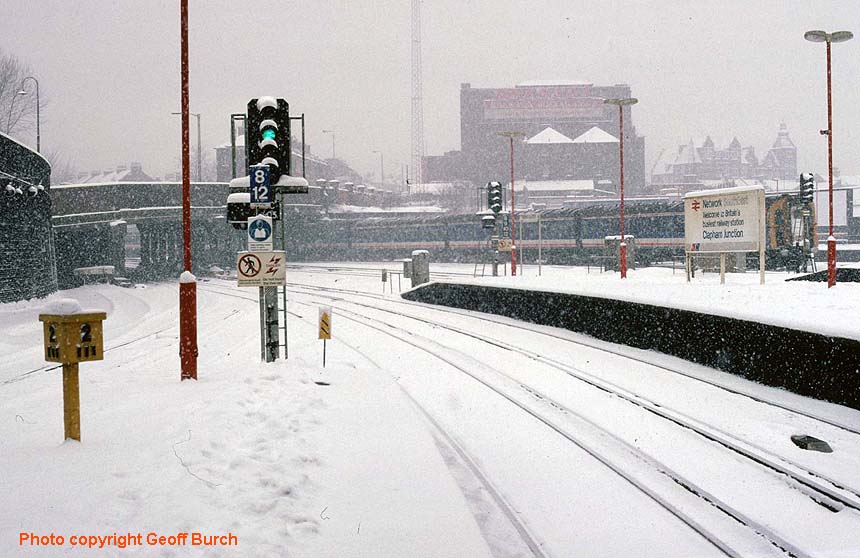
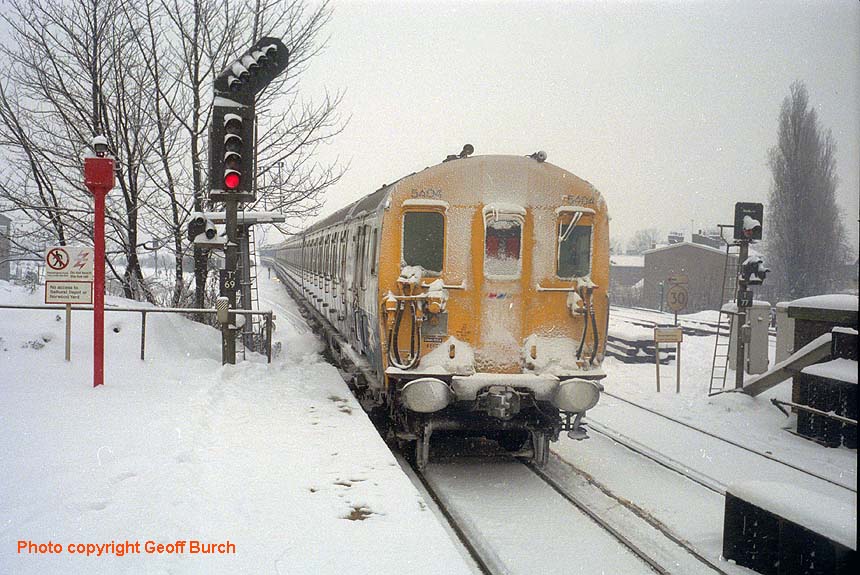
(Above-Below) Two 4 car-EPB Suburban units coupled together, leave Selhurst station for Victoria on a winter's day in 1991. (Below) Viewed from the warmth of the driver's mess room, icicles begin to melt from two EPB Suburban units in Selhurst Depot on a winter's day in 1991. 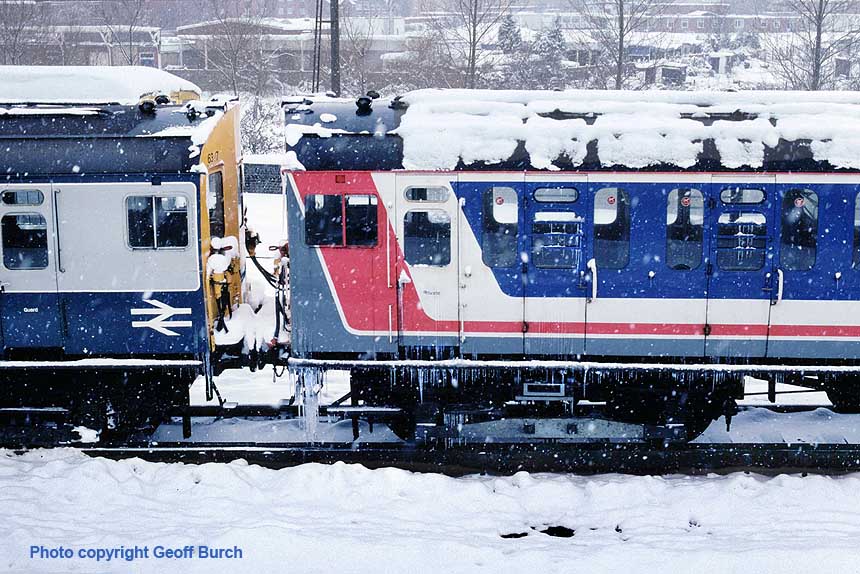
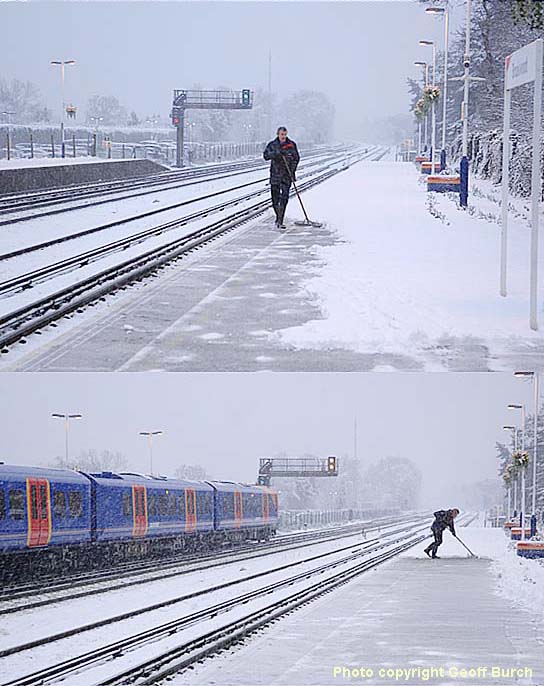
(Above) A lousy job...but someone's got to do it! A railwayman makes steady progress clearing snow from the down platform at Brookwood station on a winter's morning in January 2009; a Class 450 unit leaves the Up platform for Woking and then Waterloo.
KEITH ROBERTSON'S GALLERY OF WEYMOUTH LOCO SHED'S FINAL DAYS
In closing his memoirs on the 'Weymouth & Dorking' page, Denis Turner mentions an old friend, Keith Robertson, whom he hadn't seen since they were both teenagers. Keith and Denis have since caught up a little on the 45 or so years since they last spoke and they have been reminded of their common interest in steam. Keith left Weymouth for 'the smoke' taking with him, it turns out, his many photographs of steam in and around Weymouth. Keith has lent his collection of negatives to Geoff Burch who has kindly scanned them. What we discover is many more fascinating shots of Weymouth around the time that steam died, including many shots of the desolation that Denis describes in his memoirs when steam was withdrawn. Not surprisingly the pictures of Weymouth Loco made Denis feel very sad. He had a memory of 71G when there were a few people about, not as vibrant as it once was but still a place of work, just...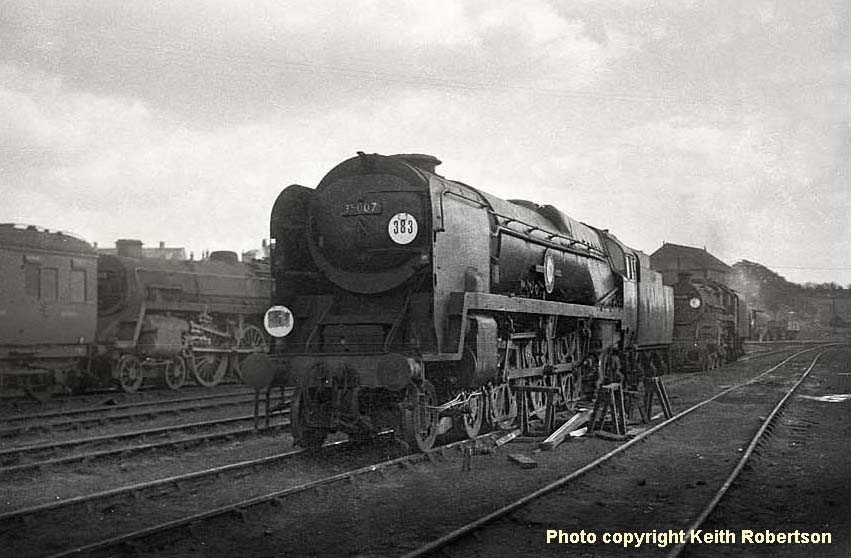
(Below) British Railways shedplate (82F) as carried by Weymouth's allocation from 1949 to 1958. During this 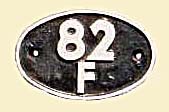
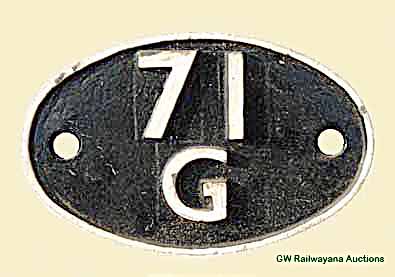 period the ex-GWR shed at Weymouth had 30 locos including a Saint, a Castle and 9 Halls. In 1958 British Railways reshuffled the Regional boundaries and Weymouth Loco was transferred from the Western Region to the Southern Region, swapping shed codes with the ex-MR and S&DJR joint shed at Bath Green Park (71G). Five years later Weymouth Loco was again recoded, becoming 70G in September 1963 up to closure of steam in July 1967. We focus on the transitional period from steam to diesel courtesy of Keith Robertson's excellent Photo Gallery showing Weymouth's final days.
period the ex-GWR shed at Weymouth had 30 locos including a Saint, a Castle and 9 Halls. In 1958 British Railways reshuffled the Regional boundaries and Weymouth Loco was transferred from the Western Region to the Southern Region, swapping shed codes with the ex-MR and S&DJR joint shed at Bath Green Park (71G). Five years later Weymouth Loco was again recoded, becoming 70G in September 1963 up to closure of steam in July 1967. We focus on the transitional period from steam to diesel courtesy of Keith Robertson's excellent Photo Gallery showing Weymouth's final days. 
(Above-Left-Right-Below) A great shot of Weymouth Loco showing the mix of locos that could be found there. They include a Stanier Black 5 No 44691 occupying the fitting shop road on the left, and on the right 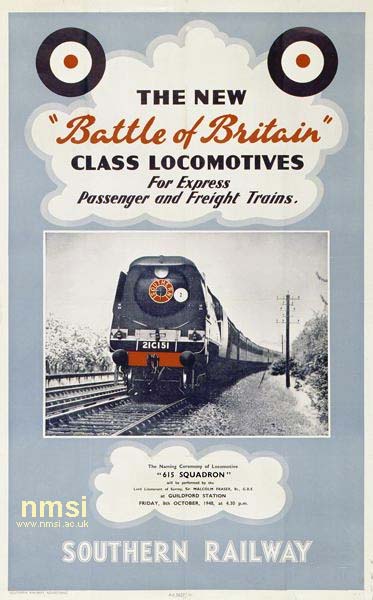 an Ivatt 2-6-2T No 41324 plus an unidentified Merchant Navy class, unusually neither loco has been turned. In the centre No 34082 '615 Squadron' simmers away with a 'Not to Moved' board displayed on the tender.
an Ivatt 2-6-2T No 41324 plus an unidentified Merchant Navy class, unusually neither loco has been turned. In the centre No 34082 '615 Squadron' simmers away with a 'Not to Moved' board displayed on the tender.
(Left) Built in September 1948, No 34082 '615 Squadron' was officially named at Guildford by Sir Malcolm Fraser on 8th October 1948. This Southern Railway poster - 'The new Battle of Britain Class locomotives' - publicizes the naming ceremony, however the loco featured on the poster is in fact the earlier-built No 21C151 Winston Churchill. The naming of Bulleid's No 34086 '615 Squadron' was the last official BR naming of a 'Battle of Britain' class. Withdrawn from Eastleigh shed in April 1966, 34082 remained in store there until August when it was towed 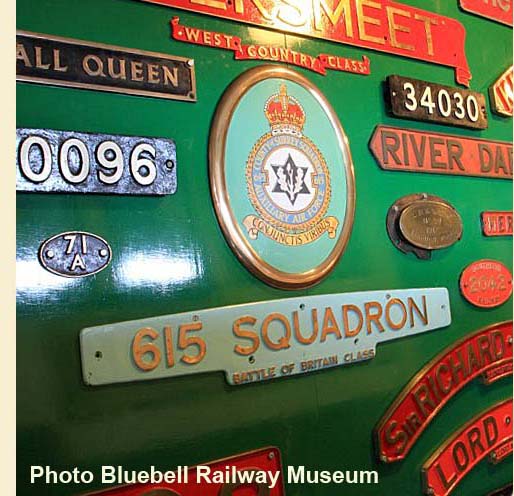 to Cashmores of Newport for scrap in September.
to Cashmores of Newport for scrap in September.
(Right) A mouth-watering display of ex-SR nameplates, smokebox door plates, works plates and shedplates at the Bluebell Railway's Horsted Keynes station. The exhibition was organised by the Bluebell Railway Museum Committee as part of the 50th anniversary celebrations. The nameplate and badge from No 34082 615 Squadron can be clearly seen. The Squadron was formed in 1937 and flew Hurricanes in the Battle of Britain. The motto on the crest 'Conjunctis viribus' means 'By our united force'. Click here to visit the excellent Bluebell Railway's website.
(Below) Another great shot by Keith of 34082 at Weymouth Loco depot. 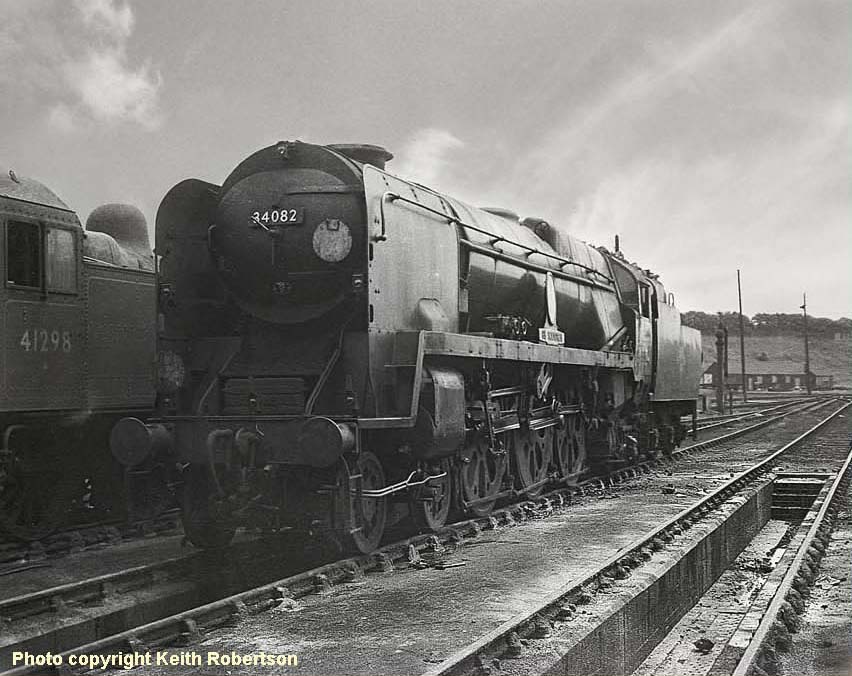
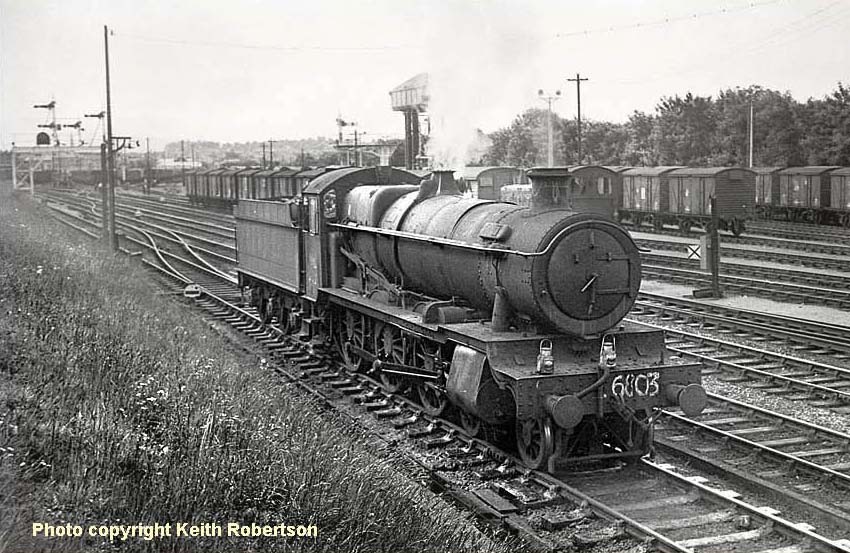
Above) Built at Swindon in September 1936, ex-GWR 4-6-0 No 6803 'Bucklebury Grange' was allocated new to Oxley then later to Stourbridge and Banbury before ending her days back at Oxley again. Withdrawn in September 1965 the loco was scrapped at Bird's, Long Marston. Here No 6803 looks in generally poor condition with both her smokebox numberplate and nameplates missing. Having just left  Weymouth Loco shed No 6803 is waiting for the dummy to drop back into Weymouth Station to pick up her train. In the background a 'Drewry' diesel shunter can be seen propelling wagons back into the goods yard.
Weymouth Loco shed No 6803 is waiting for the dummy to drop back into Weymouth Station to pick up her train. In the background a 'Drewry' diesel shunter can be seen propelling wagons back into the goods yard.
(Inset) A surviving nameplate together with the vendor's original Swindon receipt of purchase recently went under the hammer at a GW Railwayana Auction. Of interest Bucklebury is the family home of the Kate Middleton family.
(Below) BB Class No 34077 '603 Squadron' waits under the coal stage having had its fire dropped on the pit road it will soon move up to the turntable. Fire dropper 'Jock' McVicar is seen at the front of the engine at the left hand-side.Built July 1948, No 34077 went new to Ramsgate shed and ended her days at Eastleigh shed in March 1967. She was scrapped at Cashmores, Newport in August 1967. When a nameplate from 34077 went under the hammer for £25,000 in 1996 it set a world record for a loco nameplate; it was mounted on the landing wall at the Edinburgh headquarters of the long -disbanded Royal Auxiliary Air Force Squadron, now the base of No.2 (City of Edinburgh) Maritime Headquarters Unit. 
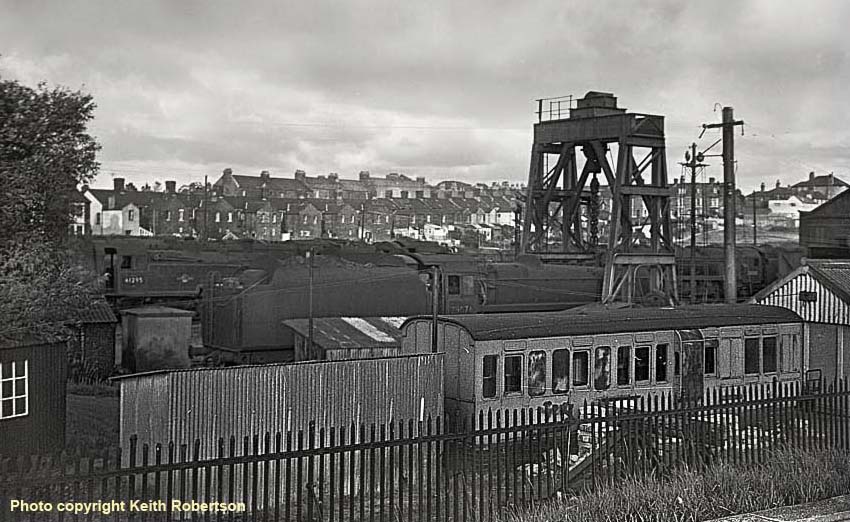
(Above-Below) The last few years of steam at Weymouth Loco...an unusual shot taken from the mainline side of Weymouth Loco showing the loco lifting crane in the middle distance and and in the foreground the draughty little red painted former railway carriage where MIC classes were held by Gordon 'Bruv' Brewer. (Below) 'Merchant Navy' class 35022 'Holland America Line' under the lifting crane with front bogie removed. Commissioned to traffic in October 1948, No 35022 became one of the earliest members of the class to be rebuilt in June 1956. The engine's final shed was Weymouth. Following withdrawal in May 1966 it was sold to Woodham Brothers, Barry, where it was rescued for preservation. Since then, however, it has been used as a spares donor and remains unrestored; it is unlikely to be returned to full working order. 
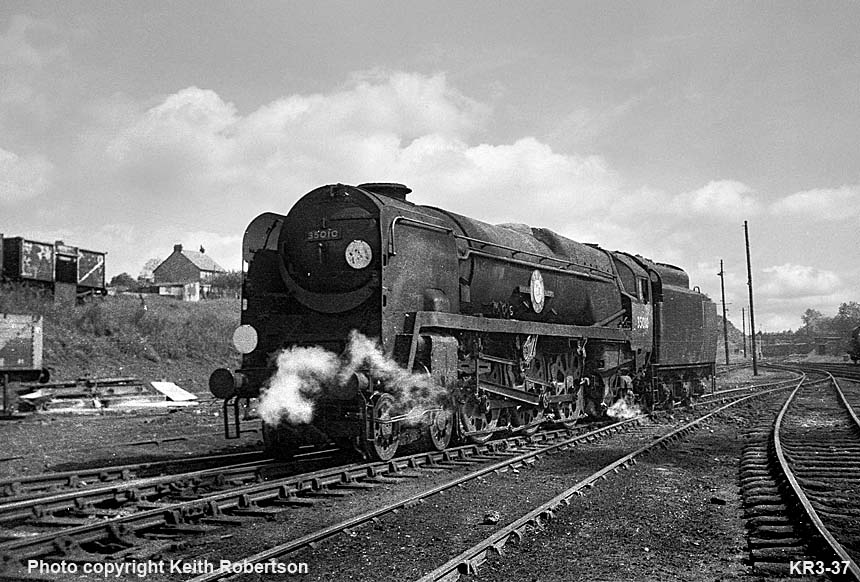
(Above-Below) 'Merchant Bavy' class 35010 'Blue Star in typical grimy condition for the period. Emerging from Eastleigh Works as 21C10 in July 1942, the loco was delivered new to Salisbury shed 72B. It was rebuilt in January 1957 and withdrawn from 71B Bournemouth shed on 30th September 1966. 35010 'Blue Star' is currently undergoing a long term restoration project on the Colne Valley Railway. (Below) A striking head on view of 'Battle of Britain' class 34084 '253 Squadron'. 
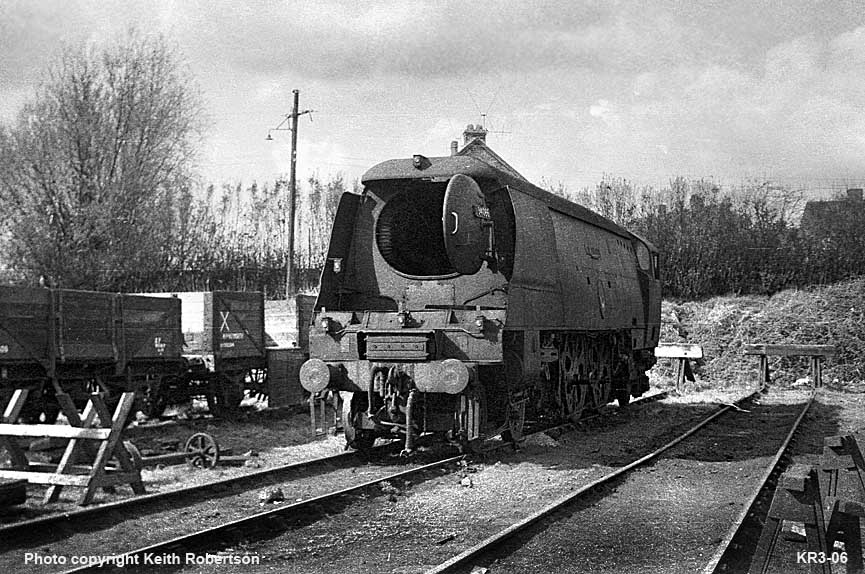
(Above-Inset) A very sorry-looking 'Battle of Britain' class No 34086 '219 Squadron' awaits its fate at Weymouth Loco shed. Built at Brighton in December 1948 and delivered new to Ramsgate in experimental 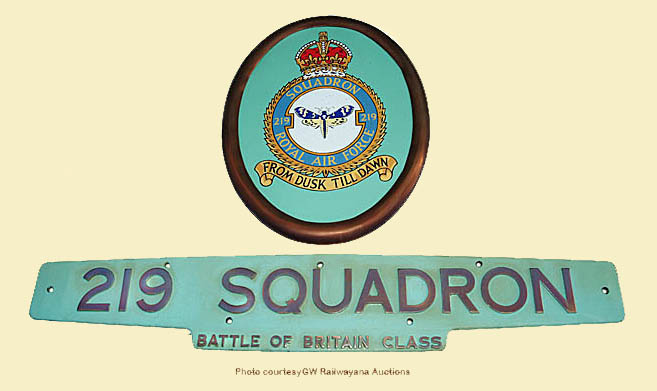 apple green livery, the loco retained its air-smooth casing all its life before withdrawal came at Eastleigh shed on 25th June 1966; it was scrapped by Buttigiegs at Newport in November that year.
apple green livery, the loco retained its air-smooth casing all its life before withdrawal came at Eastleigh shed on 25th June 1966; it was scrapped by Buttigiegs at Newport in November that year.
Alas, No 34086 was extremely unlucky - at the time a group of drivers and shed colleagues from Nine Elms depot (70A) had formed the Bulleid Preservation Society with the praiseworthy aim of purchasing a Bulleid Pacific for preservation. Initially two 'Battle of Britain' class Pacifics, Nos 34066 'Spitfire' and 34086 '219 Squadron', were considered suitable candidates, but in the end the society opted for 'West Country' Class No 34023 'Blackmoor Vale' instead (Inset Left) The RAF's 219 Squadron was originally founded in 1918 and disbanded in 1957. During the First World War the squadron served as a coastal defence unit, and throughout most of the Second World War it operated as a night fighter air defence squadron. (Le3ft) A nameplate and enamel Squadron badge went under the hammer at GW Railwayan Auction for £22,500 The motto 'From Dusk Until Dawn' can be clearly seen on the crest. Click here to visit the fascinating GWRA website.
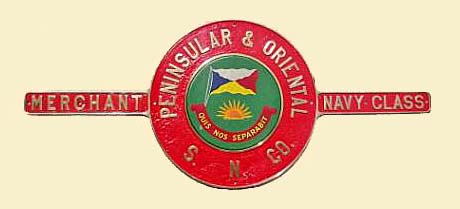 Regular visitors will have noticed photos of nameplates added to the pages. There is a reason for this. A teacher recently contacted me about the origins of locomotive nameplates, especially the more extravagant ones that appeared on the SR Pacifics.
Regular visitors will have noticed photos of nameplates added to the pages. There is a reason for this. A teacher recently contacted me about the origins of locomotive nameplates, especially the more extravagant ones that appeared on the SR Pacifics.
Well, not wishing to sound like the nutty, cane-thrashing Professor Jimmy Edwards (Headmaster of Chiselbury School in the BBC's 1950's comedy show 'Whacko!') if the subject of Britain's railway history has miraculously crept into a school's syllabus, particularly the role played by the Southern Railway in the war effort, then it's no bad thing!
So, we start with the Class 8P 'Merchant Navy' Pacifics, which were named after the Merchant Shipping Lines that sailed into the South Coast ports served by the Southern Railway. The circular nameplates on the loco's boiler casing (right) differentiates between the very similar-looking Battle of Britain (BB) and West Country (WC) Light Pacific variants. The names of the BB and WC class are more complex too, since they were essentially the same locomotive. The decision to split the naming of the class was a clever marketing ploy by the Southern Railway for publicity purposes. With only 18¾ ton bearing down on 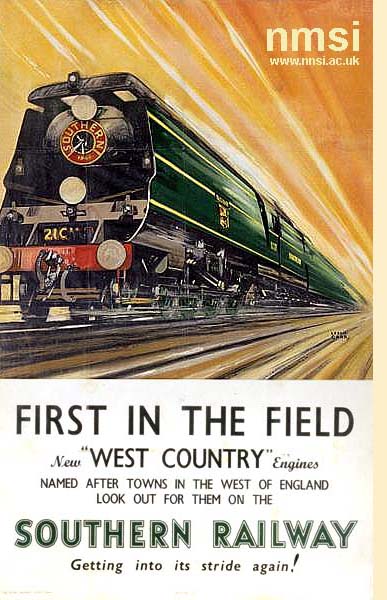 each driving axle, the Light Pacifics could be used almost anywhere on Southern Railway routes where the heavier Merchant Navy engines were prohibited. The first Light Pacifics were intended for use on the restricted secondary routes serving the West of England, hence the Southern Railway named them the 'West Country' class. Sixty six locos were built between 1945 and 1950 and all carried names associated with towns and beauty spots in the west of England.
each driving axle, the Light Pacifics could be used almost anywhere on Southern Railway routes where the heavier Merchant Navy engines were prohibited. The first Light Pacifics were intended for use on the restricted secondary routes serving the West of England, hence the Southern Railway named them the 'West Country' class. Sixty six locos were built between 1945 and 1950 and all carried names associated with towns and beauty spots in the west of England.
(Left) This evocative 1946 Southern Railway poster by Leslie Carr - 'First in the Field' - shows the SR's publicity machine at work. The accompanying text reads - 'New West Country Engines, named after towns in the West of England, Look out for them on the Southern Railway'. The bottom line reads - 'Getting into its stride again!' - a reference to the company's endeavor to shake off the post-war doldrums. This is just one of the stunning images from the NMSI collection. For the record, the NMSI family is comprised of four award-winning museums, each with their own diverse identity: the Science Museum, the National Media Museum and, of course, the National Railway Museum (NRM) at York which houses the world's pre-eminent railway collection. The NRM is spread across three halls: the Great Hall - formerly the steam engine shed (50A) - complete with a working turntable, while the Station Hall (previously York's central goods depot) is now laid out like a 'period' railway station. However, the NMSI's full collection is so big that only 8% of the artefacts are on public view, but enthusiasts are amply compensated by the NMSI Collections Online, which is a superb website displaying countless thousands of objects including a range of fabulous railway travel posters....
The remaining 44 Light Pacifics were built between 1946 and 1951 for services on the Eastern Section, an area abounded by RAF airfields during the Second World War, thus they were all given Battle of Britain names. The BB and WC class locos were originally built with air smoothed casing and incorporated the same novel features as the heavier Merchanty Navy class, including chain-driven valve-gear, inside motion enclosed in an oil bath and American-style box section wheels to eliminate hammer blow to the track. In 1957 a decision was taken to rebuild the Light Pacifics into more conventional locomotives with lower boiler pressure, Walschaerts valve gear, multiple-jet blastpipe and the removal of air smooth casing. The work was carried out under the direction of R G Jarvis, but with the imminent demise steam looming the rebuilding programme was terminated and only sixty Light Pacific locomotives were rebuilt. 
(Inset-Below) As mentioned above Weymouth Loco shed was recoded 70G from September 1963 up to closure of steam in July 1967. During this period it was responsible for 24 locos, half of which were Bullied Merchant Navy' Pacifics. (Below) It's all over for 'Merchant Navy' Class Pacific No 35030 'Elder-Dempster 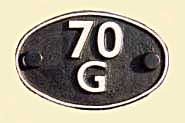 Lines' which looks in a sorry state awaiting its fate. Built at Eastleigh Works in April 1949 to Order HO3393, the loco returned to the works for a rebuild in April 1958. Latterly a Nine Elms, Weymouth and finally Nine Elms engine, it was withdrawn in July 1967 and broken up by Buttigiegs at Newport late in 1968. The inset photo of the cast brass nameplate (courtesy Colour-Rail) shows the target shape with enamel centre and the 'Elder-Dempster Line' red ensign with a gold crown on a pale green background. No 35030 is distinguished as having worked the last steam hauled train on the Southern Region from Weymouth to Waterloo on 9th July 1967.
Lines' which looks in a sorry state awaiting its fate. Built at Eastleigh Works in April 1949 to Order HO3393, the loco returned to the works for a rebuild in April 1958. Latterly a Nine Elms, Weymouth and finally Nine Elms engine, it was withdrawn in July 1967 and broken up by Buttigiegs at Newport late in 1968. The inset photo of the cast brass nameplate (courtesy Colour-Rail) shows the target shape with enamel centre and the 'Elder-Dempster Line' red ensign with a gold crown on a pale green background. No 35030 is distinguished as having worked the last steam hauled train on the Southern Region from Weymouth to Waterloo on 9th July 1967. 
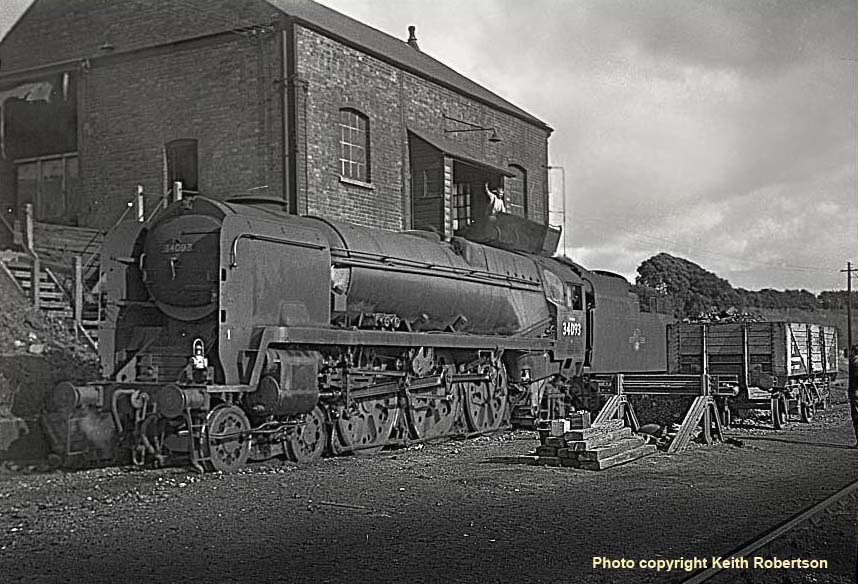
(Above-Inset-Below) The little Polish coalman 'Stan' Stanko gives a cheery wave as he coals 'West Country' class 34093 'Saunton' at Weymouth loco. Built at Brighton in October 1949 the loco was withdrawn in July 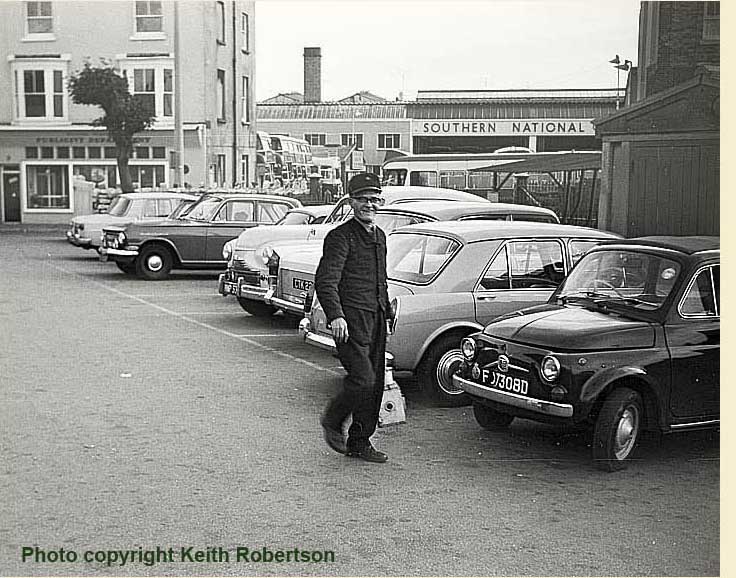 1967...the removal of the air smooth casing certainly made a remarkable difference to the looks of Bulleid's Pacifics. (Inset Left) During the mid-Sixties all railway staff had been issued with the new uniform and continental-style headgear. Here a Weymouth porter can be seen on the concourse in his new uniform carrying a stop lamp. The Southern National bus garage can be seen in the background...note the 1960's motor cars! The times were certainly changing, particularly for enginemen. Within a couple of years after the demise of steam more savings were being sought and time was called on the second-man (the former indispensable fireman) when it was agreed that the guard could undertake any of the second-mans duties such as train protection and the like. (Below) Three Mk1 coaches is child's play for this Class 47 Brush as it passes beneath the locally-named 'Skew Bridge' on the climb out of Weymouth; in the background can be seen the Spa Road Bridge and Radipole Halt.
1967...the removal of the air smooth casing certainly made a remarkable difference to the looks of Bulleid's Pacifics. (Inset Left) During the mid-Sixties all railway staff had been issued with the new uniform and continental-style headgear. Here a Weymouth porter can be seen on the concourse in his new uniform carrying a stop lamp. The Southern National bus garage can be seen in the background...note the 1960's motor cars! The times were certainly changing, particularly for enginemen. Within a couple of years after the demise of steam more savings were being sought and time was called on the second-man (the former indispensable fireman) when it was agreed that the guard could undertake any of the second-mans duties such as train protection and the like. (Below) Three Mk1 coaches is child's play for this Class 47 Brush as it passes beneath the locally-named 'Skew Bridge' on the climb out of Weymouth; in the background can be seen the Spa Road Bridge and Radipole Halt. 

(Above-Below) Gresley Class A3 No 4472 'Flying Scotsman' visits Weymouth on 12th September 1965 with the Gainsborough Model Railway Society's raitour from London Waterloo to Weymouth. The returning leg from Weymouth was via Yeovil and Reading to Paddington. 4472 passes under Alexander Bridge ogled by spotters as she heads in to Weymouth Loco for servicing. 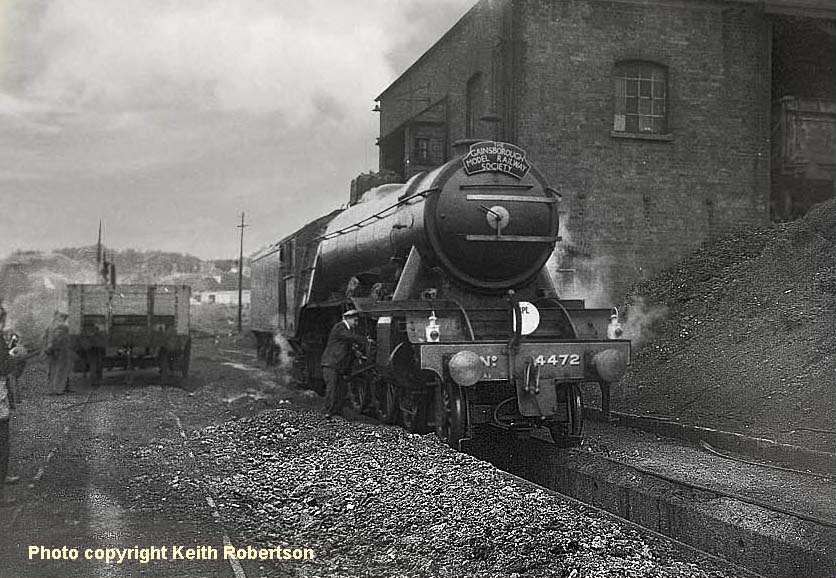
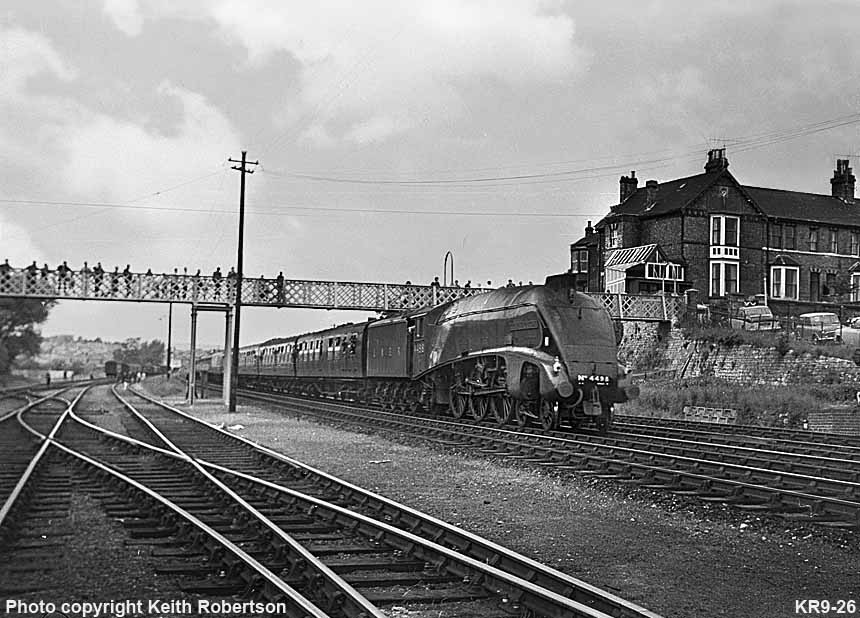
(Above) And another 'foreign' interloper runs under Alexander Bridge into Weymouth, the famous Class A4 No 4498 Sir Nigel Gresley. Withdrawn from traffic on 1st February 1966, the loco was rescued by the A4 Preservation Society, later renamed the A4 Locomotive Society, who moved their prized asset for refurbishment to Crewe Works where another withdrawn A4 60026 Miles Beevor became the doner of three pairs of 6 ft 8 in driving wheels to 60007. The newly restored Sir Nigel Gresley left the works on 1st April 1967 and hauled the 'Inaugural Run of Class A4 Pacific' railtour to Carlisle via Shap, with the return leg via the Settle and Carlisle. Meanwhile electrification of the Bournemouth route was due to commence on 9th July and with the imminent demise of steam, Sir Nigel visited the Southern for a weekend of railtours organised  by the A4 Locomotive Society on the 3rd-4th June 1967. On the Saturday 4498 shared the railtour with No 34023 Blackmore Vale, which at the time was the final unrebuilt Bulleid Pacific still in traffic. The A4 covered the leg between Waterloo and Bournemouth, and Salisbury to Waterloo while 34092 hauled the railtour between Southampton Central and Salisbury. On the Sunday, 4498 went from Waterloo to Weymouth and return.
by the A4 Locomotive Society on the 3rd-4th June 1967. On the Saturday 4498 shared the railtour with No 34023 Blackmore Vale, which at the time was the final unrebuilt Bulleid Pacific still in traffic. The A4 covered the leg between Waterloo and Bournemouth, and Salisbury to Waterloo while 34092 hauled the railtour between Southampton Central and Salisbury. On the Sunday, 4498 went from Waterloo to Weymouth and return.
(Inset-Below) Fireman Clive True is looking out of the cab side window of BB Class No 34052 'Lord Dowding' passing Dorchester Junction signal box while returning to Weymouth light engine after working an up fruit van train to Westbury. Clive's father was a signalman at Maiden Newton, the signal box can be seen in a later shot by Keith (below) featuring condemned locos moving through Maiden Newton station. Clive remained on the railway completing his railway service as a driver at Weymouth. Sadly, Lord Dowding did not escape the cutters torch. Built at Brighton Works as 21C152 in December 1946, the loco was rebuilt in September 1958. No 34052 had the dubious distinction of being the last 'Battle of Britain' class to run on British Rail on 9th July 1967, marking the end of steam on the Southern Region.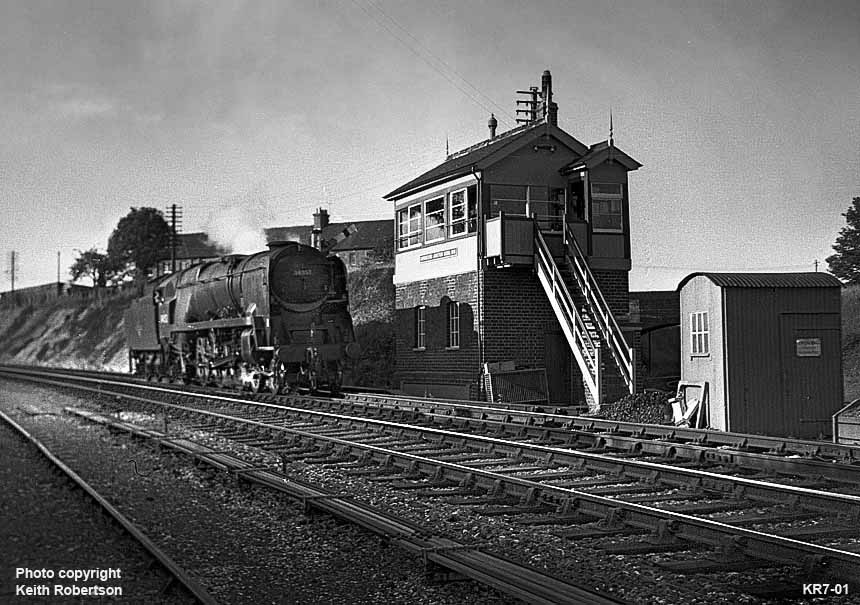
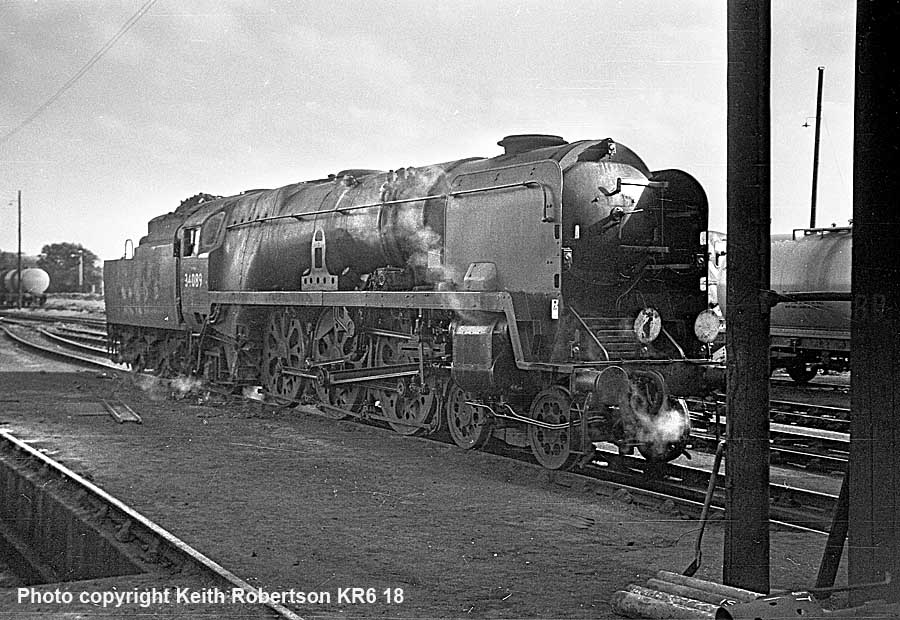
(Above-Below) Bulleid's 'Battle of Britain' class No 34089 was built at Eastleigh in December 1948, rebuilt in August 1960 and withdrawn from traffic in July 1967. The loco was named after the 602 Squadron, a Royal Auxiliary Air Force group originally formed in 1925 as a Light Bomber Squadron. The role of the Squadron changed in 1939 to that of a Fighter Squadron and during World War II flew Spitfires and played a major role in the Battle of Britain, spending the early part of the war on defensive duties in Scotland. In August 1940 the squadron moved south to join the battle with the Lutwaffte in the skies over Kent and from June 1944 operated from advance airfields in Normandy following the Army's advance into Belgium until September. On returning to the UK operations were carried out against V2 sites in Holland before disbanding on 15th May 1945 at RAF Coltishall. (Below) To be captioned...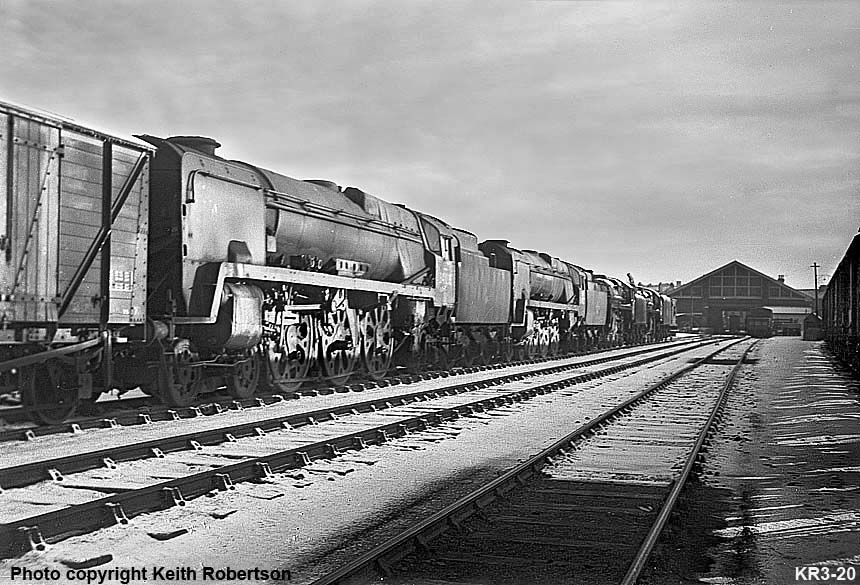

(Above-Below) Many summer excursions ran into Weymouth during the summer months; they arrived via the old GWR line from Swindon, Bristol, Wolverhampton and Birmingham and so it was not unusual to see trains headed by former LMSR locomotives, such as the Stanier Black Fives. Sporting a Nuneaton (2B) shedcode on the smokebox door, No 44691 is making a determined charge through Radipole Halt for the climb of Bincombe-Upwey bank. Other infiltrators included the Stanier 8Fs, BR Standard 9Fs and GWR 8Fs on heavy freight schedules. Adding to the loco variety during the late Fifties were the Southern King Arthur, Lord Nelson and the occasional School classes, all this mixed in with the GWR Halls, Castles, Manors and Grange classes together with Standard 5s, GWR Moguls, Prairies, Panniers and 1400 class tanks engines, but the GWR Kings were not permitted into Weymouth at the time due to axle loadings over a couple of bridges. (Below) Standard 76031 is waiting to leave Weymouth loco for the town station. A popular venue for spotters is Alexander Bridge just visible in the background. 

(Above-Inset-Below) Following BR's decision to dispense with steam in its entirety the daily routine for enginemen changed massively from the manual labour they were used to. No more 'Merchant Navy' or  'Castle' class engines to get the best out of...for Weymouth crews it was either a Crompton electro diesel or Hymek diesel hydraulic, which, in the simplest of terms (okay, I'll be hauled over the coals for saying this) but compared to preparing a steam loco a diesel required little more than pushing of a button to start the engine. If it fired up all was fine, but due to the complexity of diesel traction even a minor fault could bring the job to a complete standstill. Denis Turner can recall an occasion when he was a second man on a Hymek and spent the whole trip in the noisy engine room changing gear by hand because the hydraulics had failed. Indeed when a problem manifested itself on a diesel there was little a crewman could do to nurse the loco to its destination except pray for a following wind! Another task for the second man was the steam heating boiler. There were two different boilers on the Hymek, a Stone-Vapor boiler and the Spanner Mk IIIA train heating boiler, which were a devil of a job to get started. If they fired up first time all well and good, but if it took two or three goes resulting in over-priming with diesel fuel...then whooomph!...they would chuck out as much black smoke as any steam engine using Welsh coal! In BR's drive towards standardising its diesel fleet the Hymeks met with an early demise, the first two, Nos D7006 and D7081, being withdrawn in September 1971 and by March 1975 all had gone. In Keith's shots (above and below) D7006 and D7021 look fresh out of the box.
'Castle' class engines to get the best out of...for Weymouth crews it was either a Crompton electro diesel or Hymek diesel hydraulic, which, in the simplest of terms (okay, I'll be hauled over the coals for saying this) but compared to preparing a steam loco a diesel required little more than pushing of a button to start the engine. If it fired up all was fine, but due to the complexity of diesel traction even a minor fault could bring the job to a complete standstill. Denis Turner can recall an occasion when he was a second man on a Hymek and spent the whole trip in the noisy engine room changing gear by hand because the hydraulics had failed. Indeed when a problem manifested itself on a diesel there was little a crewman could do to nurse the loco to its destination except pray for a following wind! Another task for the second man was the steam heating boiler. There were two different boilers on the Hymek, a Stone-Vapor boiler and the Spanner Mk IIIA train heating boiler, which were a devil of a job to get started. If they fired up first time all well and good, but if it took two or three goes resulting in over-priming with diesel fuel...then whooomph!...they would chuck out as much black smoke as any steam engine using Welsh coal! In BR's drive towards standardising its diesel fleet the Hymeks met with an early demise, the first two, Nos D7006 and D7081, being withdrawn in September 1971 and by March 1975 all had gone. In Keith's shots (above and below) D7006 and D7021 look fresh out of the box.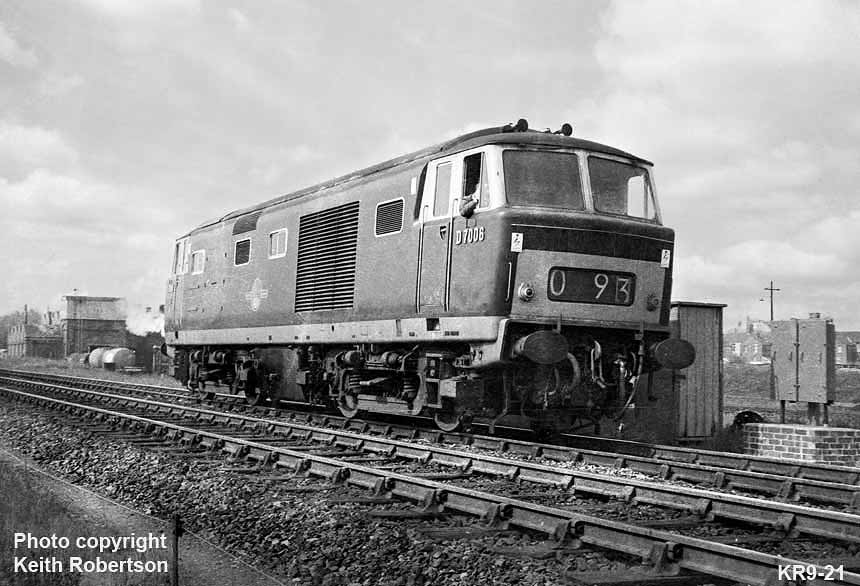

(Above-Below) Weymouth arrivals and departures: with the transition from steam gathering pace the 'Cromptons' took over the 'push-pull' duties on the service between Weymouth and Bournemouth which at that time had yet to be electrified. The Weymouth section would attach to the waiting electric stock at Bournemouth where the Crompton loco would be detached for the return trip to Weymouth. So it was that the loco was always at the rear of the train to Bournemouth and at the front on its return to Weymouth. 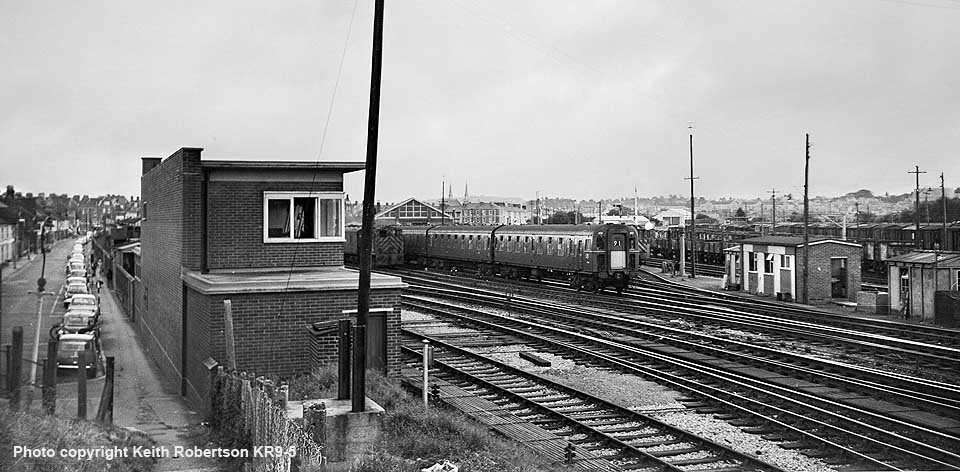

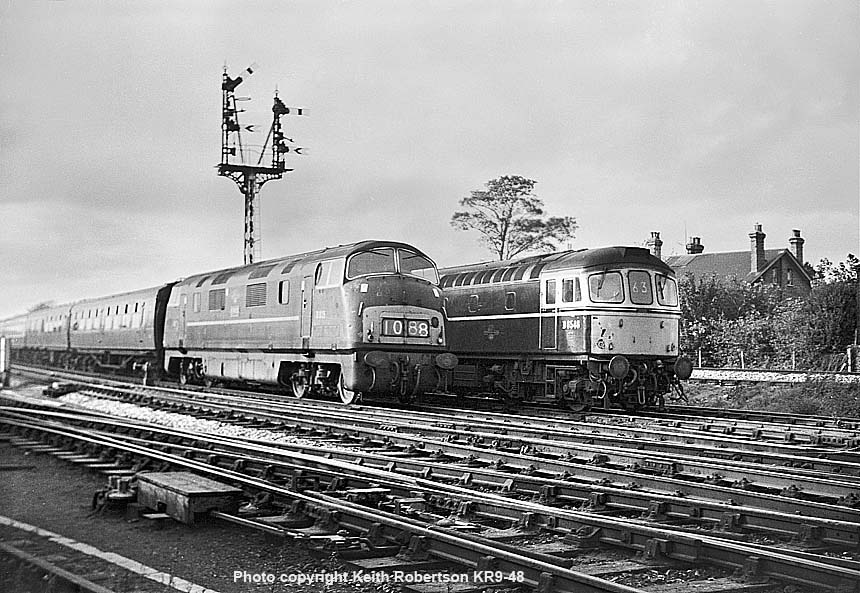

(Above-Below) The D800 series diesel-hydraulic 'Warship' class was constructed by two different builders. When BR launched its Total Operations Processing System (TOPS) the BR Swindon-built locomotives Nos D800-D832 and D866-D870 became Class 42, whereas those built by NBL numbered D833-D865 in the fleet became Class 43. Both 'Western' and 'Warship' class diesel hydraulics made the occasional foray into Weymouth as Keith's pictures show. (Above) Class 43 Warship D864 'Zambesi' arrives at Weymouth with a down goods. Weymouth goods depot is in the background and there is still a feeling of business as usual although it was all soon to disappear. At one time GWR 'Scammel' lorries would have busied about in the yard. Note the 1965 registered Hillman Minx parked on the former closed passenger platform (Below) An unidentified 'Western' class possitively gleams in the company of rundown steam locos at Weymouth.
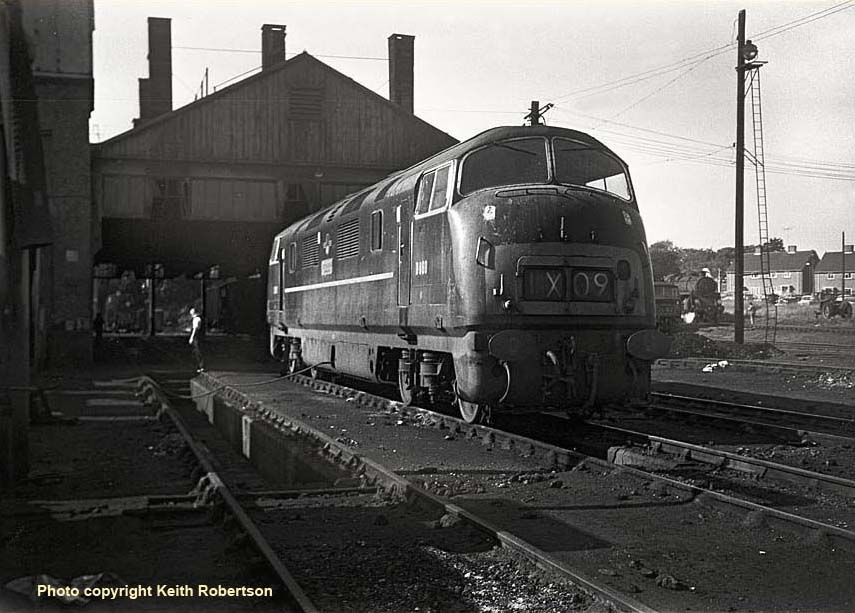
(Above-Below) D860 'Victorious' refuels at a very run down Weymouth Loco shed. In operational service, the NBL-built Class 43 locomotives were less reliable than their Swindon-built cousins due to various factors; mild steel was used for the exhaust manifolds and these components were prone to fracture. Not 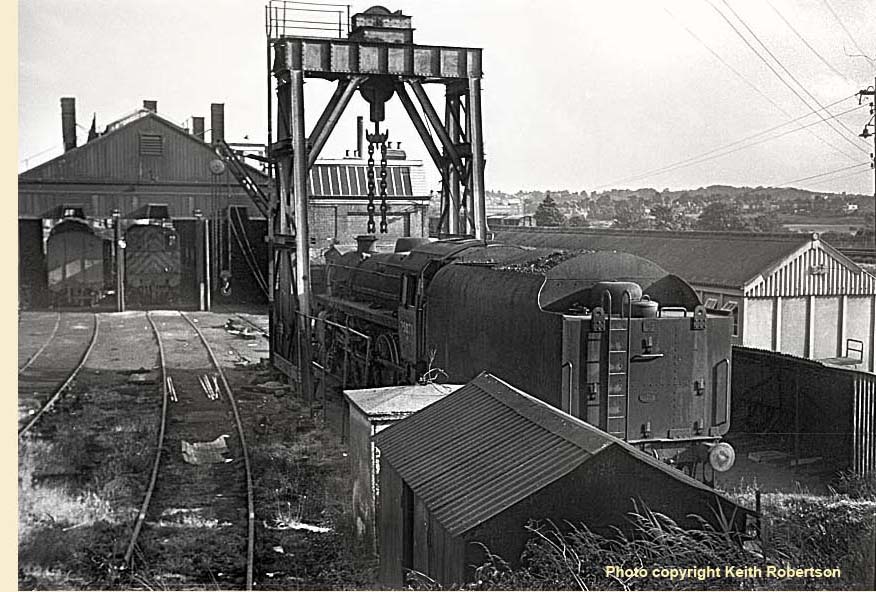 only did this result in a loss of exhaust pressure to drive the turbochargers but also the driving cabs rapidly filled with exhaust fumes. The engine also suffered from being quite highly rated for a design with no active piston cooling, therefore piston ring life expectancy was decreased as a result. Despite all this the figures for 1965 show that the North British Warships covered a far greater annual mileage than contemporary type 4's such as the Westerns, Peaks and Brush type 4, but being non-standard it came as no surprise that a decision was taken to dispense with them. D860 was cut up at Swindon in December 1971 after less than ten years in service. (Below) Indeed the more powerful 'Western' class C-C diesel hydraulic fleet was also doomed to a short life because of the decision to standardise on diesel-electric transmission for mainline locomotives...unlike the MN Class No 35007 in the background, which entered traffic in June 1942 and was named 'Aberdeen Commonwealth' on 30th of the following month. Rebuilt in May 1958, the engine lasted to the very end of SR steam on 9th July 1967.
only did this result in a loss of exhaust pressure to drive the turbochargers but also the driving cabs rapidly filled with exhaust fumes. The engine also suffered from being quite highly rated for a design with no active piston cooling, therefore piston ring life expectancy was decreased as a result. Despite all this the figures for 1965 show that the North British Warships covered a far greater annual mileage than contemporary type 4's such as the Westerns, Peaks and Brush type 4, but being non-standard it came as no surprise that a decision was taken to dispense with them. D860 was cut up at Swindon in December 1971 after less than ten years in service. (Below) Indeed the more powerful 'Western' class C-C diesel hydraulic fleet was also doomed to a short life because of the decision to standardise on diesel-electric transmission for mainline locomotives...unlike the MN Class No 35007 in the background, which entered traffic in June 1942 and was named 'Aberdeen Commonwealth' on 30th of the following month. Rebuilt in May 1958, the engine lasted to the very end of SR steam on 9th July 1967.
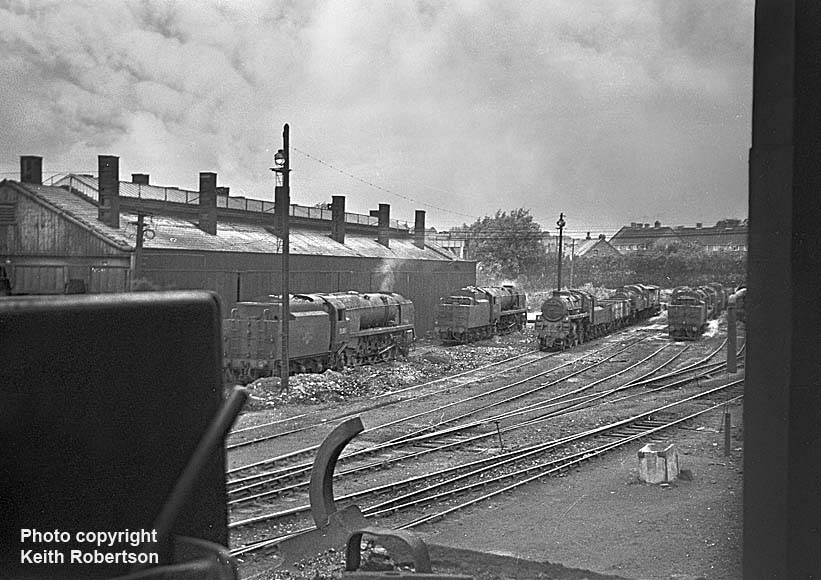
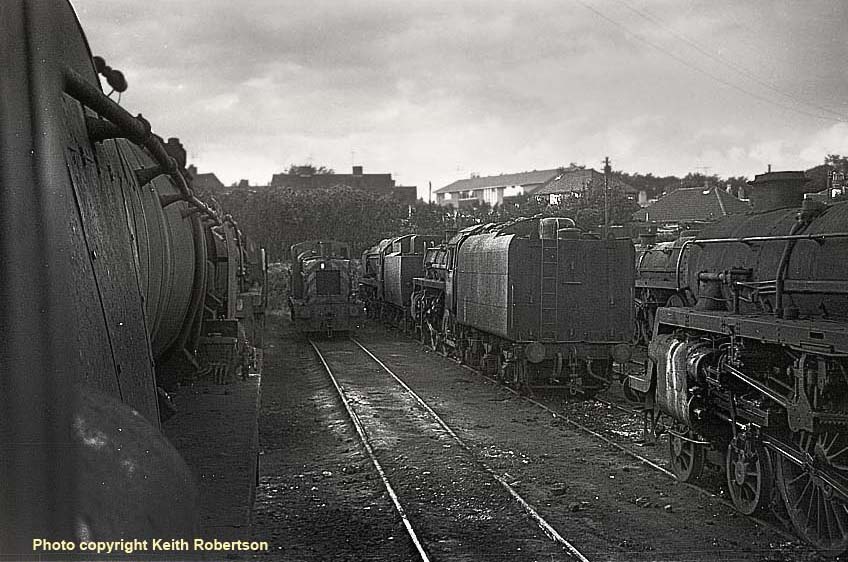
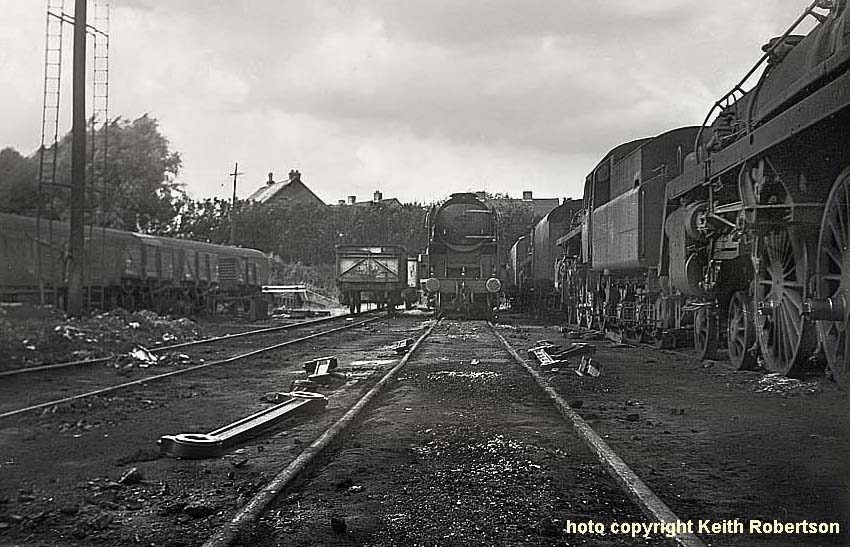

(Above-Below) Most of the passenger work on the 'western' route to Westbury, Bath and Bristol was now being worked by diesel multiple units, DMU's. They were also put to work on the Bridport branch prior to its closure running a service between Maiden Newton and Bridport. Passengers await the arrival of a down DMU running into platform two. Platform one on the left had by now been closed and its rails lifted, the beginning of the end... (Below) Numbered D2000-D2199 and D2370-D2399 in the fleet, the Class 03 shunter was one of BR's most successful small 0-6-0 diesel-mechanical shunters; their short wheelbase and light weight enabled them to operate shunting duties at locomotive and carriage depots and as station pilots. A total of 230 were built by BR Swindon and Doncaster Works between 1957-1962. However, the reduction in the demand for shunting locomotives led the the class being progressively withdrawn from 1968 onwards, many being sold to private industry. Despite the limited scope for the use of such a small locomotive on main line passenger duties, the Southern Region Class 03s based at 71G worked the Channel Island boat trains through the streets to the harbour along the Weymouth Quay tramway.
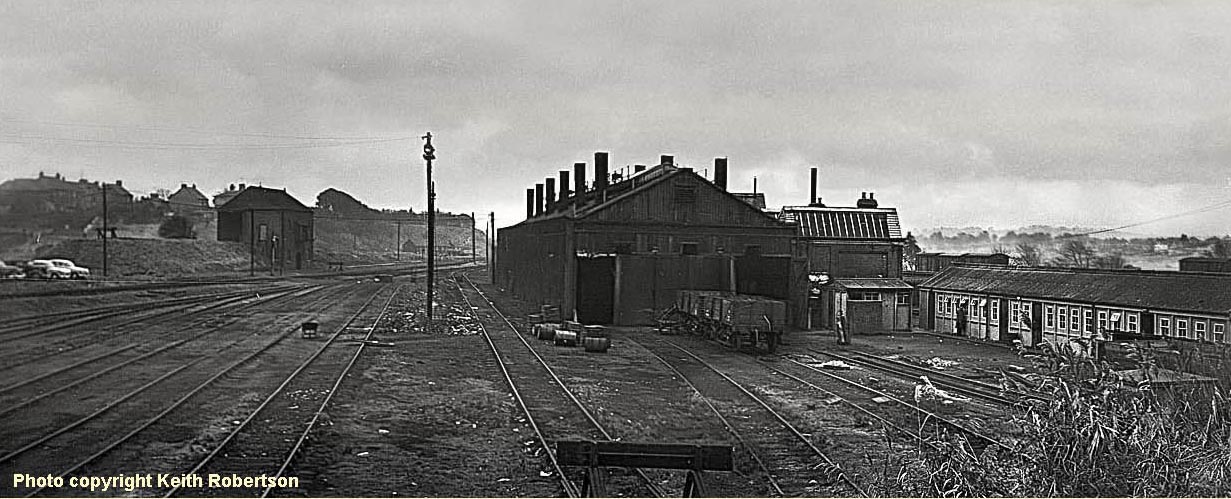
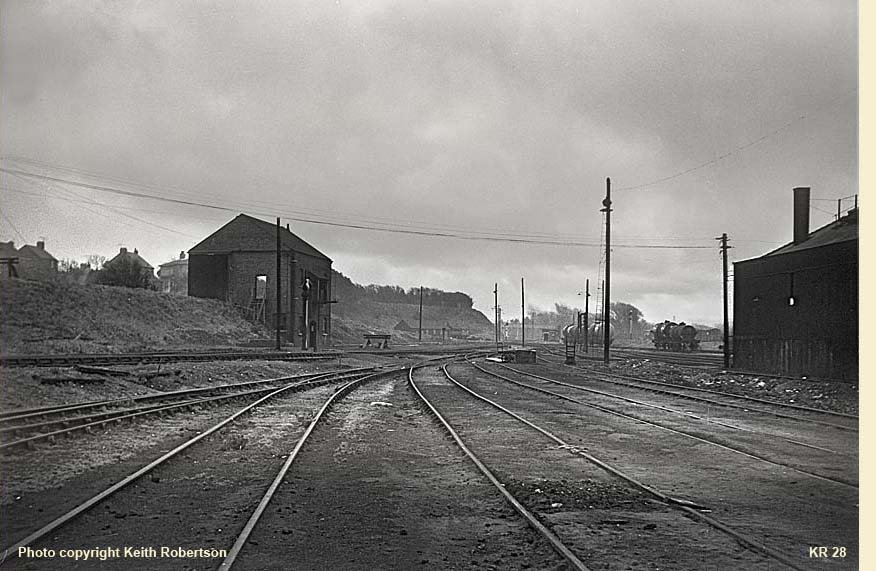 (Above-Left-Below) For someone who had grown up in that place and made some very good friends there, to see it in such a state of decay was tragic for Southern Region enginemen like Denis Turner. Indeed by the time these photos were taken, all of the fitters, boilersmiths, steam-raisers, fire droppers, coalmen and all other ancillary staff had been made redundant. The engine crews had been relocated to a small mess room area at Weymouth Station where they started and finished work. On the right can be seen the concrete mess-rooms the first part of which was provided for the fitters and boilersmiths. The second half was provided for the enginemen and as you walked in the door directly in front of you there was a small kitchen area with a stove on which sat a large kettle that was kept topped up and continually boiling so that water was always available for a brew. The small concrete structure with the door facing was the toilet
(Above-Left-Below) For someone who had grown up in that place and made some very good friends there, to see it in such a state of decay was tragic for Southern Region enginemen like Denis Turner. Indeed by the time these photos were taken, all of the fitters, boilersmiths, steam-raisers, fire droppers, coalmen and all other ancillary staff had been made redundant. The engine crews had been relocated to a small mess room area at Weymouth Station where they started and finished work. On the right can be seen the concrete mess-rooms the first part of which was provided for the fitters and boilersmiths. The second half was provided for the enginemen and as you walked in the door directly in front of you there was a small kitchen area with a stove on which sat a large kettle that was kept topped up and continually boiling so that water was always available for a brew. The small concrete structure with the door facing was the toilet  block. Behind the toilet block can be seen the roof of the fitting shop and the chimney of the stationary boiler. Outside of the cabin was the lifting road but in Keith's shot the lifting gear has already been removed. The loco sidings now stand empty to the left of the sheds but the coaling stage can be clearly seen in the middle distance. (Inset Right) On a lighter note, this GWR red painted, wooden coal bucket, beautifully painted in yellow lettering with black shadow 'GWR WEYMOUTH LOCO' went under the hammer for £310 at a GW Railwayana Auction in May 2010. The vendor was Shedmaster at Weymouth in the early 1960's and rescued it from oblivion...an odd artefact to take home as a memento. It shows someone cared!
block. Behind the toilet block can be seen the roof of the fitting shop and the chimney of the stationary boiler. Outside of the cabin was the lifting road but in Keith's shot the lifting gear has already been removed. The loco sidings now stand empty to the left of the sheds but the coaling stage can be clearly seen in the middle distance. (Inset Right) On a lighter note, this GWR red painted, wooden coal bucket, beautifully painted in yellow lettering with black shadow 'GWR WEYMOUTH LOCO' went under the hammer for £310 at a GW Railwayana Auction in May 2010. The vendor was Shedmaster at Weymouth in the early 1960's and rescued it from oblivion...an odd artefact to take home as a memento. It shows someone cared! 

(Above-Below) The empty loco coal sidings and the vacant stare of the coal stage with a 'sleeper road' in the foreground built for the demolition vehicles....and below is the abandoned turntable, never to be used again. Enginemen like Denis prefer to remember the place as it once was, a thriving workplace full of animate objects and interesting people...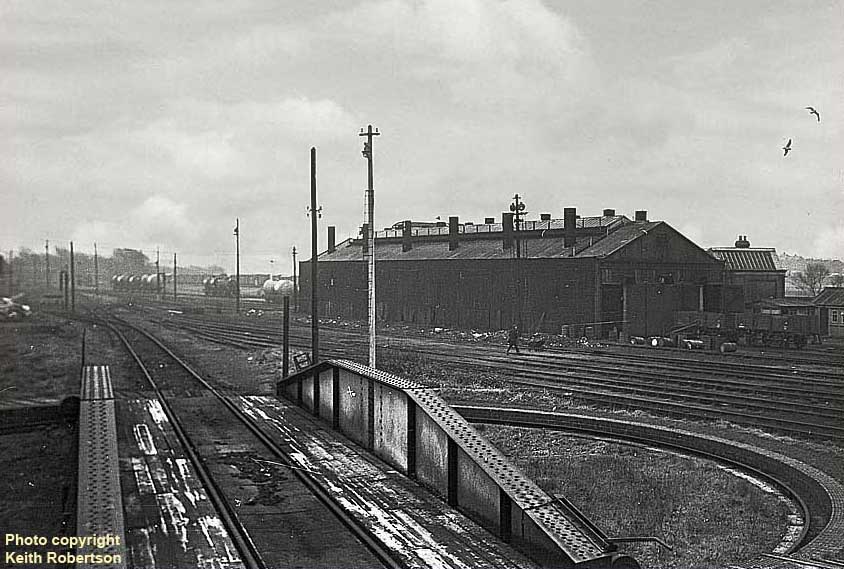
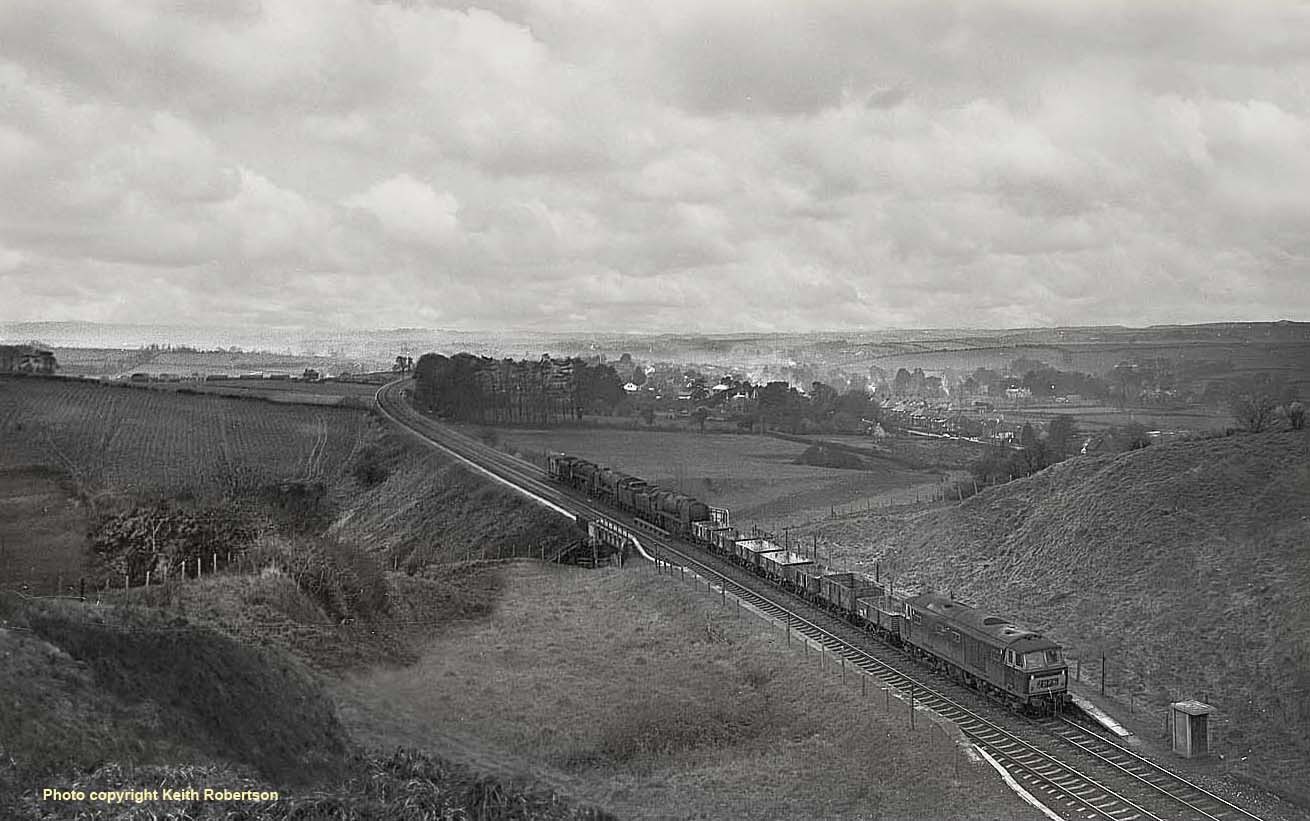
(Above-Inset-Below) It is very much hoped that we can feature more of Keith Robertson's superb photos elsewhere on this site because he is without doubt a fine cameraman who not only recorded the transition  from steam at Weymouth Loco (amongst his collection are classic photos of Hymeks, Warships and Western diesel-hydraulic locos and Deltics taken elsewhere) he also took some heart-rending shots of condemned steam locomotives being towed away from Weymouth to Wales for scrap. His determination to record steam's ultimate fate is epitomised by this series of photos he took in July 1967....see footnote below.. The cortege of locos was made up of Rebuilt 'West Country' class Pacifics No 34093 Saunton and 34095 Brentor, both engines built at Brighton in October 1949, and BR Standard Class 5MT No 73092, built at Derby in October 1955 and withdrawn from traffic in July 1967 after only 8 years of service. Keith chased the train all the way from Weymouth to Westbury. In this panoramic shot of Upwey Wishing Well Halt, the spectacular backdrop of Weymouth Bay and Portland offers little in the way of compensation as Hymek class No D7013 tows 34093, 34095, 73092 up
from steam at Weymouth Loco (amongst his collection are classic photos of Hymeks, Warships and Western diesel-hydraulic locos and Deltics taken elsewhere) he also took some heart-rending shots of condemned steam locomotives being towed away from Weymouth to Wales for scrap. His determination to record steam's ultimate fate is epitomised by this series of photos he took in July 1967....see footnote below.. The cortege of locos was made up of Rebuilt 'West Country' class Pacifics No 34093 Saunton and 34095 Brentor, both engines built at Brighton in October 1949, and BR Standard Class 5MT No 73092, built at Derby in October 1955 and withdrawn from traffic in July 1967 after only 8 years of service. Keith chased the train all the way from Weymouth to Westbury. In this panoramic shot of Upwey Wishing Well Halt, the spectacular backdrop of Weymouth Bay and Portland offers little in the way of compensation as Hymek class No D7013 tows 34093, 34095, 73092 up  Bincombe Bank. The guards stove is warming him up as can be seen from the smoke issuing out of the chimney. (Below) The cortege trundles through Dorchester West Station with the now disused sidings left and the closed goods shed and cattle dock middle right.
Bincombe Bank. The guards stove is warming him up as can be seen from the smoke issuing out of the chimney. (Below) The cortege trundles through Dorchester West Station with the now disused sidings left and the closed goods shed and cattle dock middle right.
FOOTNOTE - Every day hundreds of thousands of enthusiasts visit the Internet, each with their own diverse interests and all with varying expertise; indeed most visitors use the Internet as a source of reference and so it is essential to get the facts right, therefore I am grateful to Richard Strange, who writes - 'You may be interested in the following correction to shots of a Hymek towing several wagons and 34093/95 and 73092 out of Weymouth. You have said the locos were en route to South Wales for scrapping and dated the several shots as July 1967. In fact the locos were not sold until 18 September 1967, and left Weymouth on 20 January 1968. Oddly enough, the Hymek is sporting the reporting number of 2B75, which is not correct for dead loco haulage on any date at all! I suspect the reporting number had not been changed from a previous working....' 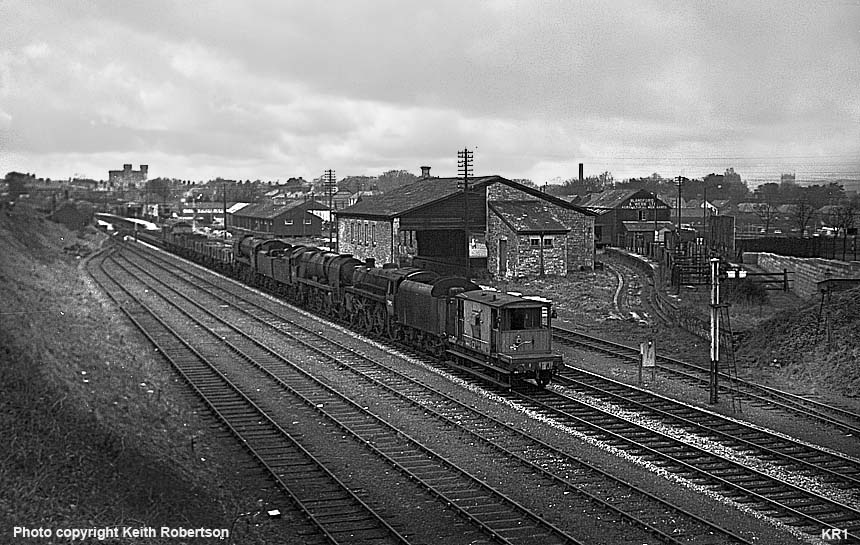

(Above-Below) The poignancy of these photos brings home the absolute carnage that took place within a year or two of steam's demise. As the procession heads through Maiden Newton station, two porters look n  in disbelief, probably in the knowledge that their railway career would soon be over. Not even the Guard's cheery 'thumbs up' gives any comfort. The signal gantry on the down platform controlled access onto the Bridport Branch or back onto the up line towards Yeovil Pen Mill. As a footnote, one of the BR Southern Region totems from Maiden Newton Station sold for £1050 at a GW Railway Auction in May 2010 and at the same auction the smokebox number plate from 73092 sold for £150, albeit the plate was alloy hence identified as a replacement, but it was ex-loco...evidence on the rear shows that it had clearly been carried.
in disbelief, probably in the knowledge that their railway career would soon be over. Not even the Guard's cheery 'thumbs up' gives any comfort. The signal gantry on the down platform controlled access onto the Bridport Branch or back onto the up line towards Yeovil Pen Mill. As a footnote, one of the BR Southern Region totems from Maiden Newton Station sold for £1050 at a GW Railway Auction in May 2010 and at the same auction the smokebox number plate from 73092 sold for £150, albeit the plate was alloy hence identified as a replacement, but it was ex-loco...evidence on the rear shows that it had clearly been carried.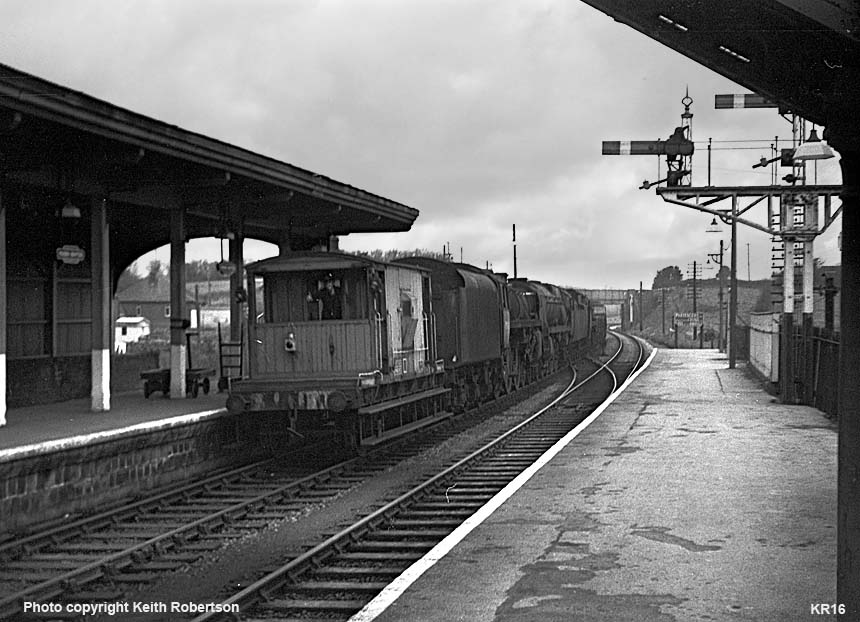
Tim Puffett recently contacted the site - 'Hi David, Just spent a happy hour or so looking through the photos on your Southern Region webpage. What made it so good was the fact that all the Weymouth photos (including the station and particularly the shed) brought back memories of a happier time spent getting absolutely filthy 'spotting' in those locations. I used to 'help' the guys at the coaling tower, filling the little carts from the larger wagons, watering the locos and helping to drop the fires on some occasions. I would even get to drive the locos to the turntable while who I presume was the coal stage guy would walk up to the table and sort the points out for the return to the shed. I recall helping to release baskets full of pigeons at Weymouth station and unloading huge quantities of mail sacks - all with a distinctive smell! I remember helping in the left luggage depot and sticking on little labels using a very bent paintbrush from a huge pot of glue, or collecting lots of old tickets from behind the ticket barrier shelves. I also cadged a 'walk' through various A4 double tenders whilst the locos were visiting Weymouth on steam specials, and crossing under the main line using a 'secret' tunnel we found. The diesel fuel area of shed was like an ice-rink with spilt fuel everywher. I recall putting pennies on the line under Radipole Halt station…the Halt had gaslamps and another peculiar smell from those, all controlled from a small cupboard just inside the door of the shelter. I used to help the porters at the station too, often driving the little battery powered cart which pulled the wire-mesh parcel trucks around the station. All of this when I was around 10-12 years old! In addition to the letter, my thanks to Tim for correcting a few errors in the Weymouth section. 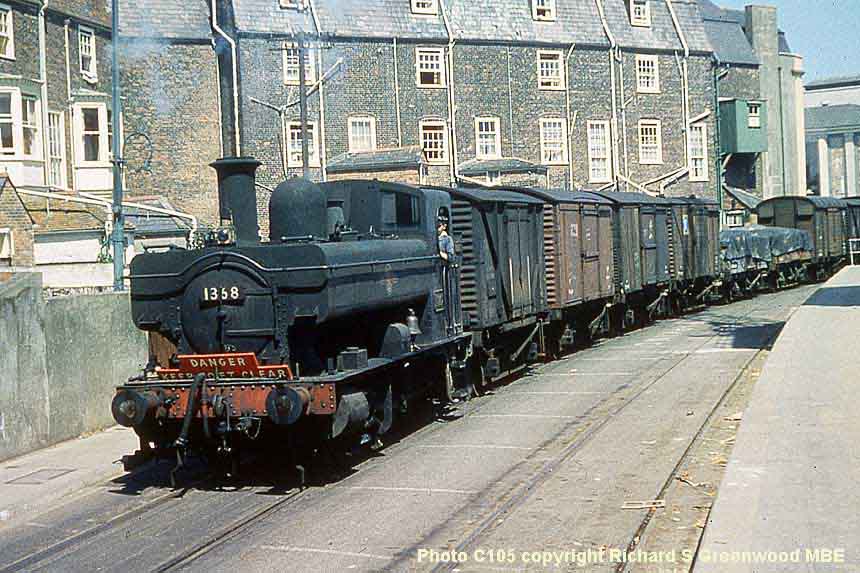
(Above) We take our leave of the Dorset coastal town with this splendid colour shot of the Weymouth Harbour Tramway which ran from a junction just north of Weymouth main line railway station through the streets adjacent to the Backwater and the harbour of Weymouth to the station at Weymouth Quay. Opened in October 1865, the line was operated by various locos including Collett's 0-6-0 pannier tanks. Needless to say, running a standard gauge railway locomotive along a public road gave rise to a different set of rules, not least of which was the requirement for railway staff (the shunters) to precede the train at walking pace with an array of warning devices: waving a red flag, blowing a whistle, ringing a hand bell or swinging a lamp at night. In later years the locos were fitted with a warning bell which the fireman rang continuously as they moved along the road. This can be seen beneath the nearside tank in front of the cab of 1358, in addition to which a warning sign has been mounted above the buffer beam...the Weymouth Harbour Tramway (and Portland Branch) are dealt with in more detail on the 'Southern Region 2' page 31.
AROUND THE REGION

(Above-Below) Introduced in 1930, Richard Maunsell's V Class 'Schools' 4-4-0 was the most powerful 4-4-0 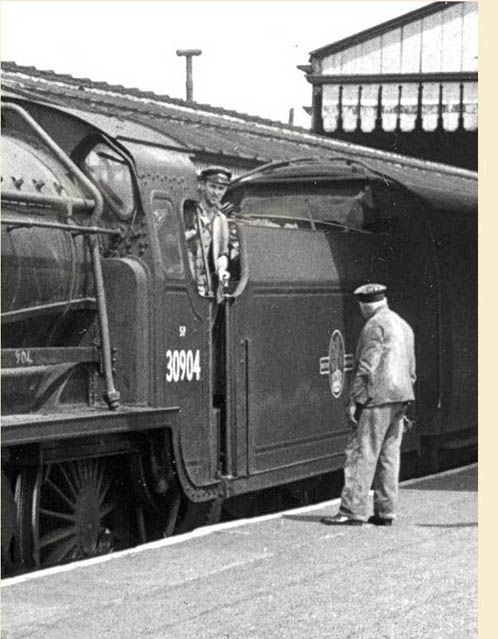 in Europe; its tractive effort even exceeding that of the earlier 'King Arthur' 4-6-0s introduced in 1925. In all, 40 locomotives were built up to July 1935. The SR's network of lines embraced a large number of private and public schools in southern England, hence many passengers were carried to and from these seats of learning; the decision to name the locomotives after these schools proved to be a major marketing success, continuing in the tradition of the names endowed on the N15 'King Arthur' and 'Lord Nelson' classes before them. Here, No 30913 Christs Hospital slows for the Basingstoke stop with an 'up' train in 1960. (Below) This shot of No 30908 Westminster was taken at Basingstoke on the same day. The class was highly regarded by loco crews as they were capable of highly spectacular performances for their size. The fastest recorded speed was 95 mph in 1938 by 928 Stowe pulling a four coach train from Dorchester to Wareham. However there was a drawback with such high power and relatively low weight; when starting the locomotive from a standstill, wheelslips frequently occurred, calling for skilled handling by footplatemen.
in Europe; its tractive effort even exceeding that of the earlier 'King Arthur' 4-6-0s introduced in 1925. In all, 40 locomotives were built up to July 1935. The SR's network of lines embraced a large number of private and public schools in southern England, hence many passengers were carried to and from these seats of learning; the decision to name the locomotives after these schools proved to be a major marketing success, continuing in the tradition of the names endowed on the N15 'King Arthur' and 'Lord Nelson' classes before them. Here, No 30913 Christs Hospital slows for the Basingstoke stop with an 'up' train in 1960. (Below) This shot of No 30908 Westminster was taken at Basingstoke on the same day. The class was highly regarded by loco crews as they were capable of highly spectacular performances for their size. The fastest recorded speed was 95 mph in 1938 by 928 Stowe pulling a four coach train from Dorchester to Wareham. However there was a drawback with such high power and relatively low weight; when starting the locomotive from a standstill, wheelslips frequently occurred, calling for skilled handling by footplatemen.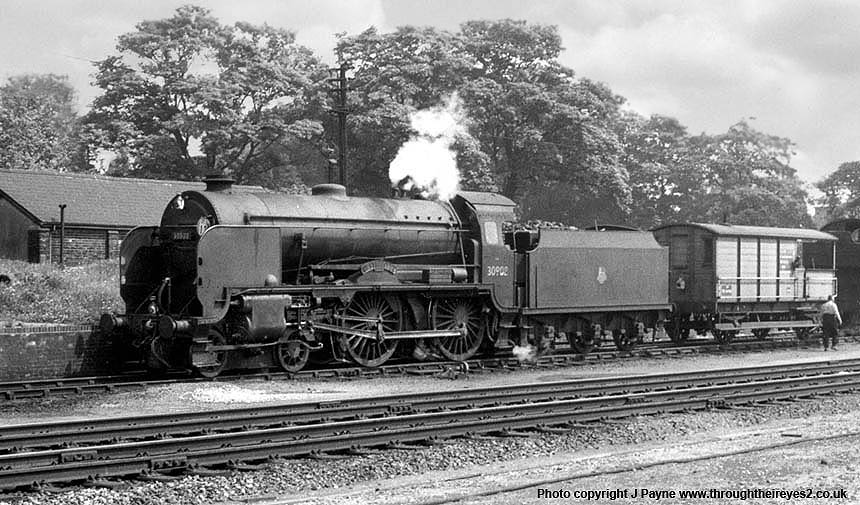
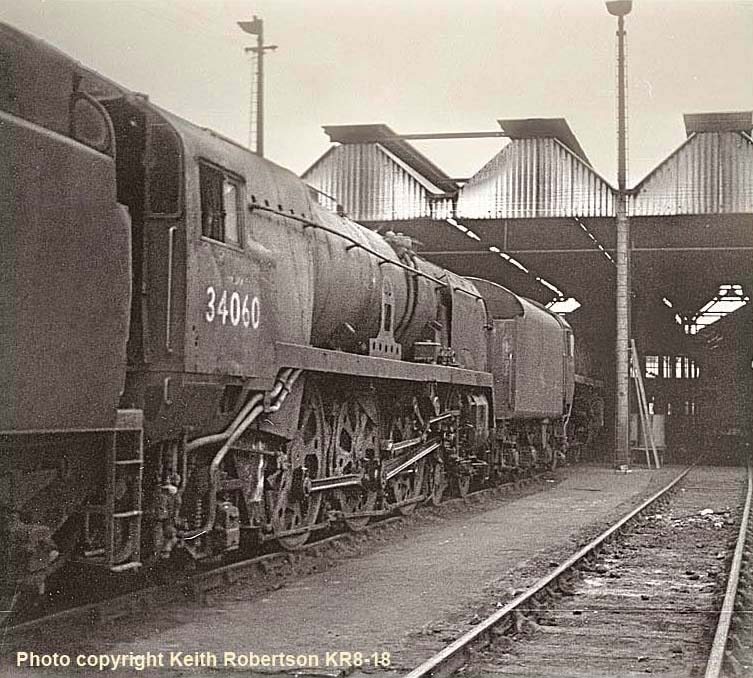
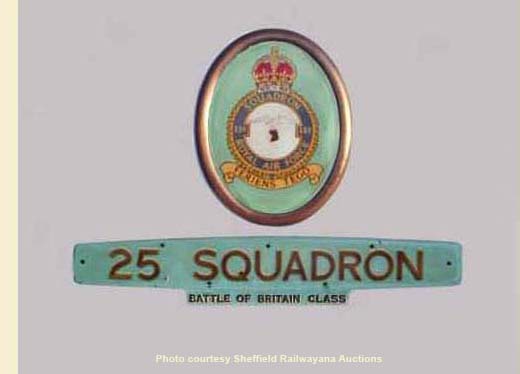 (Above-Inset) Southern Region Memorabilia. A loco nameplate - '25 SQUADRON' - as carried by the Southern Railway's 'Battle of Britain' Class 4-6-2 No 21C160 was sold at Sheffield Railwayana Auctions on 10th September 2011 for £25,000. Click on image (right) to visit the site. Built at Brighton in April 1947, the Bulleid Pacific was renumbered 34060 by British Railways in October 1948 and rebuilt in November 1960. Withdrawn from traffic in July 1967 after completing a mere 934,417 miles in service No 34060 met its fate at John Cashmore's Scrapyard in April the following year. The Sheffield Railway Auction Lot included both a 54" x 9¼" nameplate and matching oval shaped crest with brass edging showing the RAF coat of arms and Roman numerals 'XXV Squadron' plus the motto 'Fereons Tego' (Striking I defend). The 25 Squadron was formed at RAF Montrose in September 1915, moving to France in February 1916 on fighter and reconnaissance duties. During WWII the 25 Squadron flew night patrols, and during the closing stages squadron was almost entirely committed to bomber escort missions. The squadron was eventually disbanded in April 2008.
(Above-Inset) Southern Region Memorabilia. A loco nameplate - '25 SQUADRON' - as carried by the Southern Railway's 'Battle of Britain' Class 4-6-2 No 21C160 was sold at Sheffield Railwayana Auctions on 10th September 2011 for £25,000. Click on image (right) to visit the site. Built at Brighton in April 1947, the Bulleid Pacific was renumbered 34060 by British Railways in October 1948 and rebuilt in November 1960. Withdrawn from traffic in July 1967 after completing a mere 934,417 miles in service No 34060 met its fate at John Cashmore's Scrapyard in April the following year. The Sheffield Railway Auction Lot included both a 54" x 9¼" nameplate and matching oval shaped crest with brass edging showing the RAF coat of arms and Roman numerals 'XXV Squadron' plus the motto 'Fereons Tego' (Striking I defend). The 25 Squadron was formed at RAF Montrose in September 1915, moving to France in February 1916 on fighter and reconnaissance duties. During WWII the 25 Squadron flew night patrols, and during the closing stages squadron was almost entirely committed to bomber escort missions. The squadron was eventually disbanded in April 2008. 
(Above-Below) A locomotive nameplate 'Braunton', with matching 'West Country Class' scroll was sold at a Sheffield Railwayana Auction for £14,000 in January 2008. The nameplate came from the Southern Railway Bulleid 'Light Pacific' 4-6-2 built at Brighton in November 1946, original number 21C146, becoming No 34046 when British Railways was formed. The loco was allocated new to Exmouth Junction, but initially on loan to Salisbury, and moved to Brighton in 1951. In February 1959 it was among the thirty four 'WC' class locos to be rebuilt, involving the removal of its air-smoothed casing and internal chain drive, and allocated to Bournemouth where it spent the remainder of its working life until withdrawal in October 1965. After being stored at Bournemouth shed for several months, 34046 was moved to Dai Woodham's Scrapyard in South Wales where it remained in a deplorable state from 1966 to 1988. It was rescued by preservationists and moved to Brighton where an abortive attempt was made to restore it to working condition. In 1996 it was purchased by the West Somerset Railway Association and then sold to Jeremy Hosking who funded the restoration of 34046 at the West Somerset Railway's Williton Works and in 2007 the loco steamed for the first time since 1965. (Below) 34046 'Braunton' 34026 'Yes Tor' was photographed at Nine Elms by Southern Region engineman Alex (Mac) McClymont.Click here to visit the 34046 Braunton website. 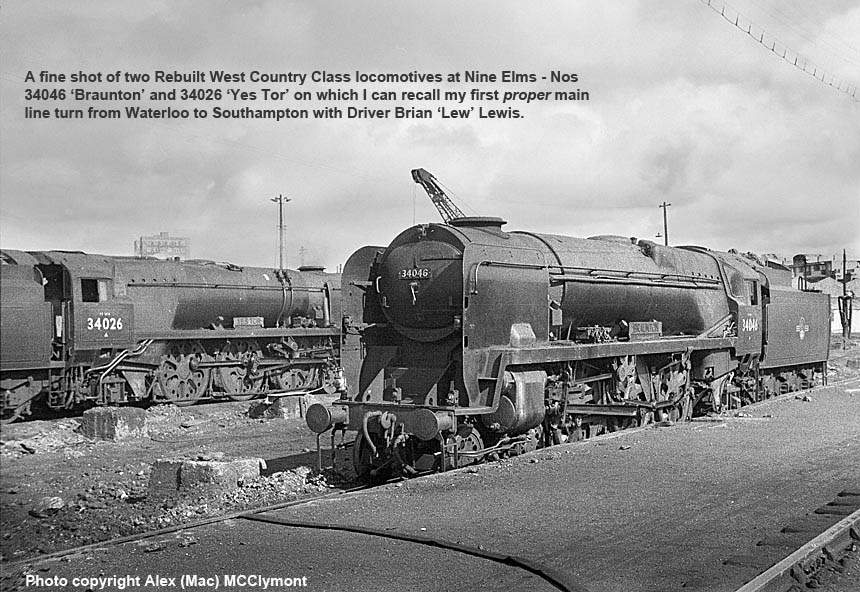
(Right-Below) To complete Mac's picture, a cast brass locomotive nameplate 'Yes Tor' as carried by 34026, was  sold for £14,000 (with no scroll) at a Sheffield Railwyana Auction in March 2010. (Below) Digging through my collection I came across this rare shot of the newly-built 'Yes Tor' at Brighton in March 1946. The loco entered service numbered 21C126. It became 34026 under British Railways and was rebuilt in February 1958. Withdrawn from Salisbury shed in the autumn of 1966, the loco was scrapped by J. Buttigieg at Newport in the following May. For the record, Yes Tor is the second highest point on Dartmoor.
sold for £14,000 (with no scroll) at a Sheffield Railwyana Auction in March 2010. (Below) Digging through my collection I came across this rare shot of the newly-built 'Yes Tor' at Brighton in March 1946. The loco entered service numbered 21C126. It became 34026 under British Railways and was rebuilt in February 1958. Withdrawn from Salisbury shed in the autumn of 1966, the loco was scrapped by J. Buttigieg at Newport in the following May. For the record, Yes Tor is the second highest point on Dartmoor. 
(Below) Staying with Brighton Works...a familiar feature of Bullied's SR Pacifics was their attractive 'Southern' roundels affixed behind the locking handles in the centre of the smokebox door. This can be seen in the shot of newly-built 'Battle of Britain' class No 21C162 (BR No 34062) '17 Squadron' at Brighton in May 1947. However, old photos reveal that Bulleid's first Pacific, 'Merchant Navy' class No 21C 1 'Channel Packet' (built at Eastleigh Works in February 1941) originally carried a plate that resembled an upide down horseshoe. Alas this proved unpopular with superstitous loco crews, which, in view of the conflict with Germany in the 1939-1945 WW2, is hardly surprising. Now I'm not superstitious myself, touch wood, but there is a deep-rooted belief that a horseshoe mounted in the upright position will fill you with good luck whilst an upside down one will drain your luck, hence the offending plate was quickly redesigned. An additional section was cast on the lower half to carry the date of manufacture, which proved the simplest - and most well-rounded - solution to the problem. Comparisons can be made with the digitally-created original in the sky. For the record, 34062 was withdrawn in August 1964 and scrapped at Birds in June the following year.
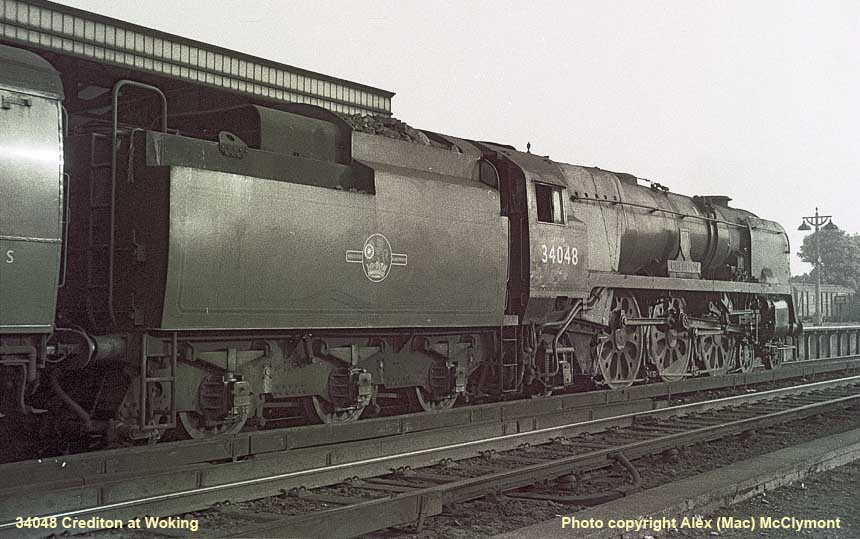
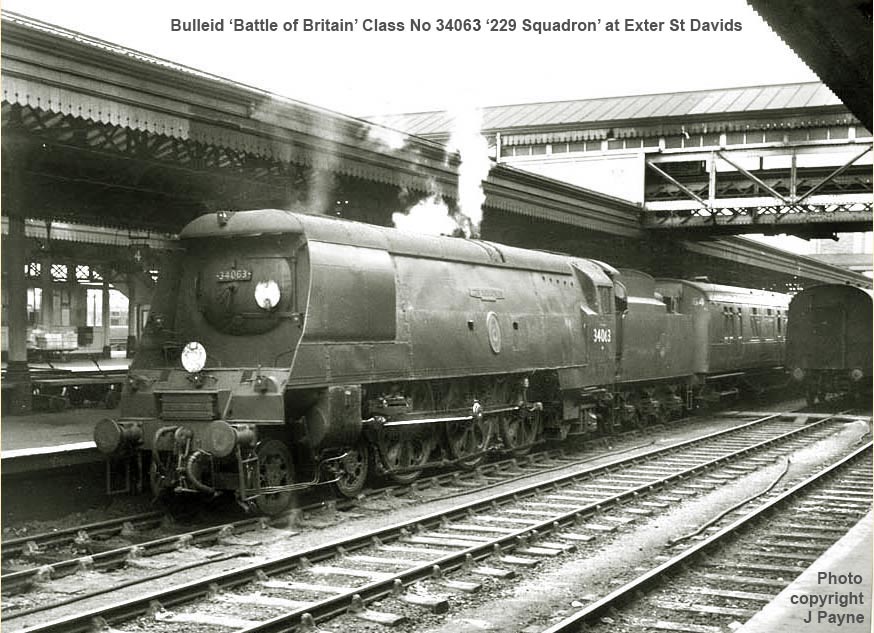
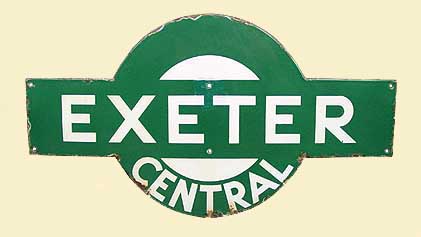 (Above-Below) Exeter Bankers. Introduced in 1929 for heavy shunting duties, Maunsell's eight Class Z 0-8-0Ts were fitted with Walschaerts valve gear; this interesting rear view shot shows Nos 30955-56 on banking duties at Exeter St Davids in 1960. (Below) Having assisted a train up the bank on 14th July 1953, this pair of old timers: Class E1/R No 32135 (a Maunsell rebuild of Stroudley's E1) and Drummond's LSW Class M7 No 30025 run down the steep 1 in 37 gradient from Exeter Central into St Davids in readiness for the next banking task.
(Above-Below) Exeter Bankers. Introduced in 1929 for heavy shunting duties, Maunsell's eight Class Z 0-8-0Ts were fitted with Walschaerts valve gear; this interesting rear view shot shows Nos 30955-56 on banking duties at Exeter St Davids in 1960. (Below) Having assisted a train up the bank on 14th July 1953, this pair of old timers: Class E1/R No 32135 (a Maunsell rebuild of Stroudley's E1) and Drummond's LSW Class M7 No 30025 run down the steep 1 in 37 gradient from Exeter Central into St Davids in readiness for the next banking task.
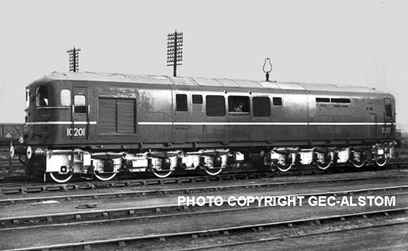
(Above-Below) The SR's Chief Mechanical Engineer, OV Bulleid, had plenty of experience with small-wheel multiple unit motor bogies, but was looking at diesel-electric traction as an alternative to costly third-rail electrification on some west of England routes. The result was the SR/EE Co diesel electric No 10201, built at Ashford works in 1950. The power unit was the same 16-cylinder 16SVT engine as fitted to the LMS Co-Co s Nos 10000/1 (see 'Pioneer Main Line Diesels' Page 8) but equipped with the EE Co's Napier 75100 Turbocharger producing a 1,750hp prototype. The SR locomotives had flat ends with rounded corners, giving them a rather distinctive box-like appearance. However, the subtle body-side contours followed that of traditional Bulleid coaching stock, which was a subtle design touch. Still in workshop grey livery, the first of the SR's main line diesels, No 10201, was photographed at Ashford works prior to completion in November 1950. (Below) The third of Bulleid's diesels No 10203 - with its output raised to 2,000hp - emerged from Brighton Works on March 7th 1954. Here the driver awaits the right away from Waterloo with a West of England express. Photos © GEC-Alstom
In 1948, six new BR Regions were formed, their new boundaries corresponding closely to the lines of the former 'Big Four' railway companies. Britain's railways was now made up of the Western Region, Southern Region, Scottish Region, Eastern Region, North Eastern Region and London Midland Region - the old LNER being divided amongst the two newly-formed Regions - Eastern and North Eastern, whilst the Scottish Region was composed partly of the former LMS and LNER. Over the years, the Regional boundaries diminished significantly as many locomotives (from an operational standpoint) worked beyond their arbitrary Regions, so in many ways it is meaningless to classify any particular class of locomotive as belonging to any one of the six Regions during the transition from steam. For example, it was not unusual for the LMR's Stanier 'Black 5' or Ivatt 2MT tanks to be found working hundreds of miles from the Region they were initially allocated.
Several photos on this page are reproduced courtesy of Jim Payne's CD from his wonderful website 'Through Their Eyes'. Click here for link. I am not affiliated with the sale of CDs in any way, merely reproducing what I think are interesting images of Southern Region steam. A word should be added about Photoshopping - the above images, excellent though the originals are, have been digitally enhanced with sky tones for suitable reproduction on the web. The subject of Photoshopping can be found on the 'Rail Photo Workshop' Page 46 of this site.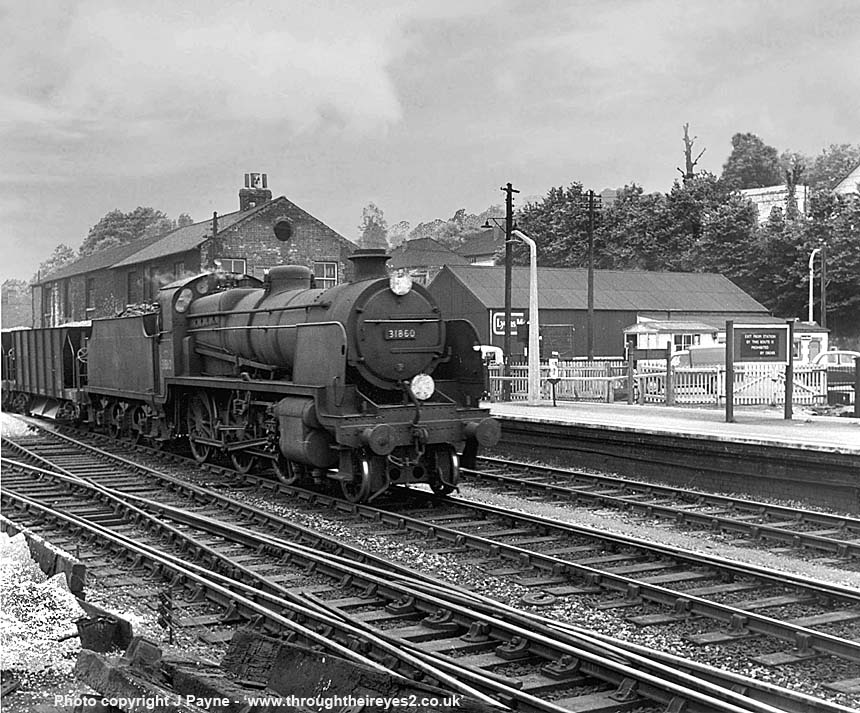
(Above-Below) N Class No 31860 on a ballast train at Exter St Davids Station in 1960. (Below) The Adams Class '0415' 1P 4-4-2Ts were used on suburban work in the London area, but following 3rd-rail electrification a large number were taken out of service and stored at Eastleigh. Three examples were retained by the Southern Railway for working the Lyme Regis branch where the 4-4-2T's flexible wheel base was found ideal for the many curves on the branch. Upon nationalisation, the three engines became Nos 30582-30584 and continued to work the Lyme Regis branch until 1961. The line closed after being taken over by the Western Region and the three engines were subsequently withdrawn. One example, No 30583, was secured for preservation and restored to its old livery as LSWR 488. Photo © D Pritchard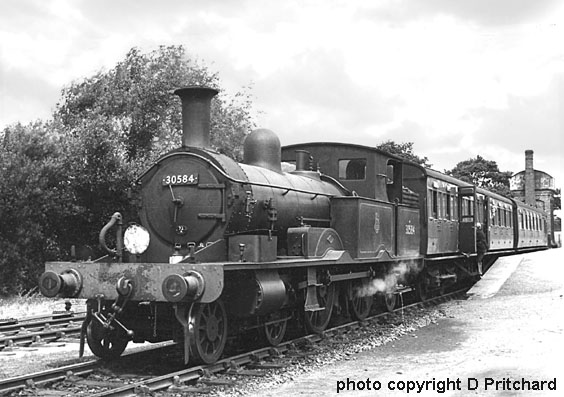
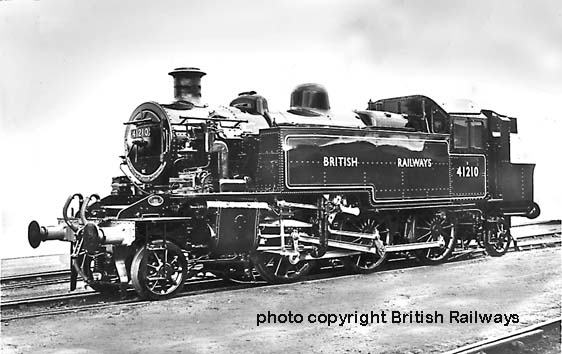
(Above) Introduced to traffic in 1946, Ivatt 2MT 2-6-2T No 41210 was the first of fifty engines (Nos 41210-29/41270-89 and 41320-29) to be fitted with vacuum control gear for push-pull operation. The driver operated th e vacuum controlled auxiliary regulator valves (fitted in each steampipe leading from the header to the cylinders) from a compartment at the head of the train. The fireman remained on the locomotive and communication between the two crewmen was made via a system of bell codes. No 41210 was transferred from the LMR at Warrington to the Southern Region at Eastleigh in December 1962. From there it went to Barnstaple Junction in April 1963, then to Exmouth Junction in February 1964, ending its days at Salisbury before withdrawal on 10th May 1964. The last of the class was withdrawn in 1967, but four have survived in preservation.
(Below) A Horsham based fireman keeps a watchful eye on the water rising in the side tank of Ivatt 2-6-2T No 41294 at the London end of platform 3 at Guildford (Up Cobham line). Once the tanks have been replenished, the loco will run round the coaching stock it had left in platform 3, couple up and then shunt the train to platform 2 (down Cobham) in readiness for its return service to Horsham. 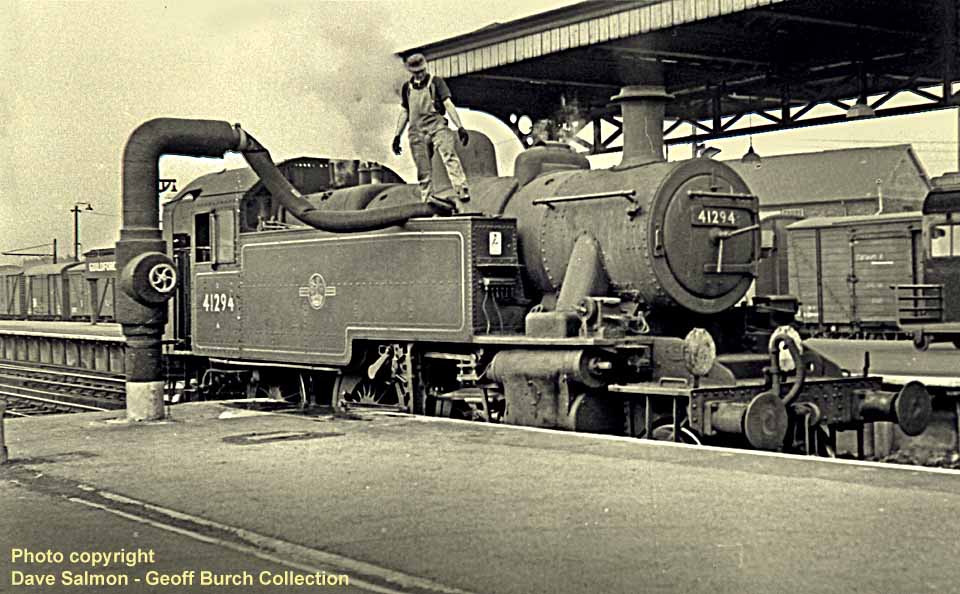
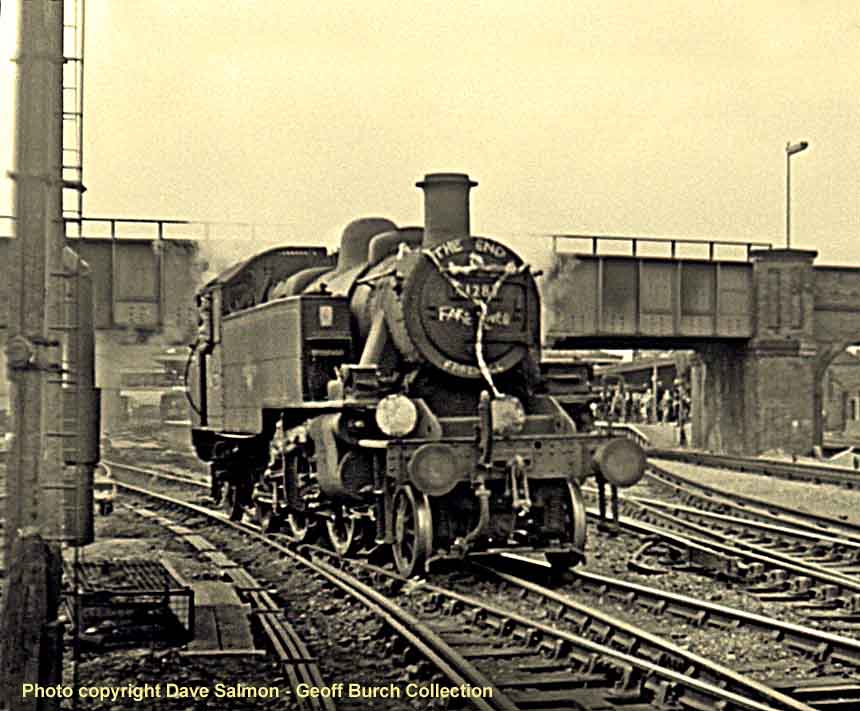
(Above-Below) Ivatt 2-6-2T No 41287 makes her way from Guildford Loco to work the last scheduled passenger service from Guildford to Horsham. 'The End', Farewell' and items of bunting have been attached to mark this sad occasion. (Below) Loco fitter Ernie Pitman and his mate look on as 41287 passes Guildford Loco with the last scheduled passenger service from Guildford to Horsham on Saturday 12th June 1965. If you look closely, a female passenger can be seen in the cab of the locomotive!
(Below) Back in the 1950s, BR trains were predominantly in the hands of steam, even on the Southern Region where third-rail electrification was well to the fore, particularly on London's commuter lines. Constructed at Eastleigh and Nine Elms works between 1897 and 1911, the Drummond Class M7 0-4-4Ts became a popular choice for London's suburban commuter traffic. A total of 105 M7s were built, but by the end of 1963 they were down to just 14, the majority being used on branch line duties in the Bournemouth area. The class was retired in May 1964. Photo © PR Batty.
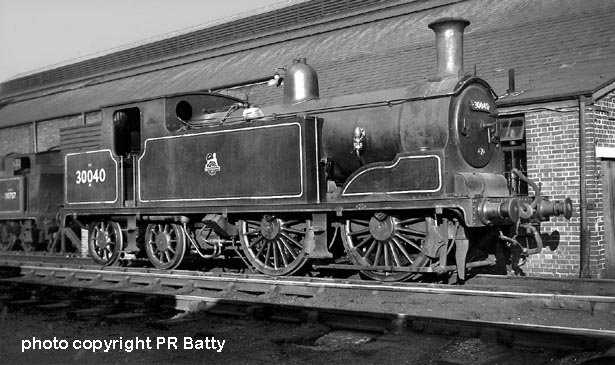
(Below) Designed by RW Urie for the London & South Western Railway in 1918, the 44 members of the 2-cylinder N15 class were named by the Southern Railway after characters and places from Arthurian legend. It was an imaginative naming policy as the Knights of the Round Table are associated with the south-west of England through which the company's London-Salisbury-Exeter line ran. In 1925, REL Maunsell, the SR's CME 1923-1937, began updating the express passenger fleet with some fine locomotives, among them the 'Arthurs' made up of 20 modified Urie N15s Nos 30736-30755. A further 30 locomotives, Nos 30763-30792, followed in 1926, built with modified cabs to meet the Eastern section's loading gauge and most were coupled to 6-wheel bogie tenders. No 30776 Sir Galagars awaits its next turn of duty at Bricklayers Arms in April 1953. Photo © P R Batty.


(Above-Below) This ex-works USA 0-6-0 tank engine No 30067 is a typical American 'Switcher' type for use in heavy dock shunting. The class was built in 1942 for the US Army Transportation Corps and 14 of these e ngines were purchased by the Southern Railway in 1946 for use in Southampton Docks to replace the Adams B4 class 0-4-0Ts. Subsequently numbered 30061-30074 in the BR fleet, the somewhat brutish-looking engines had a stove-pipe chimney, three domes - the centre one carrying the whistle - plus outside cylinders, valve gear, and connecting rods driving the rear axle. The 'USA' tanks did sterling work until the last of the class was replaced by Ruston & Hornsby diesels in July 1967. In the background, the graceful lines of an ex-LSWR 'Greyhound' complete with separate splashers over the wheels and coupling rods makes the USA 0-6-0 look like the ugly sister. The photograph was taken at Eastleigh in September 1957. In direct contrast is the paintwork of 30071 below...
(Above) From 1948, steam locomotives were carrying their new BR numbers with the exception of the Great Western engines which retained their brass and cast iron cabside number plates below 10,000. The 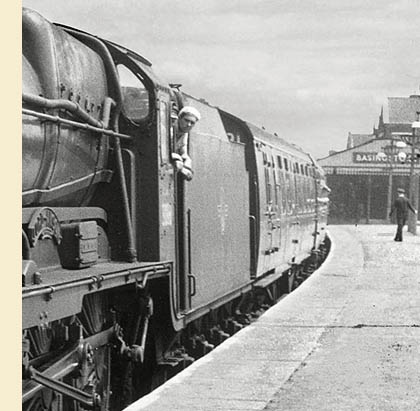 Southern engines were numbered in the 30,000s, the LMSR in the 40,000s and 50,000s, and the LNER engines appeared in the 60,000s. The new renumbering scheme also embraced a small number of diesel locomotives (mostly 0-6-0 shunters belonging to the former LMSR and LNER) which were allocated the numbered series in the 10,000s, while a small quantity of electric and gas turbine locomotives appeared in the 20,000s. Finally, the batch of WD 'Austerity' freight locomotives, built to Ministry of Supply design, and working on loan at the time of nationalisation, were purchased by BR in early 1949 and renumbered in the 90,000s. Fresh from the workshops, BR's recently acquired WD 'Austerity' 2-10-0 No 90766 (one of the original batch of 100 locos built by the North British Locomotive Co, Glasgow, in 1943) has yet to receive British Railways lettering on the tender side at Brighton in 1949. These 'Austerity' 2-10-0s were a development of the earlier WD 2-8-0 locomotives designed by Riddles at the Ministry of Supply for use by the British Army overseas during World War 2. Among the first batch of 100 was No 600 Gordon, which was allocated to the Longmoor Military Railway. The loco was withdrawn in October 1969 following closure of the military establishment.
Southern engines were numbered in the 30,000s, the LMSR in the 40,000s and 50,000s, and the LNER engines appeared in the 60,000s. The new renumbering scheme also embraced a small number of diesel locomotives (mostly 0-6-0 shunters belonging to the former LMSR and LNER) which were allocated the numbered series in the 10,000s, while a small quantity of electric and gas turbine locomotives appeared in the 20,000s. Finally, the batch of WD 'Austerity' freight locomotives, built to Ministry of Supply design, and working on loan at the time of nationalisation, were purchased by BR in early 1949 and renumbered in the 90,000s. Fresh from the workshops, BR's recently acquired WD 'Austerity' 2-10-0 No 90766 (one of the original batch of 100 locos built by the North British Locomotive Co, Glasgow, in 1943) has yet to receive British Railways lettering on the tender side at Brighton in 1949. These 'Austerity' 2-10-0s were a development of the earlier WD 2-8-0 locomotives designed by Riddles at the Ministry of Supply for use by the British Army overseas during World War 2. Among the first batch of 100 was No 600 Gordon, which was allocated to the Longmoor Military Railway. The loco was withdrawn in October 1969 following closure of the military establishment.
(Above-Below) During the first year of British Railways, Bulleid's Merchant Navy Pacific No 35021 New Zealand Line is in the final stages of construction at Eastleigh in September 1948. Rebuilt in June 1959 the loco was withdrawn in August 1965. (Below) Bulleid's light Pacific was essentially a scaled-down version of the earlier 'Merchant Navy' class. The new engines were named after cities, towns and tourist spots in south-west England, hence their 'West Country' origin. Later examples had wartime commemorative names, taken chiefly from RAF squadrons associated with the Battle of Britain. The new Pacifics embodied the same features as the heavier 'Merchant Navy' class, with 'air-smoothed' casing and Bulleid's innovative chain-driven valve gear encased in an oil bath. Eventually a total of 110 were built between 1945 and 1949, including No 34017 Ilfracombe, which is seen here in rebuilt form at Eastleigh in May 1964. The 'West Country' and 'Battle of Britain' class had a wide route availability throughout the SR network and, as a fitting testimony no fewer than 20 have been preserved, nine of them in unrebuilt condition Photo PR Batty.




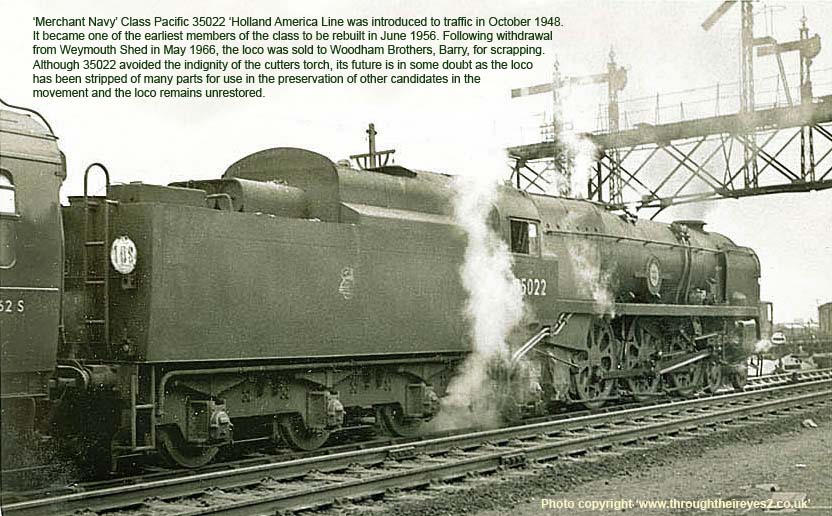
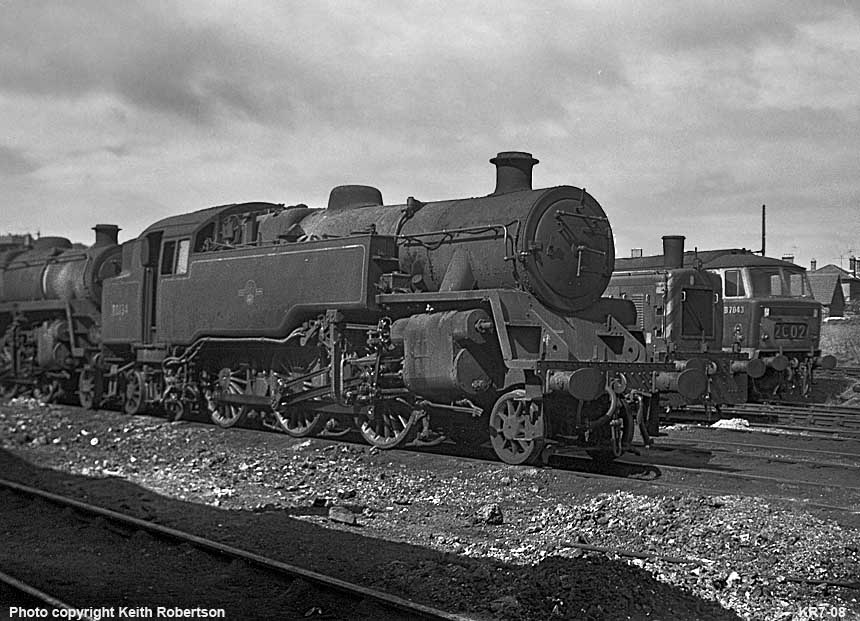
(Above-Below) In 1948, the Railway Executive of the British Transport Commission (BTC) announced its preference for developing future steam power rather than dabbling with new, untried diesel traction. This led to the Locomotive Interchange Trials, supervised by RA Riddles, then member of the BTC's Railway Executive who was responsible for mechanical and electrical engineering. He was assisted by ES Cox, then executive member of the British Transport Commission for design - both ex-LMSR men, who doubtless had in mind their well intentioned plan for evaluating the relative performance of the former 'Big Four' railway companies engines in normal operating conditions. However it came as no great surprise that out of the twelve new BR standard classes (numbered in the 70-80,000s and 92,000s) many designs incorporated the latest features taken from LMSR practice. For example the design of the new Standard Class 4MT 2-6-4T was based on the design of the former LMS Class 4 Stanier and Fairburn 2-6-4Ts. Construction was shared between BR Brighton, Derby and Doncaster Works between 1951-1957. The BR Standard 2-6-4T's were numbered 80000-80154 in the fleet and introduced to traffic for general purpose duties on all the Regions of British Railways except the Western. With the onset of dieselisation gathering pace, however, many of the BR Standard class locos led relatively short lives - the first 2-6-4T to be withdrawn being No 80040 in May 1964 from Exmouth Junction shed. The last eleven locos to be withdrawn included No 80134, seen (above) at Weymouth loco Depot and No 80146 from Bournemouth shed seen (below) along with sister 2-6-4T No 80152 awaiting their fate along with the 'Yankee' 0-6-0T No 30071 in July 1967. Fifteen Standard Class 4 tanks have survived in preservation. 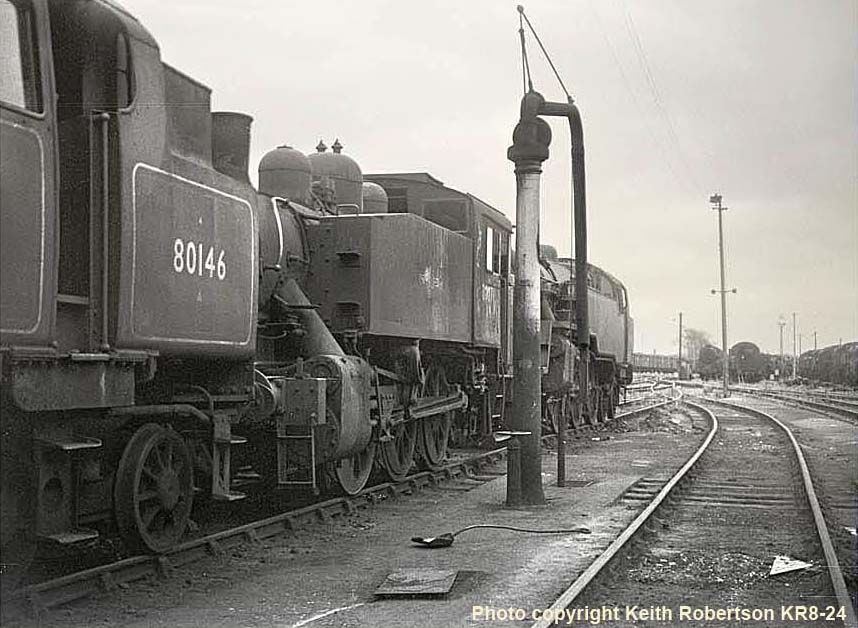

(Above)
(Above-Below) Although the BR Standard 7MT Britannia class was initially allocated to the GE line out of Liverpool Street, three Britannias were transferred to the Southern Region, with No 70009 going to Nine Elms and Nos 70004/70014 going to Stewarts Lane. Out of all the Britannias, however, the best known to the public is No 70004 William Shakespeare, which was displayed at the Festival of Britain exhibition in 1951. Thereafter it was kept in immaculate condition for hauling the 'Golden Arrow' and other boat train services to the continent. 
(Above-Below) Not wishing to incur the wrath of SR fans, but the removal of the air-smooth casing greatly enhanced the looks of the Bulleid Pacifics. Here, rebuilt 'Battle of Britain' class No 34088 213 Squadron is entrusted with hauling the famous cross-Channel London Victoria-Folkestone and Dover 'Golden Arrow' Pullman car train that ran in conjunction with the 'Fleche d'Or' for the Calais-Paris run. By 1972, increased competition from air travel meant that BR couldn't justify the retention of a set of Pullman cars for just one return trip daily from London to the Channel coast and this prestigious service was withdrawn. After the final 'Golden Arrow' ran on 30th September 1972, some of the Pullman cars have since been restored and are now in use in the English portion of the 'Venice-Simplon Orient Express'. (Below) To visit two new pages of BR Southern Region enginemens' memories click on links below...
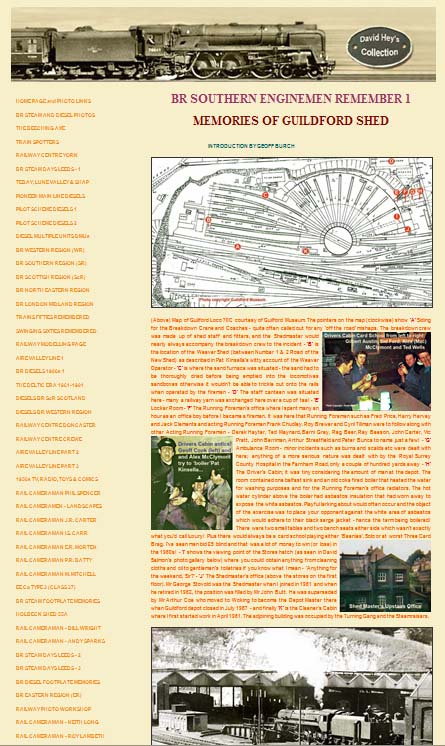
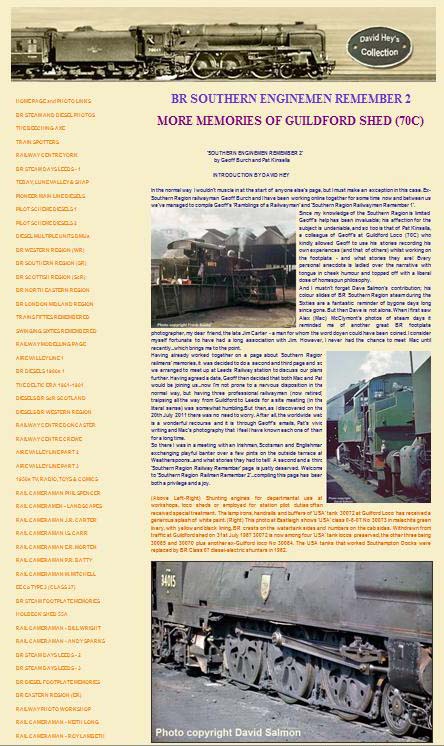
(Above-Below) By way of a change here are two less well known locomotive classes inherited by the Southern Region - Class C2X 0-6-0 2F No 32438, one of Marsh's rebuilds of RJ Billington's earlier C2 class goods engines introduced by the LBSCR in 1908; this was among the locos that had two domes of identical shape-size fitted, the one next to the chimney being used in connection with the feed water heating. (Below) The more powerful 6F 'W' Class mixed-traffic 2-6-4T No 31921 introduced in 1931; this class was developed by Maunsell from his 1922 'N1' class, which were themselves a development of the 1917 'N' class of the old South Eastern and Chatham Railway introduced in 1931; a distinctive feature of the class was the cut-out in the side tanks to clear the valve gear and the prominent steps to the running plate. Some of the original steam loco photos featured on this page were provided by 'Through their eyes.org.uk' and are available on a DVD containing 2,800scans produced from original negatives, slides and photos. Click here for link to this interesting site. I am not affiliated in any way with the sale of DVDs

PHOTO-LINKS TO RAILWAY PRESERVATION SITES I HAVE ENJOYED VISITING
 | 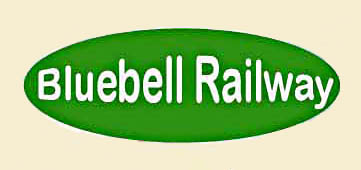 |
Polite notice: All text and photographs are protected by copyright and reproduction is prohibited without the prior consent of the © owners. If you wish to discuss using the contents of this page the email address is below. Please note - this is not a 'clickable' mail-to link via Outlook Express. You will have to email manually.
dheycollection@ntlworld.com



